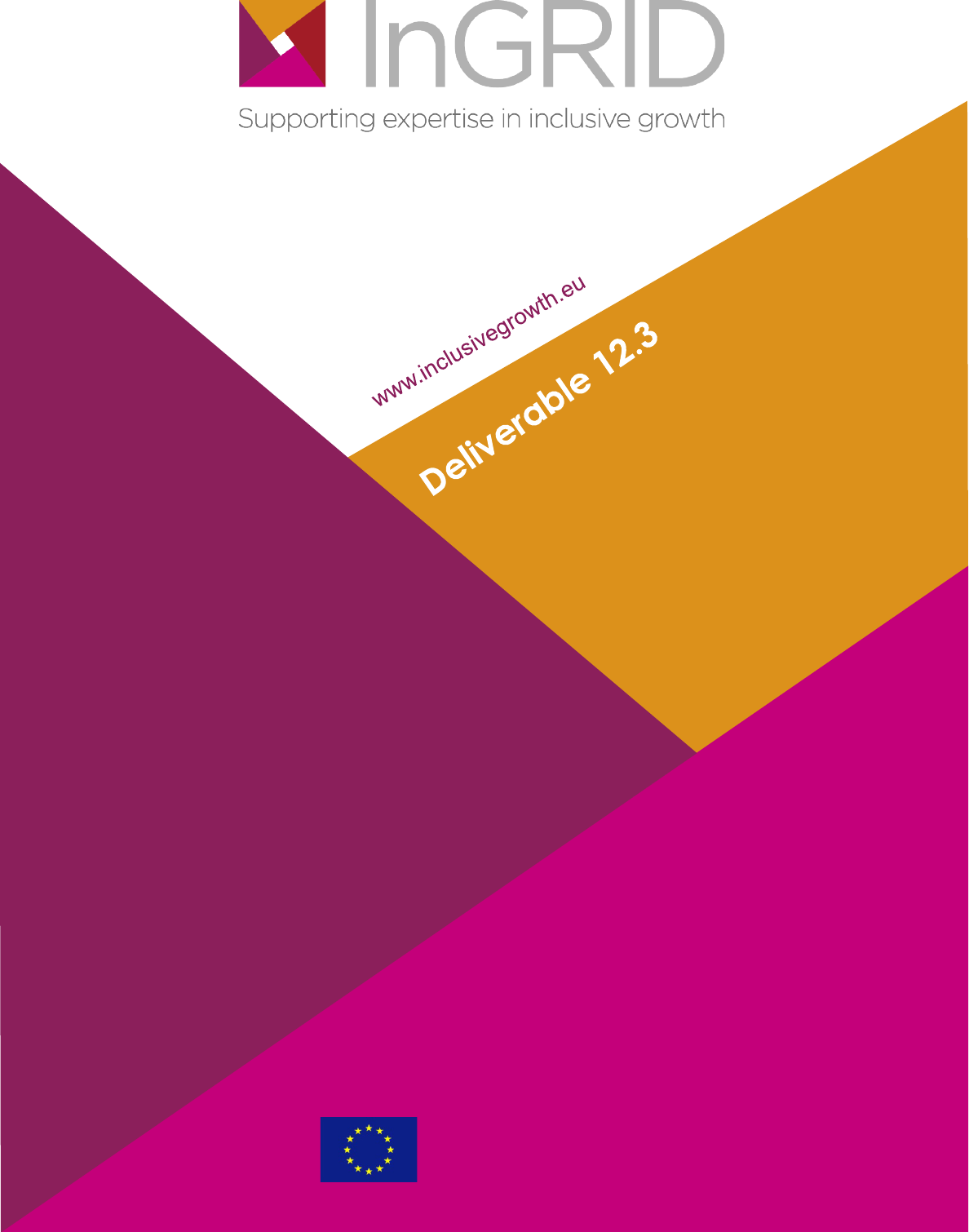
This project has received funding from the European Union’s
Horizon 2020 research and innovation programme under
Grant Agreement No 730998
STATE-OF-THE-ART
Data on the platform economy
Zachary Kilhoffer
April 2021

This report constitutes Deliverable 12.3, for Work Package 12 of the InGRID-2 project.
April 2021
© 2021 – InGRID-2, Integrating Research Infrastructure for European expertise on Inclusive Growth from data
to policy – project number 730998
General contact: [email protected]
p.a. InGRID
HIVA - Research Institute for Work and Society
Parkstraat 47 box 5300, 3000 LEUVEN, Belgium
For more information zachary.kil[email protected]
Please refer to this publication as follows:
Kilhoffer, Z. (2021). State-of-the art. Data on the platform economy, Deliverable n°12.3, Leuven, InGRID-2
project 730998 – H2020
Information may be quoted provided the source is stated accurately and clearly.
This publication is also available via http://www.inclusivegrowth.eu
This publication is part of the InGRID-2 project, this project has received funding from the European Union’s
Horizon 2020 research and innovation programme under Grant Agreement No 730998.
The information and views set out in this paper are those of the author(s) and do not necessarily reflect the
official opinion of the European Union. Neither the European Union institutions and bodies nor any person
acting on their behalf may be held responsible for the use which may be made of the information contained
therein.
Abstract
Platform work is paid labour intermediated by online labour platforms (OLPs) like Uber, Deliveroo, Upwork,
and Amazon Mechanical Turk. This report attempts to map the most relevant measurements and
methodologies used to estimate the size and relevance of platform work, and suggest potential avenues
for future research. I first discuss the terminology of platform work, arguing that a more inclusive
understanding is important. While platforms like YouTube and Etsy are not OLPs per se, they clearly allow
the intermediation of paid work. Platform work will continue evolving, and researchers should not preclude
the possibility that new types of platform work deserve our attention. Second, I discuss the primary ways we
understand the size and relevance of platform work: (1) survey data, and (2) administrative and big data.
Survey data is found to be especially relevant for measuring worker sentiment. However, generalising
findings to the broader population (e.g. to estimate total platform workers) is very difficult, and researchers
must pay special attention to survey mode to correct for sample bias. Administrative and big data are very
promising for large-scale analyses and seem particularly valuable for informing evidence-based
policymaking. Nevertheless, general reliability issues with big data apply, and accessing useful data usually
requires cooperative agreements (e.g. with platforms, financial institutions, or government bodies).Third, I
discuss two prominent works from Huws et al. (2017; 2019) and the COLLEEM surveys (Pesole et al., 2018;
Brancati et al., 2019). Both are highly influential in the literature for estimating the number of platform workers
in Europe and their activity. However, their conclusions are starkly different. I highlight the reasons why the
COLLEEM survey’s more modest estimates are more sound. At EU-level and for individual Member States, I
conclude that policymakers should consider requiring platforms to provide administrative data to ensure
conformity with regulations and better socio-economic insights.

3
Contents
1. Introduction 4
2. The terminology of platform work 5
3. Overview of data types 11
3.1 Survey data 11
3.1.1 Official economic statistics 12
3.1.2 Unofficial economic statistics 12
3.2 Administrative and big data 13
3.2.1 Government sources 15
3.2.2 Platform sources 15
3.2.3 Other administrative and big data sources 17
4. Divergence in size estimates of platform economy 20
5. Conclusions 25
References 41

4
1. Introduction
Platform work was already growing, but since the COVID-19 epidemic, some sectors are positively
booming. With restaurants shutdown or at limited capacity, more people are relying on couriers to
deliver them meals. A huge fraction of the labour force is working from home or out of work,
bringing alternative working arrangements into the mainstream. As such, it is an important time to
consider what we do and do not know about platform work.
One narrative welcomes platform work as a flexible work form encouraging innovation, entrepre-
neurship, and social mobility, while disrupting antiquated business models like the taxi industry and
over-reliance on the standard employment relationship.
1
Others see platform work as exploitative,
displacing stable employment with low-paid work without social protections, growing the ‘cybertariat’
class, and entrenching the power of tech giants like Amazon and Uber (Huws, 2014). Some authors
see platformisation or ‘Uberisation’ as the wave of the future, while others dismiss it as a marginal
labour market phenomenon.
Unfortunately, we still lack reliable data and statistics to evidence these narratives. While debate
about platform work has continued for over twelve years,
2
we still struggle to answer even basic
questions about platform workers, such as their share of the labour force. This has hampered policy-
makers’ efforts to apply existing regulatory regimes to platform work, or craft new ones (Kilhoffer et
al., 2020). In the meantime, platform work continues to evolve at a rapid pace; it remains an elusive
topic and exceptionally difficult to pin down.
We lack quality data and statistics on platform work due to a number of theoretical and methodo-
logical factors. The most important theoretical difficulty is that platform work is poorly defined
and means many different things to different people. The primary methodological difficulty is that
traditional methods of gathering labour market data rarely isolate platform work from other forms,
like self-employed, casual work, or occasional work. This is hardly surprising given divergent under-
standings of what constitutes platform work.
This report revisits and highlights some of the main issues with platform work data and statistics.
While not a comprehensive literature review, it attempts to illustrate the theoretical difficulty of plat-
form work and propose a working terminology (2), examine methodological challenges of different
data sources (3), and discuss how these challenges impact two influential estimations (4). Thereafter,
we offer conclusions and recommendations for researchers and policymakers (5). Appendix 1 con-
tains an overview of data sources for reference.
1 Standard employment relationship refers to a full-time employment contract between an employee and a single employer of indefi-
nite duration (Kilhoffer et al., 2020).
2 For example, Amazon Mechanical Turk launched in 2005 and critical scholarship began by 2008 (Silberman, 2017).

5
2. The terminology of platform work
The primary theoretical difficulty with data is that platform work is poorly defined. This is reflected
by the wide range of terms used for identical or similar concepts, such as ‘platform economy’, ‘sharing
economy’, and ‘collaborative economy’ for the larger phenomenon, and ‘gig work’, ‘crowd work’, and
‘cloud work’ for the labour-intensive part thereof.
These terminological differences have important implications on platform worker statistics. For
example, some argue that people selling goods on Etsy or eBay, as well as services via Uber or Freelancer,
qualify as platform workers (Huws et al., 2019). After all, such individuals earn money through an
online platform. In recent years, more people have begun to make a living off streaming and video
platforms like YouTube and Twitch, bringing new types of platforms under additional scrutiny.
Clarifying terminology has only increased in importance given new legislation. On 20 June 2019,
the Platform to Business (P2B) Regulation on promoting fairness and transparency for business users
of online intermediated services was adopted.
3
While not aimed at platform work, the P2B Regulation
introduces rules for ‘online intermediation services’ and ‘business users of online intermediation ser-
vices’, who provide either goods or services. In some cases, the P2B Regulation could have great
relevance for platform workers (Kilhoffer et al., 2020).
It is therefore important to clarify several terms used in this report:
- platform economy;
- platform;
- platform work;
- online labour platform (OLP);
- platform worker.
Starting from the broadest, the platform economy is understood as the totality of digital commercial
platforms. A platform is any digital commercial platform forming part of the platform economy. Plat-
form work means the matching of supply and demand for paid work through a platform.
4
Figure 2
illustrates how platform work (which Schmidt calls digital labour) are a subset of the larger platform
economy. The particular platforms of interest to this report are Online Labour Platforms (OLPs), which
are those platforms through which platform work takes place.
5
Finally, a platform worker is any
natural person providing paid work through OLPs.
6
This conceptualisation of platform work versus
standard work
7
is presented in Figure 1.
3 Regulation (EU) 2019/1150 of the European Parliament and of the Council of 20 June 2019 on promoting fairness and transparency
for business users of online intermediation services (OJ L186/57 11.07.2019).
4 Adapted from Eurofound (2018).
5 The term OLP is taken from Oxford Internet Institute publications such as Kässi and Lehdonvirta (2018). It avoids awkward constructions
like ‘platform work platforms’.
6 While the term worker has different legal meanings, such as in EU treaties and UK labour law, I do not assign any legal significance to
the term. The word ‘worker’ in the term ‘platform worker’ simply means anyone who performs paid work.
7 Standard employment or standard work refers to a full-time, open-ended employment contract with one employer. Employees per-
form their services under the subordination of the employer, but have no direct contractual relationship with the client (Kilhoffer et
al., 2020).
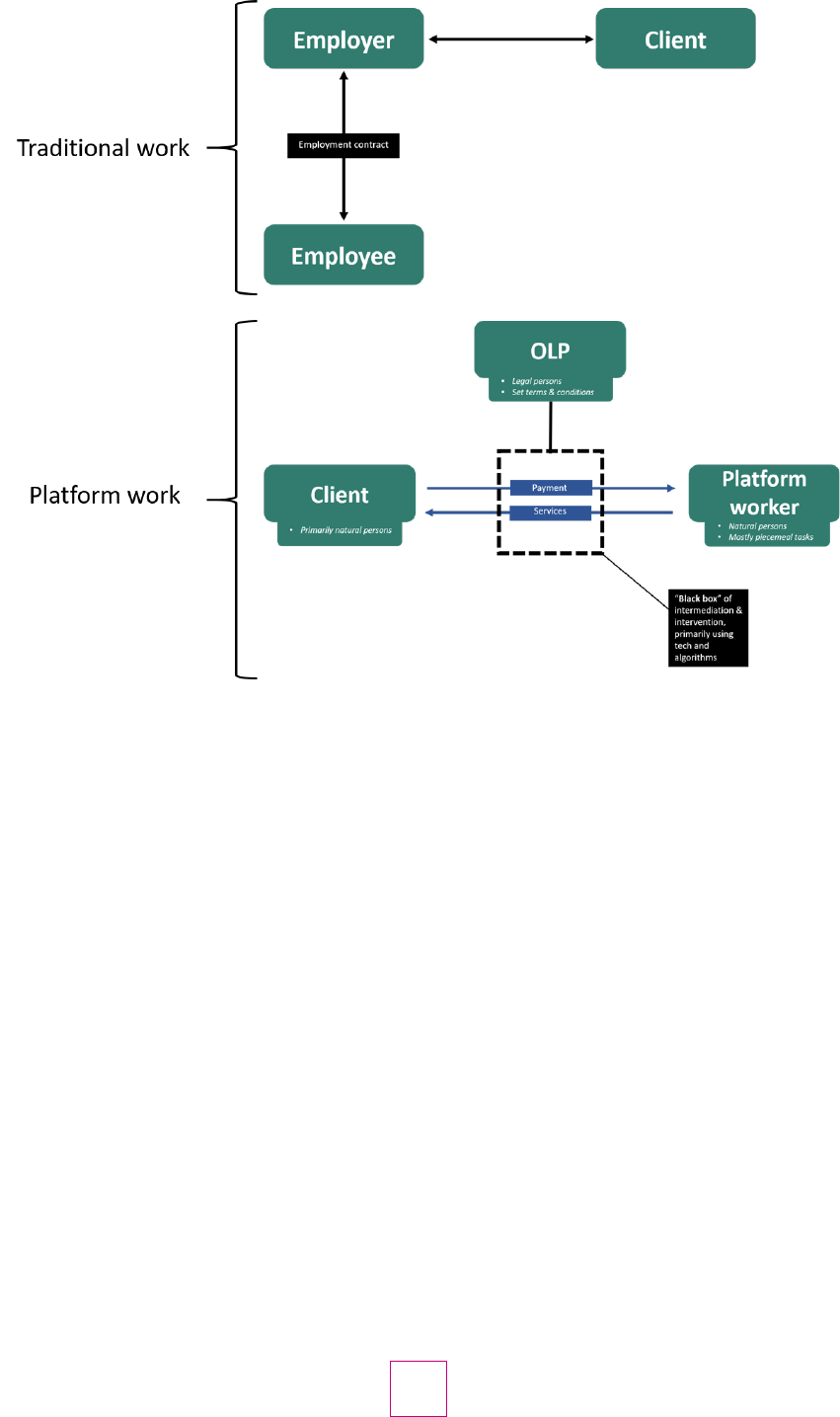
6
Figure 1. Platform work and standard work conceptualisations
N
ote: A platform worker may have an employment contract (as in certain platforms like Hilfr and Foodora),
but overwhelmingly do not, and instead act as independent contractors, solo self-employed, or similar
arrangements depending on national legal context (Kilhoffer et al., 2020).
Source Author’s own elaboration, adapted from Kilhoffer et al. (2020)
With that, we can explore the messier question of what does and does not qualify as platform
work. In principle, any type of labour can be intermediated through an online platform. However,
certain tasks have taken off more quickly and at larger scale. These include a range of tasks per-
formed on-location, such as leisure and hospitality services, personal transport (taxi) services,
delivery of goods, delivery of food from restaurants, and a variety of services in the home, such as
housekeeping, ‘handyman’ services, and many more. While most platforms specialise in one or a few
types of services, some are much broader. For example, ListMinut offers massage, tutoring, and
beauty services, alongside cleaning, furniture assembly, gardening, etc.
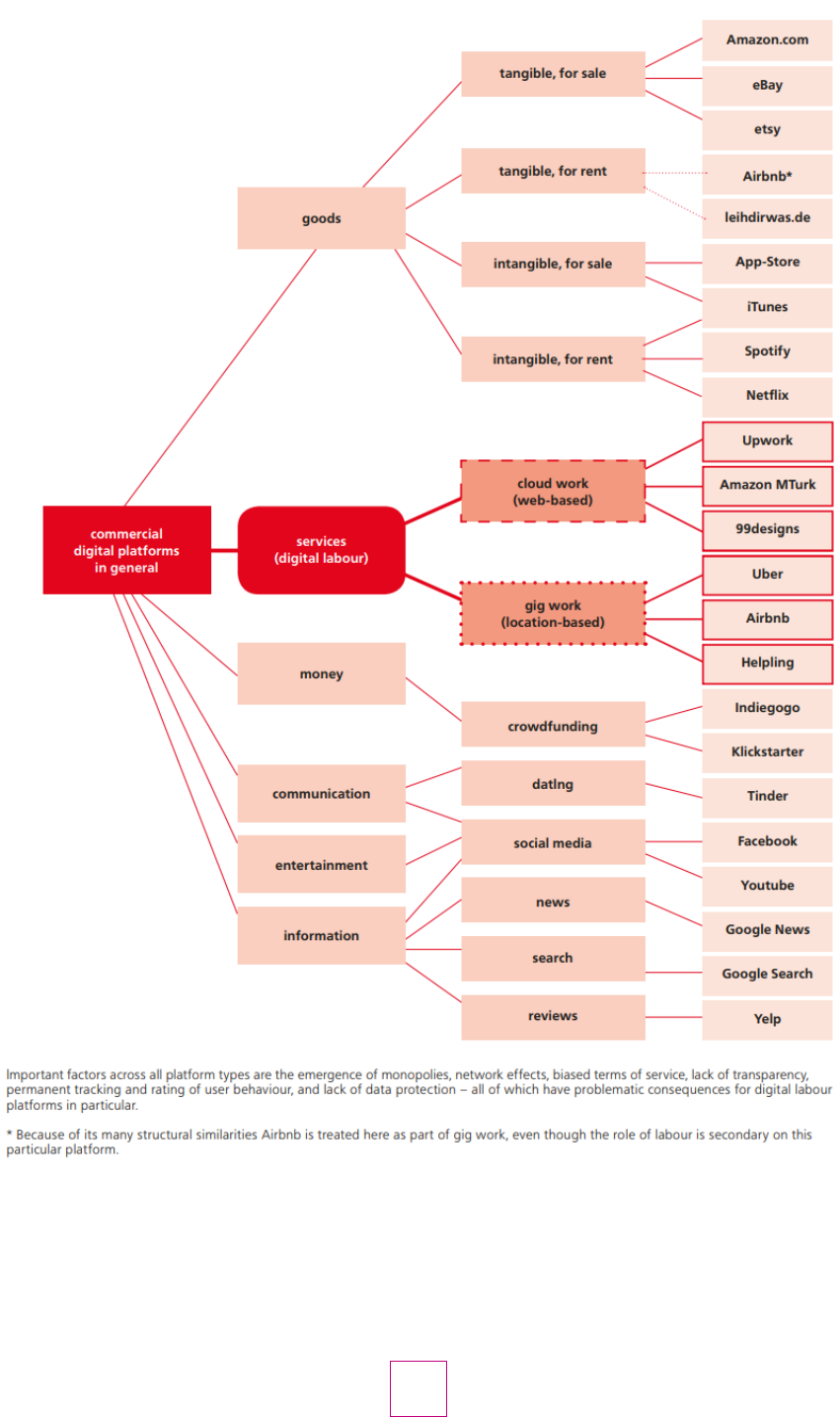
7
Figure 2. Schmidt's categorisation of digital labour markets
So
urce Schmidt (2017: p. 6)
The tasks performed online are similarly diverse. These include clerical tasks (customer services,
data entry, transcription), online professional services (accounting, legal, project management), crea-
tive and multimedia work (animation, graphic design, photo editing), sales and marketing support
(lead generation, social media management, search engine optimisation), software development and

8
technology work (data science, game development, app development), writing and translation (article
writing, copywriting, proofreading, translation), micro tasks (object classification, tagging, content
review, website feedback), and interactive services (lessons and consultations).
8
Some platforms are
specialised towards a subset of these tasks, such as 99designs for creative multimedia work, and
Mighty AI for training autonomous vehicles through micro tasks. Other platforms offer a huge range.
For example, Upwork includes listing for platform workers offering essentially any online task.
Many authors have created typologies of platform work. Some are primarily concerned with the
types of task performed, such as the eleven types of tasks identified by the COLLEEM survey (Bran-
cati et al., 2019; Pesole et al., 2018). Others use factors like where the task is performed (on-location
or online), and the way clients select a platform worker (a specific worker they select, a ‘cloud’ of
potential workers who make offers), and other criteria (Schmidt, 2017; Eurofound, 2018). While these
typologies are useful exercises and have some importance in policy debates, they are not particularly
important for the purpose of this report. What matters for us is not categorising types of platform
work, rather determining if a given type of work counts as platform work. We have already mentioned
a number of OLPs above, and Appendix 1 contains a table with all in this report.
Capital versus labour
A few cases at the margins are also worth specific consideration. Taking AirBnB for example, some
studies consider AirBnB hosts to be platform workers (Schmidt, 2017), whereas others consider
AirBnB a capital and not labour platform, and therefore outside the realm of platform work (Bogliacino
et al., 2020). Those arguing hosts are not platform workers highlight that clients are primarily paying
to rent a piece of property, rather than receive a service.
9
I find this unconvincing for several reasons.
First, AirBnB hosts must work to procure and prepare property for rental, or oversee those they pay
to do so. Second, hosts either perform (or hire out) services like cleaning required to maintain their
property. Third, hosts often interact with their guests, providing advice about their stay, and even
guiding them in tours that AirBnB styles as ‘experiences’.
10
To summarise this argument, the requirement for capital investment does not impact whether or
not services are involved. The prototypical OLP, Uber, certainly requires a large capital investment,
but few would argue that it does not intermediate labour.
11
Similarly, if managing a hotel or rental
properties qualifies as labour, then certainly AirBnB hosts also perform labour, and clients on AirBnB
are purchasing services as well as renting a piece of real estate. Thus, if services are an integral part
of what a platform offers, those providing the services ought to be considered platform
workers, even if the platform does not clearly qualify as an OLP.
Goods versus services
Consider also people who sell goods on e-commerce marketplaces like eBay, Etsy, and Amazon.
Generally, such people would not be considered platform workers because they are selling goods
rather than labour. However, the distinction is not as simple as it might first appear. Consider a digital
artist selling custom designs on Upwork, compared with a carpenter selling custom furniture on Etsy.
The former would almost always be considered a platform worker because they seem to be selling a
service rather than a tangible good. However, the digital artist can take time to make a design (per-
forming labour) without being paid; the client is actually interested in paying for a completed good,
which is the digital image.
The primary difference between the digital artist on Upwork and the carpenter on Etsy is that the
former produces a digital good, while the latter produces a physical good. Otherwise, both individuals
use their labour to produce goods and sell them on a digital platform. Both use a platform to
8 Adapted from Brancati et al. (2019).
9 This is the argument in Bogliacino et al., for example (2020).
10 AirBnB bills these as ‘one-of-a-kind activities hosted by experts’, and can include essentially any type of leisure activity.
11 Although Uber has consistently argued that it merely provides digital intermediation, courts often see otherwise (Kilhoffer et al., 2020).

9
communicate with a client, understand their needs, and work to achieve some specific outcome in
exchange for payment. The conclusion must be either: (1) the digital artist on Upwork is not a
platform worker, because their product is a mixture of service and good rather than uniquely a service;
or (2) the carpenter on Etsy is a platform worker because the good they sell is intrinsically tied to the
provision of service. I find the first conclusion unsatisfactory because it would imply that many
people using OLPs are not platform workers because they are producing digital goods rather than
digital services. If we knew there were 1,000,000 active Upworkers completing an average of one
contract per week, we would be no closer to saying anything about platform work. In reality, the
distinction between goods and services is difficult to determine – especially in digital marketplaces. I
therefore propose that, although Amazon, Etsy, and similar platforms may be better called e-
commerce platforms than OLPs, people earning money through them can rightly be
considered platform workers.
Content creators and influencers
One internet phenomenon has received little attention in the platform work literature: content
production on platforms like YouTube, Twitch, and Instagram. On YouTube, content creators
produce videos and/or stream from a live feed. While the majority of accounts on YouTube do not
earn money, some YouTubers have found a great deal of success earning money from Google
Adsense, affiliate links, merchandising, and donations and subscriptions from third party
memberships like Patreon. With Twitch, the focus is on livestreaming content; usually a streamer
plays videogames while chatting live with their viewers. Twitch streamers earn money through
sponsorships, and from their viewers via one-
off donations and various subscription tiers.
On social media, the term influencer refers to
internet celebrities who have amassed a large
following and often monetised their online
presence. Influencers on Instagram do not
earn any money from the platform or
through the platform directly. However,
through sponsored postings and other mar-
keting strategies, some influencers earn a suc-
cessful living completely from posting on the
platform.
Content creators and influencers further
illustrate the issue with a sharp delineation between goods and services, platforms and OLPs. While
YouTube, Twitch, and Instagram do not primarily function as OLPs, they can clearly be used as such.
Content creators and influencers perform labour for pay using platforms, and as such can be
considered a type of platform worker. Furthermore, initiatives like the YouTubers Union illustrate
that many of the concerns over payment and working conditions are shared for platform workers
and content creators.
12
Teleworkers, homeworkers, and internal crowdsourcing
The final consideration in this section is more traditional workers who may use digital platforms in
the course of their work. Teleworking, homeworking, and internal crowdsourcing are not examples
of platform work. However, they do illustrate how platform work is influencing traditional work.
12 IG Metall, Europe’s largest trade union, has been involved in efforts to unionise platform workers as well as YouTubers. While the
YouTubers Union is not technically a trade union, it is a grassroots campaign to achieve more fair conditions for YouTubers. The group
is demanding greater transparency, a more stable and equitable system of monetisation, and the ability to negotiate with the plat-
form on decisions that impact their livelihoods (Grey Ellis, 2019).

10
Telework refers to (own emphasis):
13
a form of organising and/or performing work, using information technology,
in the context of an employment
contract/relationship
, where work, which could also be performed at the employer’s premises, is carried out
away from those premises on a regular basis.
Telework cannot be a form of platform work because: (1) it is a form of standard work, and; (2) does
not imply any algorithmic intermediation (as per Figure 1).
The legal definition of homework is not consistent across the EU countries, but ILO Convention 177
defines it as (own emphasis):
14
work carried out by a person (i) in his or her home or in other premises of his or her choice, other than the workplace
of the employer; (ii) for remuneration; (iii) which results in a product or service as specified by the employer, irrespective
of who provides the equipment, materials or other inputs used,
unless this person has the degree of
autonomy and of economic independence necessary to be considered an independent
worker
under national laws, regulations or court decisions.
Similar to telework, homework requires a traditional employer with a fixed premises. Furthermore, it
implies direction from an employer, rather than algorithmic intermediation between a worker and
client.
Lastly, internal crowdsourcing is an interesting case. Normally, crowdsourcing means that a client
posts an open call on the internet, where a large group of people can contribute to some goal. It
usually occurs in an external context, meaning companies (or individuals) outsource certain tasks to
independent contractors via an OLP (Leimeister et al., 2009).
IBM and other companies used a digital mechanism to distribute work within their organisation. A
company would post a task, and employees could compete amongst each other, offering different
solutions. The principle is exactly the same as crowdsourcing, except that the crowd consists of
employees within a company rather than independent contractors. As such, internal crowdsourcing
is a novel way to distribute work within the context of a standard employment relationship, but does
not constitute platform work.
Concluding thoughts on terminology
It is not always clear where platform work begins and ends. This is to be expected, given that the
platform economy is new and quickly changing. The lines will continue to blur as platform work
models influence traditional work, and algorithms, ratings, and reviews become a more normalised
part of standard employment.
Because of this, prudence suggests that researchers and policymakers ought not take an overly
narrow view of platform work. The determining factor in many cases is whether an intermediary,
typically an algorithm, makes decisions to connect the supply and demand for paid work. When this
is the case, many foundational concerns related to fairness and working conditions are essentially the
same, whether the platform is Uber, Upwork, YouTube, or anything else.
13 Article 2 of the European Framework Agreement on Telework of 2002, cited from Eurofound.
14 Cited from Eurofound.

11
3. Overview of data types
Most labour market data come from national labour surveys and administrative reporting. However,
data on platform work are not or cannot be gathered in most of the ways that other forms of work
can be (Kilhoffer et al., 2020). Official labour market statistics are therefore inadequate to say very
much about platform work (Riso, 2019).
15
In spite of difficulties in access, many researchers have found ways to gather data and statistics on
the platform economy and used them in novel ways. Many have compensated for data shortcomings
with mixed method approaches.
16
This section presents a brief overview of the most-used data types
in the platform work literature, as well as considerations for researchers.
3.1 Survey data
Survey data is gathered from a sample of respondents who take a survey, typically through phone or
internet. Official labour market data are collected periodically through national or EU-level labour
force surveys. Because surveys are the traditional source of high-quality labour market data, research-
ers have extensively deployed surveys in an attempt to understand platform work.
However, using survey data to assess platform work presents a number of challenges. First,
platform workers are a relatively small demographic, and reaching sufficient numbers for a repre-
sentative sample can be difficult. For example, a number of surveys on platform work in Germany
have relatively small sample sizes, which are unlikely to provide representative results (Serfling, 2018).
One common way of increasing sample size is to pay participants, but this creates a coverage bias, as:
(1) people completing surveys online have access to and familiarity with computers and the internet
more than the general population, and are therefore more likely to do platform work; and (2) com-
pleting surveys for pay is itself a form of platform work.
Second, ‘platform worker’ is an ill-defined term to begin with, and surveys may struggle to com-
municate the idea to participants. Rather than asking participants questions like ‘Are you a platform
worker?’, or ‘Have you done work via digital platforms?’, which are likely to be misunderstood, many
surveys identify certain dimensions of platform work and allow cross-tabulation of variables (Huws
et al., 2017).
17
Still, this introduces new challenges in how to cross-tabulate data for a given research
question (i.e. how many platform workers are there?), and measurement bias can be a significant
problem. The mode of the survey impacts the accuracy of responses, which is especially important
when surveys are complex, and for potentially comparing different survey results (Riso, 2019).
Third, and similar to the former point, studies use different conceptualisations of platform
work than the present report. Some focus on only a few times of labour, such as micro-tasking (Berg,
2016), a specific platform like Uber (Hall & Krueger, 2018; ORB International, 2017), while others
look to any type of work with electronic mediation (US Bureau of Labor Statistics, 2018). Again, the
conceptual complexity of platform work impacts the data quality.
15 However, note that relevant ministries in number of countries including the Canada, Denmark, Finland, France, the UK, and the US
have added questions relevant to platform work to labour force surveys, or released dedicated ad-hoc modules.
16 Mixed methods use a combination of other methodologies to help verify findings and mitigate shortcomings. In studying platform
work, researchers might combine quantitative methods with surveys, administrative data, and big data, and qualitative methodolo-
gies such as focus groups and in-depth interviews.
17 The variables identify dimensions key to a typology.

12
Fourth, many studies provide little information about the extent to which they cover the target
population (Riso, 2019). This makes it difficult or impossible to know if the results can be generalised
to the total population, and if studies are comparable to one another.
Due to these difficulties, the methodologies of surveys require extra careful consideration. Methods
such as verifying online results with phone surveys, or triangulating methodologies, are a few potential
options, but by no means guarantee a solution to coverage and measurement biases (Riso, 2019).
Official economic statistics
Official economic statistics are understood as those collected directly by national statistical offices or
government departments (Riso, 2019). They tend to be easier for researchers to access than other
sources.
At EU level, Eurostat has increased efforts to gather data on the platform economy, such as
through the 2017 Community survey on ICT usage in households and by individuals. While not
aimed at platform work per se, it did collect data on the share of people in the EU arranging accom-
modation and personal transport online via websites or apps from another individual.
18
At national level, a handful of European countries have used surveys to gather data relevant to
platform work. For example, in 2017 the UK introduced a module to its Opinions and Lifestyle
Survey, which is conducted using computer-assisted telephone interviews. The module includes ques-
tions about the use of intermediary websites or apps to arrange accommodation or transport, and
using the internet for social networking and online shopping (Office for National Statistics, 2017).
Statistics Netherlands also began gathering data, asking individuals about ICT-usage including
AirBnB and Uber-like platforms (Heerschap et al., 2018). Statistics Netherlands also surveys enter-
prises on the perceived impact of online platforms on their turnover.
In Finland and Denmark, the national statistical agencies sampled nationals in 2017 to estimate
how many people earn money from digital platforms. For both countries, the modules asked
respondents about specific platforms, and therefore do not represent all platform workers (Riso,
2019). In France, the labour force survey of 2017 asked self-employed respondents whether they
accessed clients exclusively or not through a digital intermediary or more traditional business inter-
mediary (Arnault et al., 2018). However, the question was formulated such that ‘digital platform’ is
open to interpretation.
Unofficial economic statistics
Unofficial statistics are those commissioned to third parties or carried out by and on the initiative of
private organisations. Absent official statistics on platform work, more of these are available at EU
level and for individual Member States, but the data is not necessarily available for public use.
A notable early example is the Eurobarometer Flash Survey 438, which investigated the (now dated
terms) ‘collaborative economy’ and ‘collaborative platforms’. The survey asked about renting accom-
modation, car sharing, and small household jobs, alongside usage of search engine, social networks,
and online marketplaces (European Commission, 2016). Additional surveys covering the EU or
subsets for different types of platform work include that by VVA, Milieu and GFK for DG Just
(Hausemer et al., 2017), PWC (2018), and McKinsey Global Institute (2016). The ILO further com-
missioned a survey of platform workers who use CrowdFlower and Amazon Mechanical Turk (Berg,
2016). Finally, Huws et al. (2017) and Pesole et al. (2018) both conducted ambitious surveys spanning
a number of EU countries. The latter two reports are discussed in more detail in the section Diver-
gence in size estimates of platform economy.
18 See here.

13
At national level, the UK, France, Norway and Germany have all commissioned research towards
understanding platform work, though the UK and Germany seem to be the most active due to higher
scrutiny about labour platforms.
Looking to Norway, an initial internet survey sampling 1,525 Norwegian adults found that some
10% of respondents indicated they had done platform work at some point, and 2% on a weekly basis
(Jesnes et al., 2016). However, this study had significant error margins. A subsequent survey carried
out by phone, with more carefully worded questions, resulted in more conservative estimates (Alsos
et al., 2017). This indicates further evidence that we should treat internet surveys with caution, and
the wording of questions has large implications for estimations.
Community initiatives have also contributed to our understanding of platform work, primarily in
to gauge working conditions and fairness in OLPs. For example, FairCrowdWork is a sort of
watchdog organisation run by German trade union IG Metall, a number of social partners, and
partner platforms. Among other activities, FairCrowdWork collected and compiled data from
platform workers about the OLPs they have used. It then created a rating overview of OLPs based
on the fairness and desirability of working through them. Additionally, FairCrowdWork conducted a
2016 survey of workers on six German platforms, carried out in collaboration with the platform
operators, which revealed that workers found fair payment by far the most important principle.
Therefore, this principle was ‘clarified and strengthened as much as possible given the platforms’
current business models and economic circumstances’ in the current Code of Conduct, which a
number of platforms abide by.
19
Recommended readings using survey data include:
- Huws et al. (2017);
- Pesole et al. (2018);
- Brancati et al. (2019).
3.2 Administrative and big data
Administrative and big data represent a diverse assortment of data sources. They have been important
resources for platform work research due to the challenges with surveys and traditional labour data.
Sources that have been used in the context of platform work include bank transactions (Harris &
Krueger, 2015), API calls or webscraping the platforms themselves (Kässi & Lehdonvirta, 2018), and
Google trends data (De Groen et al., 2017).
Administrative data are collected by governments or other organisations, primarily not for research
purposes, but to provide overviews on registration, transactions and record keeping. Administrative
data are very diverse, accounting for usership data from platforms, bank transfer data, tax records,
and much more.
Administrative data may have certain advantages, such as avoiding measurement biases found in
many surveys. On the other hand, administrative data on platform work is often lacking. Sources like
tax statements may not accurately reflect earnings from platform work, which often go unreported.
Furthermore, administrative data are rarely available to the general public, limiting their use to those
with insider access. Platforms regard proprietary data as an important part of their competitive
advantage and tend to keep them confidential (Fabo et al., 2017).
Big data refer to extremely large data sets whose size precludes traditional processing, but can be
mined for information. In many cases this requires newly-developed techniques in machine learning.
Due to the digital nature of platform work, big data is a promising resource to understand the
19 See here.

14
platform economy. At present, national statistical offices in Canada, the UK, and Italy are using or
considering big data to study platform work (Riso, 2019).
However, big data can suffer from a number of shortcomings. Crawford cautions that big data
have intrinsic biases because ‘data and data sets are not objective; they are creations of human design’
(2013: p. 1). Big data are often low quality, necessitating extensive quality checks prior to serious
analysis (Dasgupta, 2013). Furthermore, and similar to surveys, big data frequently suffer from poor
representativeness, which makes it difficult for researchers to generalise findings (Lenaerts et al.,
2016). Big data are not necessarily reliable and comparable over time, and lastly, big data is subject to
regulatory constraints (Boyd & Crawford, 2012). The extent of these challenges very much depends
on the particular data, and what we are asking of the data.
Big data can be acquired in several ways, primarily via application programming interfaces (APIs),
webscraping, webcrawling, and voluntary data sharing. APIs are common on many types of websites
and facilitate functions like retrieving data and posting data. APIs allow structured requests for data,
which is usually returned in a format like JSON for easy analysis (Dewi et al., 2019). While some APIs
do not require registering an account, most public APIs require an access key acquired after
submitting an application and agreeing to abide by the website’s terms of services (TOS).
20
This
means that, provided researchers are approved and follow the TOS, they do not risk legal challenges
with the website. Sometimes these conditions are problematic for researchers, as APIs may explicitly
forbid, for example, creating a database of retrieved data. While some APIs are completely free,
websites also monetise them by charging for API access. Often the free versions of APIs have
restrictive rate limiting, which means retrieving a large volume of data requires spacing out requests
over time. This can be problematic for researchers interested in acquiring comprehensive data or
analysing trends over time. Depending on the volume of data needed, Russel and Klassen recommend
considering third party data vendors (2019). These can be expensive, but may be the only practical
way to acquire certain bulk data (Kilhoffer, 2020). Key benefits with using APIs include ease of use
and the possibility of acquiring real-time data.
Webscraping is a means of gathering data from websites, typically making use of automated tools
developed with programming languages to extract data from webpages (Dewi et al., 2019). Some
websites are very open to be scraped, as it can help them increase their traffic. For example, search
engines rely on webscraping or webcrawling to index the internet and show relevant results for search
queries. Many websites, however, explicitly forbid webscraping. This creates ethical (e.g. privacy) and
legal obstacles for researchers (vanden Broucke & Baesens, 2018). In principle, anything that can be
viewed online can be webscraped using a variety of techniques. Unstructured text, structured data,
images, and anything else contained on a website can be retrieved (Kilhoffer, 2020). Webscraping can
be considered something of a last resort to gather data when other methods are not feasible.
Webcrawling is similar to webscraping, however it systematically browses one or more websites,
typically for the purpose of indexing. Whereas webscraping tends to retrieve pre-defined data from a
specific website, a webcrawler will recursively browse a site, any hyperlinks it finds, and index (store
in a database) all that it finds. Karanovic et al. used webcrawlers to collect over 120,000 blog posts
from uberpeople.net - the most popular forum for Uber drivers - and assess the content of the
unstructured text with natural language processing techniques (2017). Numerous studies have used
webcrawlers to study AirBnB rental markets.
21
Voluntary data sharing is when internet services collaborate with external researchers, providing
data on a limited basis, free of charge, for specific research projects (Kilhoffer, 2020). This type of
20 Essentially a string functioning as a password.
21 See for example Edelman and Luca (2014), Teubner et al. (2017), and Zervas et al. (2015), which webcrawled AirBnB and analysed
price, rating, etc.

15
data acquisition is generally unproblematic legally, though it is limited to what internet services are
willing to share and for what purposes.
Government sources
Governments have access to certain administrative data, and a number of efforts to gather and
analyse administrative data are underway. These are often closely linked to tax records, as
governments have been concerned about the potential for undeclared earnings from platform work
(Lenaerts et al., 2017).
In France, since the introduction of the Finance Bill 2016, all platforms are required to provide an
annual earnings statement to platform workers in order to facilitate their tax returns. In Estonia, the
tax authorities are working with OLPs to develop a system whereby tax is withheld directly via the
platform to facilitate income tax collection. For example, Uber drivers are allowed to opt-in to a
system where Uber sends drivers' income data to the tax office, so it is automatically added to their
tax return. Furthermore, since 2016 Belgium has had a favourable tax regime for platform workers,
but only for selected platforms. In order for platform workers to benefit from this tax regime,
platforms must require certain basic information data (i.e. proof of no bankruptcy) (Eurofound,
2018).
In the UK, the ONS is considering analysis on tax returns (Beck et al., 2017), while in Norway, the
Fafo Institute for Applied Social Science collected tax data from the Norwegian Tax Administration
about UberPop drivers (Alsos et al., 2018). Finally, in Italy, the Italian National Institute for Public
Policy Analysis INAPP collected economic and employment information on platform businesses
from business registers and administrative data sources (Guarascio & Sacchi, 2018).
One takeaway is that governments can cooperate with OLPs to collect data on taxable earnings.
This can help mitigate undeclared earnings from platform work, ease administrative burdens for
platform workers, and generate data of use to social scientists. Depending on the arrangement,
cooperation between governments and OLPs may also allow external researchers access to useful
data, but no examples of this were found.
Platform sources
Platforms often release certain administrative data describing the number of services provided in a
certain timeframe, workers signed up, etc. This is often for promotional purposes. Additionally,
publicly listed platforms are typically required to release detailed information on revenues, profits,
and so on in their country of registration.
Platforms are certainly well placed to provide data on their users, however, in many cases these
data must be treated with scepticism. As noted in Fabo et al. (2017), platforms have an incentive to
misrepresent the number of platform workers to appear as large and relevant as possible, thereby
attracting more workers, customers, and investment. Furthermore, platforms often provide figures
of limited value, such as the total number of individuals subscribed as service providers, which is
much larger and much less relevant than the number of individuals consistently working through a
platform.
In a number of cases, platforms have published or commissioned studies based on their internal
administrative data and surveys. For example, Etsy released an economic impact study built on an
online interview of 2,658 Etsy sellers from 24 April to 14 May 2018, primarily answering how the
platform’s sellers contribute to the US economy. Etsy indicated that sellers contribute $4.7 billion
annually to the US economy, including $1 billion for themselves, and $850 million in wages and
income for US workers in other segments of the economy.
22
Additional findings confirmed Etsy’s
22 See Guta (2018). The link to Etsy’s actual report is broken as of 28 October 2020.

16
outsized role for women, who represented some 86% of sellers on the platform in 2015 (Fortune,
2015). Unfortunately, the report seems to have been taken offline, so it is difficult to say more about
the methodology and findings.
One influential paper is based on a survey commissioned by Uber combined with administrative
data (Hall & Krueger, 2018), which has appeared in US Congressional committee hearings, a Federal
Trade Commission’s workshop on the sharing economy, and other policy venues (Berg & Johnston,
2019). The report paints Uber in a flattering light, finding that 81% of Uber drivers are very satisfied
or somewhat satisfied, and earn from $18.75-19.41 per hour: far higher than the average for taxi
drivers and chauffeurs. It also estimates that Uber drivers should safely earn more than taxi drivers
and chauffeurs even accounting for expenses. However, Berg and Johnston have strongly criticised
the results (2019). Problems included non-response bias (10% response rate), missing questions
(average number of hours driven for Uber per week), posing leading questions, improper scaling of
job satisfaction questions, misinterpretation of job satisfaction results, and so on.
Other platforms, such as BlaBlaCar and AirBnB, have published reports with different research
focuses from revenues to environmental impacts. However, methodologies are often unclear, and
most of the time data is not available for reproduction (Riso, 2019). The takeaway should be that
reports commissioned by the platforms themselves are often undertaken for promotional purposes
and should be viewed with scepticism.
One particularly good use of data from platform sources is from the Oxford Internet Institute,
which set up the Online Labour Index (OLI). The OLI tracks all tasks posted to the five largest
English-language OLPs,
23
representing at least 60% of the market by traffic. The Oxford Internet
Institute has reached an agreement with these platforms to gather data through API calls or
periodically webcrawling vacancies. The result is an easy-to-use tool to view supply of tasks by
country, time period, type of occupation, and growth trends (Kässi & Lehdonvirta, 2018). For
example, the OLI generally indicates overall growth around 25% annually, however Figure 3 shows
a slump in demand associated with the COVID-19 pandemic. The OLI illustrates the value of big
data provided in near real-time.
23 As indicated by unique monthly visitor estimates from Alexa.
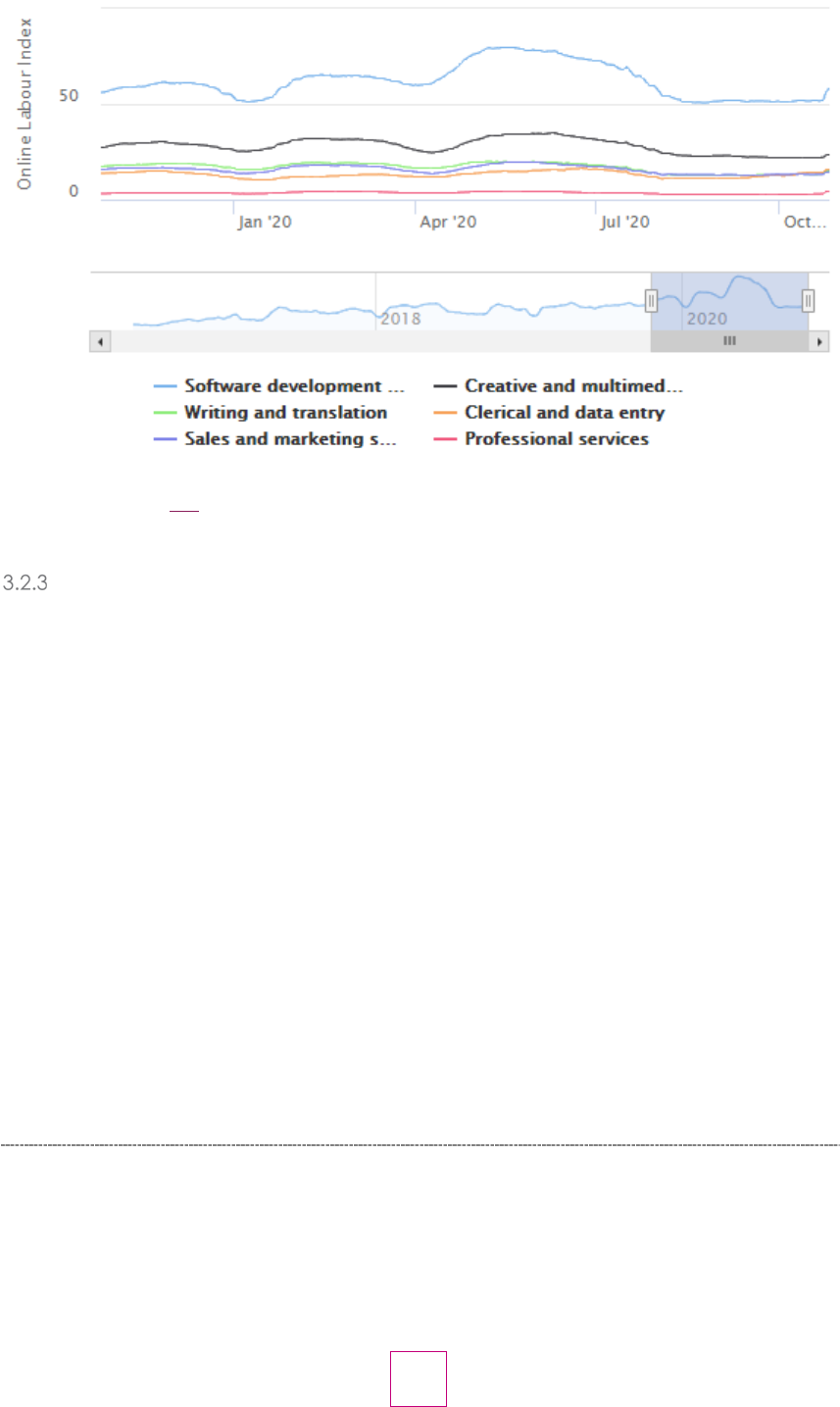
17
Figure 3. Screenshot from OLI - Demand for online labour by occupation
Note: 28-day moving average used. Dates shown are 25 October 2019 – 26 October 2020. Screenshot made
26 October 2020.
Source OLI
Other administrative and big data sources
Additional administrative and big data comes from sources like financial institutions. For example, a
few notable papers used proprietary data on JP Morgan Chase’s American customers’ bank account
transactions. These studies attempt to estimate participation in the platform economy, defined as
labour platforms (like Uber) and capital platforms (like AirBnB). The earlier of these reports (Farrell
and Greig, 2016) estimates participation rates based on only 30 platforms, and the data are skewed
towards older bank account holders. In a follow-up, Farrell et al. (2018) used a new sampling method
24
on 39 million anonymised bank accounts over a 66-month period from October 2012 to March 2018,
and 128 platforms in further disaggregated sectors.
25
Riso considers these results robust, reliable, and
repeatable,
26
but notes that such analysis is only possible for banks which own the data (2019).
24 In the earlier study (Farrell and Greig, 2016), checking accounts were only analysed if they existed for all 36 months between October
2012 and September 2015, and had at least five outflow transactions per month. This dropped the sample from 28 million checking
account customers to 6 million. In the latter study (Farrell et al., 2018), the unit of analysis was the ‘account-month’, where the only
inclusion criterion was at least five outflows from October 2012 to March 2018. This allowed analysis of more accounts, which is
important because customers open, close, and modify the accounts they use.
25 The four sectors were transportation, non-transport work (essentially on-location platform work excluding transport), selling (essentially
e-commerce), and leasing (renting homes, parking spaces, or other assets).
26 For example, Farell et al.’s (2018) estimates are extremely close to those from the US Bureau of Labor Statistics (National Academies
of Sciences and Medicine, 2020).
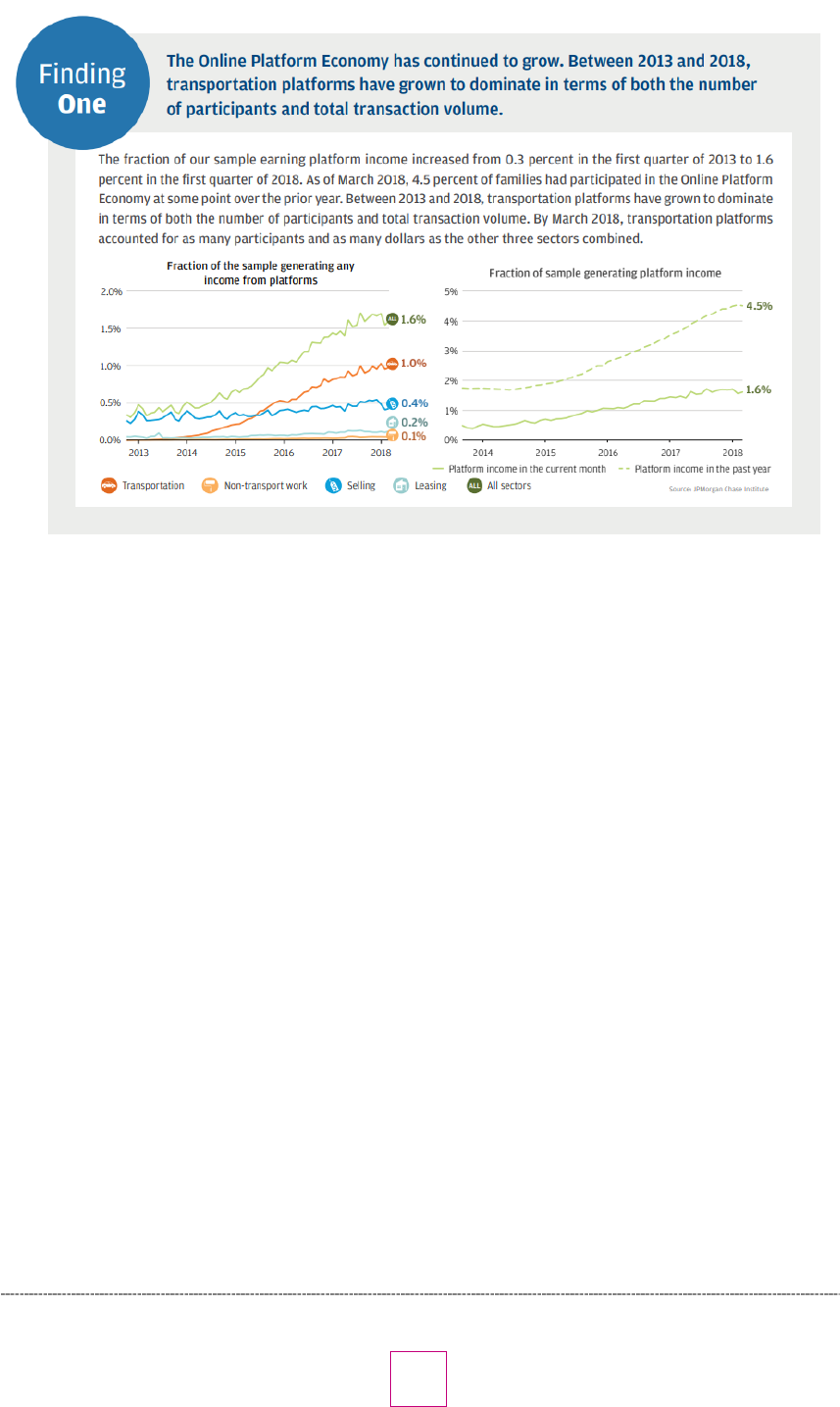
18
Figure 4. Growth findings from big data (39 million US bank accounts)
Source Farrell et al. (2018: p. 3)
A different approach was used in De Groen et al. (2017), combining the JRC dataset on platforms,
which contains gross revenues and the number of active workers for some platforms. The
173 platforms meeting their definition of ‘crowd employment’ were used for analysis, and these data
were interpolated to scale revenues from the global to the EU level, assuming that platforms generate
the same gross revenues per unique visitor across the globe. The authors then enriched the JRC
database with data on the number of unique visitors to a website and location of visitors from
Amazon’s Alexa, which served as a proxy for the amount of activity on a platform. The results
estimated 12.8 million active platform workers in the EU for 2016, or 5.9% of total employment
(ages 15-62). This is similar to Eurobarometer (European Commission, 2016), but still likely inflated
because of the reliance on self-reporting by platforms. For example, one platform reported nearly
3 million registered platform workers, which is incredible given the site had fewer than 1 million
unique visitors for the surveyed month.
A final initiative to gather big data comes from Hara et al. (2018), who developed a browser plugin
for platform workers on AMT (‘Turkers’) to use on an a voluntary, opt-in basis. The plugin was
designed to gather descriptive data
27
at the task level, allowing analysis of task (‘HIT’) duration, HIT
reward, and effective hourly wages Turkers earned. This resulted in logged data of 2,676 Turkers who
performed 3.8 million tasks. The findings highlight the issue of low pay in platform work, as only 4%
of Turkers earn more than $7.25 per hour, while the median hourly wage is just $1.77.
While this plugin strategy is very appealing, it still has potential weaknesses. First, the authors
concede that it is difficult to define unpaid work given that Turkers (and other platform workers)
often spend much of their time searching for paid tasks, which itself is not compensated. In fact,
Hara et al. (2018) identify three types of unpaid work: searching for tasks, working on tasks that are
rejected, and working on tasks that are not submitted. Second, the sample may suffer from self-
selection bias, as the most productive ‘super turkers’ may not have been interested in using the plugin.
27 For example, when workers accept, submit, and return a task; reward (payment); and other metadata about HITs.
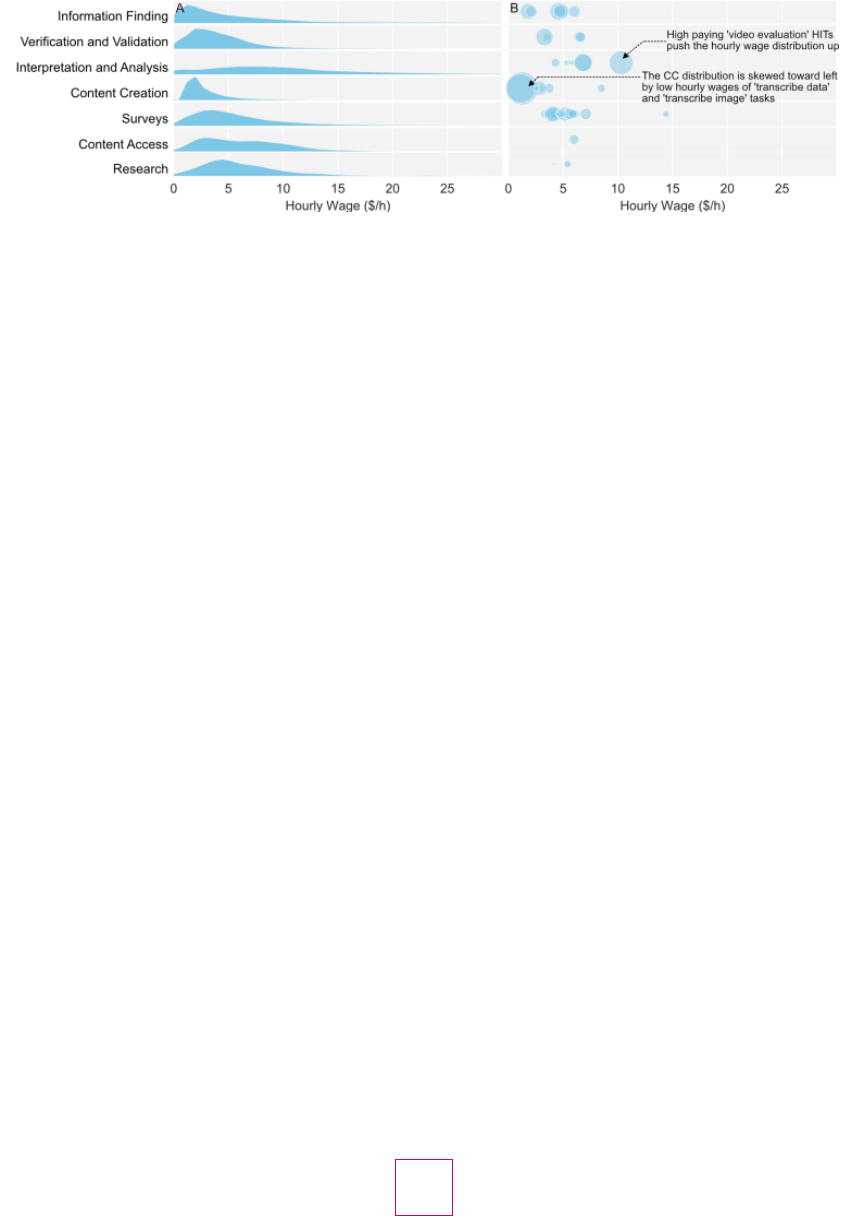
19
Third, accessing such data is not straightforward. Researchers must develop a plugin, then ensure a
large enough number of platform workers actually use it.
Nevertheless, Hara et al.’s (Ibid.) report allows for a more accurate and granular analysis of working
time than any other methods discussed in the present report. For example, the authors calculated the
expected earnings from different types of tasks that Turkers commonly perform, as shown in
Figure 5.
Figure 5. Hourly wage distribution of tasks
Note: A represents hourly wage distributions of seven HIT categories provided by Gadiraju et al. (2014) with
an additional category Research, while B shows strip plots with the median hourly wages of HITS.
Source Hara et al. (2018)
Recommended readings using administrative and big data include:
- Farell et al. (2018);
- Hara et al. (2018);
- Kässi and Lehdonvirta (2018).

20
4. Divergence in size estimates of platform
economy
A number of efforts have attempted to assess the number of total or active platform workers, amount
of revenue earned by platform workers, the economic value added of platform work, or some
combination of these. These estimations have mostly relied on one or a combination of three sources:
surveys, administrative data, and big data.
Available literature shows broad consensus about certain ideas: (1) the platform economy
represents a fairly small portion of the overall economy, both in terms of revenues and workers;
(2) the platform economy is less developed in Europe than in the US; (3) the platform economy is
rapidly growing; and (4) a few ‘giants’ such as Uber and Airbnb comprise a very large portion of the
platform economy (De Groen et al., 2017).
Beyond these similarities, size estimates vary greatly due to theoretical and methodological
challenges particular to platform work. One of the most contested and policy-relevant questions is
the share of platform workers out of the population or labour force. Table 1 presents an overview of
estimates of the share of platform workers in select EU Member States.
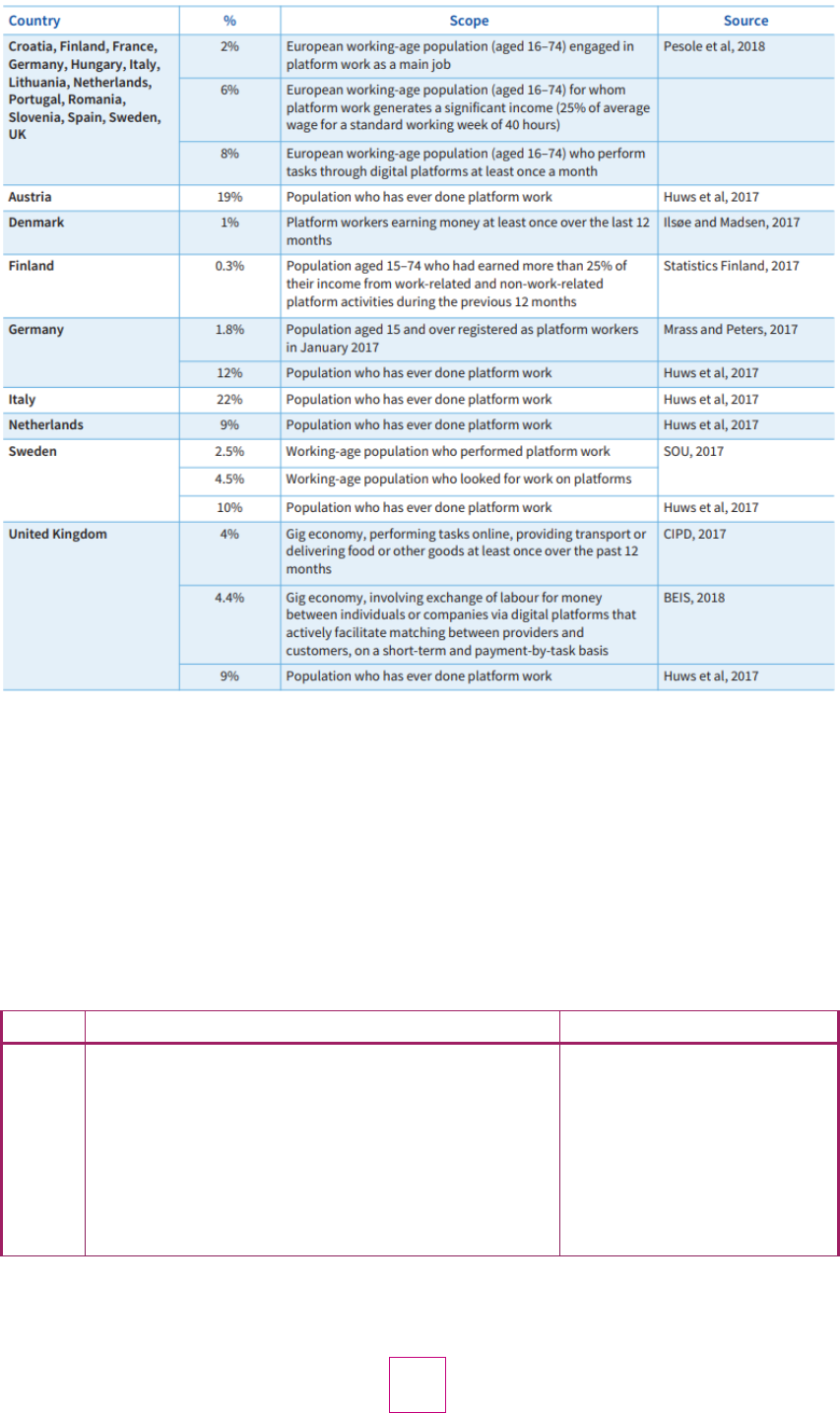
21
Table 1. Share of platform workers in selected EU Member States
Note: The estimates shown do not necessarily reflect this report’s understanding of platform work.
Source Eurofound (2018: p. 13)
As shown in the first grouping of countries, platform work as a main job is fairly rare, at 2% of the
working age population. However, Table 1 shows great variation even among recent and widely-cited
studies.
To highlight the differences, take Spain for example. These figures in Table 2 come from the
follow-up survey Huws et al. (2019), which extended the same methodology of Huws et al. (2017) to
more countries, and the COLLEEM survey data.
Table 2. Spanish platform work estimates as part of working age population
Reported Figure Source
17.0% At least weekly platform work Huws et al. (2019)
10.5% Less than weekly platform work
20.6% Seeking but not undertaking platform work
12.5% Ever platform work COLLEEM
(Pesole et al., 2018; Brancati et al., 2019)
6.3% Platform work 0-10 hours weekly and <25% income
2.6% Platform work 10-20 hours per week and/or >25% income
2.7% Platform work 20+ hours per week and/or >50% of income
Source Author’s elaboration based on Huws et al. (2019) and COLLEEM data (Pesole et al., 2018; Brancati et al.,
2019)

22
Huws et al. found that 17% of the Spanish working-age population earn money from platform work
at least weekly, and 10.5% less than weekly. An additional 20.4% were seeking but not currently
undertaking platform work. From the COLLEEM data, 12.5% of Spanish working age have ever
performed platform work, and only 6.3% at least weekly. Obviously, the COLLEEM estimation is
far more modest.
With such similar timeframes, and both studies relying on internet surveys, it is worth discussing
the reason for such divergence. Consider the following differences in how the researchers approached
the problem.
First, Huws et al. used a random sample of the entire working age population by adding extra
questions to a standard online omnibus survey,
28
while COLLEEM sampled working age internet users
in an online panel survey.
29
In the first report publishing the COLLEEM results, Pesole et al. argue,
‘this is not a bug but a feature of the COLLEEM sample: it would be absurd to sample non-internet
users for a study of work on internet platforms’ (2018: p. 16). Pesole et al. further state that this
approach required scaling estimates of internet usage to the general population, for which they use
Eurostat ICT Survey data. However, Huws et al. do no such scaling. This is interesting because, while
Huws et al. reported figures for the working age population, it would have been much more accurate
to report figures for internet users given the survey mode.
This sampling bias should not be understated, and it is not just that only internet users, by
definition, can be platform workers. One common type of platform work is filling out online surveys
for payment, which means surveys for pay inherently draw a higher proportion of platform workers
than the general population, or even the population with internet. Huws et al. (2017) attempted to
check for this bias by conducting the survey via phone and face-to-face in two of the seven countries
(UK and Switzerland) covered by the online survey. In the UK, the online survey found that 9.3%
undertake any crowd work, while the offline survey was lower at 7.38%. The difference is not trivial;
the online estimate is 26% larger. The authors also found that ‘these survey mode effects may be
severe in the Swiss tele- phone-based survey’ (Huws et al., 2017: p. 20). Furthermore, we know that
the UK has relatively high internet penetration compared to some other sampled countries; in 2014,
for example, 90% of UK households had internet access versus 74% in Spain.
30
This suggests that
the discrepancy between online and offline surveys may have been small in the UK compared to
some other countries. Nevertheless, Huws
et al.
presented all findings without any adjustments
to the (online) survey mode. This is likely to have biased results significantly upwards, as noted by
De Groen et al. (2017) and others.
Second, the two studies differently delineate sporadic, occasional, and full-time platform workers.
There is no objectively correct way to do this, but it must be done to highlight differences in platform
work frequency. Taking all who have performed platform work ever is too broad a measure of
platform workers, and not as relevant from a policy standpoint. Huws et al. focused on percentage of
earnings (>50% or not), whereas Pesole et al. asked more questions allowing them to further delineate
between frequency, periodicity, and earnings.
28 Specified in Huws et al. (2017).
29 The sampling frame was a commercially available list of internet users, with non-probability quota sampling of respondents by gender
and age group (Pesole et al., 2018).
30 See Eurostat data here
.
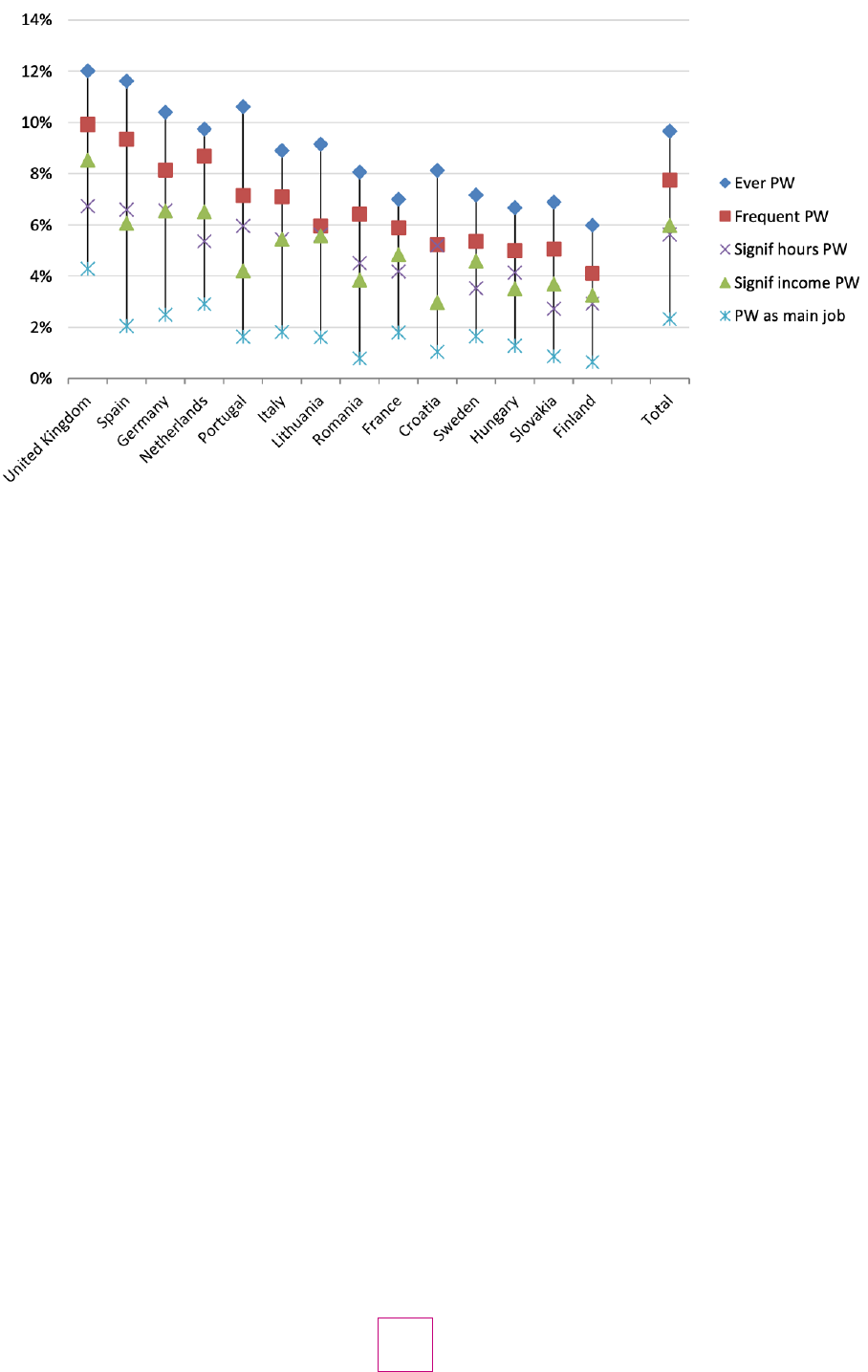
23
Figure 6. Different estimates of platform work (PW) using COLLEEM data
Source
Pesole et al. (2018: p. 19)
Third, the surveys had subtle but important differences in types of platform work and wording of
questions, which impact how respondents qualify or not as platform workers. Huws et al. use ‘crowd
work’ defined as paid work via an online platform (2017: p. 16). This includes three categories of
platform workers with survey questions worded as follows (UK version) – those who:
1. look for work you can carry out from your own home on a website such as Upwork, Freelancer,
Clickworker;
2. look for work you can carry out for different customers somewhere outside your home on a
website such as Handy, Taskrabbit or Mybuilder;
3. offer to drive someone to a location for a fee using an app or website such as Uber or Blablacar.
In the first category, some who carries out work (1) from your own home and (2) on a website would be
considered a crowd worker. However, a teleworking web designer (employed by a company) could
meet both criteria, though they should not be understood as a platform worker. The question relies
on familiarity with the example OLPs given. One nuance of the wording is that platform workers
should not be understood to be doing work for a website (the wording in the report) or on a website (the
wording in the survey), but rather matching with customers through a website. This is better reflected in the
second and third categories. However, the ambiguity is still such that the survey probably resulted in
false positives.
Pesole et al. attempted to limit this problem by being more specific and using ten categories of tasks.
One advantage of this is more granularity in results, since numerous types of tasks can be undertaken
on a platform like Upwork. On the other hand, Pesole et al. only provide two types of on-location
platform work.
These are listed as follows:
1. transportation and delivery services (e.g. driving, food delivery, moving services and similar);
2. on-location services (e.g. housekeeping, beauty services, on-location photography services and
similar).

24
Certain types of platform work performed on location, such as pet-sitting, retail intelligence, and
others would seem to fit into the second category, but require more interpretation than the examples
explicitly listed. For that reason, on-location platform work may be under-estimated. Indeed,
COLLEEM is notable for estimating that online platform workers form the large majority of
platform workers, going against the conventional wisdom that Uber drivers are most common
(Harris & Krueger, 2015; De Groen et al., 2017).
Final thoughts
Both the survey in Huws et al. (2017) and COLLEM (Pesole et al., 2018) are important sources of
data available on platform work in Europe. However, the former significantly overestimates the
preponderance of platform workers overall compared to other reputable surveys. The latter is much
better in this regard for its handling of bias from online surveys. Overall, the COLLEEM survey is
the most reliable source of data on platform work in the EU (Kilhoffer et al., 2020).
Comparing the COLLEEM survey (Pesole et al., 2018; Brancati et al., 2019) to Huws et al. (2017;
2019) illustrates the difficulty of surveys on platform work. Even when the survey modes are properly
handled, the wording of questions remains an important challenge. If the academics rarely agree on
what constitutes a platform worker, it is no wonder that survey questions - designed to be brief - are
unable to adequately communicate the idea. For this reason, subsequent COLLEEM surveys will
continue to refine their method (Brancati et al., 2019). This should result in more robust results, but
changing methodologies also make time-series analysis more complex.

25
5. Conclusions
This report has argued that platform work is increasing in relevance. Given the rate of change in the
platform economy, policymakers and researchers ought to take a broad view of what constitutes
platform work. Failing to do so will result in new forms of platform work being overlooked, and
more risks of precarious work falling in a regulatory grey zone.
Many examples of data and statistics on working conditions are available, covering a broad range
of platform work types. However, these data are often publicly unavailable and challenging for
researchers to access. Overall, the data suggest both advantages and disadvantages of platform work,
such as the benefit of more flexible working times and the risk of inadequate social protection, while
showing that platform work remains a small but growing fraction of the labour force.
Measuring platform work remains very difficult, especially when the goal is to generalise about the
entire population. Surveys, administrative and big data all struggle in this regard. The best data sources
acknowledge this shortcoming and attempt to handle it with methods like triangulation, weighting by
population, and others.
Future efforts should continue to leverage surveys, which are especially well-suited for understanding
worker sentiment. This would continue to deepen our understanding of the circumstances under
which platform work is most advantageous - or precarious - for workers. However, extra care is
required to avoid sampling and response bias when relying on online surveys – particularly when
respondents are paid.
The most promising initiatives involve collaboration. For example, the Online Labour Index (OLI)
is a collaboration between academics and platforms, resulting in real-time insights into the demand
for platform work. Using big and administrative data from platforms, whether from voluntary sharing
or obligatory disclosures, is already being pursued by a number of governments both for research
purposes and to ensure proper taxation. Without a complete overview of all Online Labour Platforms
(OLPs), these efforts cannot result in a comprehensive view of platform work, but they can account
for the majority of platform work given the dominance of relatively few platforms.
At EU-level and for individual Member States, policymakers should consider requiring platforms
to provide administrative data, in order to receive preferential tax treatment (as in Belgium), or to
operate at all (as with AirBnB in Amsterdam). This can help ensure conformity with regulations and
better socio-economic insights.

26
appendix 1
Table a1. Mentioned platforms
99designs
AirBnB
Amazon
Amazon Mechanical Turk (Mturk/AMT)
BlaBlaCar
Clickworker
eBay
Etsy
Freelancer
Handy
Hilfr
Instagram
ListMinut
Mighty AI
Mybuilder
Taskrabbit
Twitch
Uber
Upwork
YouTube

27
Table a2. Selected data and statistics on platform work
Year Publication
(authors)
Geographic focus Research focus
(platform types)
Type of data Method for data
collection and/or
analysis
Measurement(s) Reference period
2014 Airbnb, 2014 UK Airbnb Administrative and
survey data
n.a. Economic impact and job
creation
Nov 2012 - Oct 2013
2014 Hawksworth and
Vaughan, 2014
(PwC)
US Crowdfunding and P2P
lending and accommodation,
online staffing, car sharing,
streaming, (video/music)
Administrative data Forecasting method Platforms’ revenues in the
five sectors
n.a.
2014 Owyang et al.,
2014
UK, US,
Canada
Peer-to-peer platforms
(covering 5 broad categories
of collaboration: goods,
services, transportation, space
and money including money
lending and crowdfunding)
Survey data Two survey rounds. First
round part of a general
omnibus survey
(N=90,112), and
follow-up survey
(N=2,550)
Participation in the
sharing economy (as con-
sumer) and motivations
Oct 2013 - Jan 2014
2014 Nielsen, 2014 World (60 countries
throughout Asia-
Pacific, Europe, Latin
America, the Middle
East, Africa and
North America)
For profit good and service
platforms
Survey data Online survey
(N=30,000 internet users).
Non-probability sampling
Willingness in partici-
pating (as consumer) in
sharing economy activities
14 Aug - 6 Sept 2013
2014 Stokes et al., 2014
(Nesta)
UK Internet-enabled collaborative
activities across a selection of
sectors (transport, holidays,
off jobs and tasks, technolo-
gies and electronics, clothing
and accessories, media, chil-
dren’s equipment and toys,
households goods and appli-
ances)
Survey data Online survey
(N=2,000 adults 16 and
older).
No information on sam-
pling technique used
Participation as consumer
or provider
May 2014
2015 Burston-
Marsteller, the
Aspen Institute
and TIME, 2015
US Ride sharing, accommodation,
food delivery platforms and
other services platforms
Survey data Online survey (N=
3,000 US adults).
No information on sam-
pling technique used
Participation as consumer
or provider in sharing
activities
Nov 2015

28
Year Publication
(authors)
Geographic focus Research focus
(platform types)
Type of data Method for data
collection and/or
analysis
Measurement(s) Reference period
2015 DGE, 2015 FR Peer-to-peer transactions
involving a wide range of
goods and services. Also trans-
actions without monetary
exchange covered.
Survey data Online consumers survey
(N=2,006 adults aged 18
and over).
Non-probability sampling
Types of transactions,
frequency, spending,
offers, purchase
15-22 Oct 2014
2015 Harris and
Krueger, 2015
US Labour platforms Big data Collection and analysis of
google trends data
Size of the workforce
engaging in the gig
economy
Jan – Nov 2015
2015 ING
International,
2015
AU, AT, CZ, BE,
DE, ES, FR, IT, LU,
NL, PO, RO, TR,
UK, US
Capital platforms Survey data Online survey (N=
14,829 adults aged 18 and
older).
No information on sam-
pling technique
Awareness, participation,
earned income and atti-
tudes towards sharing
16 Jan - 2 Feb 2015
2015 Kuek et al., 2015 World
Microwork and online free-
lancing platforms
Administrative data Forecasting method
Market size and number
of registered workers
2013 (projections to
2016)
2015 Maselli and Fabo,
2015 (CEPS)
World CoContest (design work plat-
form)
Big data Data collected from
Google searches and web
crawling
Number of submissions
per designer, level of earn-
ings (compared to local
wages)
Sept 2015
2015 Nesta, 2015 UK
Selling, lending, giving or leas-
ing own assets or skills on the
internet
Survey data
Part of a face-to-face
omnibus survey
(N=2,010 adults aged 15
and over).
No information on sam-
pling technique
Participation as provider
and earnings, Estimation
of monetary value of
transactions
Feb 2015

29
Year Publication
(authors)
Geographic focus Research focus
(platform types)
Type of data Method for data
collection and/or
analysis
Measurement(s) Reference period
2015 PwC, 2015 US
• Hospitality and Dining
(CouchSurfing, Airbnb,
Feastly, LeftoverS wap)
• Automotive and Transpor-
tation (RelayRides, Hitch,
Uber, Lyft, Getaround,
Sidecar)
• Retail and Consumer
Goods (Neighborgoods,
SnapGoods, Poshmark,
Tradesy)
• Media and Entertainment
(Amazon Family Library,
Wix, Spotify, SoundCloud,
Earbits)
Survey data Online survey of con-
sumer panellists
(N=1,000)
Familiarity and engage-
ment, benefits, concerns
17-22 Dec 2014
2016 Berg, 2016 World
(CrowdFlower), US
and India (AMT)
Micro tasks platforms
(CrowdFlower and AMT)
Survey data Online survey of
CrowdFlower (N=67.7)
and AMT workers
(N=1,167)
Demographics, work
experience and work his-
tory
Nov - Dec 2015
2016 Collaboriamo and
Trailab, 2016a
IT Capital and labour platforms Administrative data Mapping exercise drawing
from existing literature
and information provided
directly by platforms
through an online ques-
tionnaire (64 out of 138
identified platforms
responded)
Number of active plat-
forms, sector distribution,
demographics of platform
owners and workforce
Oct 2016
2016 Collaboriamo and
Trailab, 2016b
IT Crowdfunding platforms
(divided into donation reward,
DIY, equity and lending plat-
forms)
Administrative data Mapping exercise drawing
from existing literature
and information provided
directly by platforms
through an online ques-
tionnaire (41 out of 70
identified platforms
responded)
Number of active plat-
forms, amounts raised for
each platform type,
demographics of work-
force
Oct 2016

30
Year Publication
(authors)
Geographic focus Research focus
(platform types)
Type of data Method for data
collection and/or
analysis
Measurement(s) Reference period
2016 De Groen et al.,
2016 (CEPS)
BE ListMinut (local personal ser-
vices platform)
Big data Web crawling; data sup-
plemented with Belgian
administrative data
Types of tasks
posted/provided and
hourly remuneration
23 Dec 2013 - 22 Dec
2015
2016 De Groen and
Maselli, 2016
(CEPS)
EU28 Uber ride-hailing platform Big data Collection and analysis of
Google search data
Number of active workers End of 2015
2016 European
Commission,
2016a (Flash
Eurobarometer
438)
EU28 Online service platforms
(renting accommodation and
car sharing to small household
jobs)
Survey data Telephone-based survey
(N=14,050, EU residents
aged 15 years and over).
Multi-stage, random
(probability) sampling
Awareness and frequency
of use of ‘collaborative
platforms’
March 2016
2016 European
Commission,
2016b (Special
Eurobarometer
447)
EU28 Search engines, online social
networks, online marketplaces
Survey data Face to face survey
(N=27,969, EU residents
aged 15 and over). Multi-
stage, random (proba-
bility) sampling
Frequency of use and atti-
tudes towards online plat-
forms
April 2016
2016 Evans and
Gawer, 2016
World (five world
regions and 22 coun-
tries)
Transaction platforms; innova-
tion platforms; integrated plat-
forms; investment platforms
Administrative data Data collected using dif-
ferent search tools and
databases (Quid Web
Intelligence tool, CB
insights, Thomson
Reuters Eikon financial
database), analysed and
compiled in a database
Geographic and sector
distribution, ownership
structure
2015
2016 Farrell and Greig,
2016 (JP Morgan
Chase and Co.
Institute)
US Capital and labour platforms
(30 in total)
Big data Analysis of American JP
Morgan Chase customers’
bank account transactions
Income from platforms Oct 2012 - Sept 2015
2016 Freelancers
Union and
Upwork, 2016
US Social media, online freelance
marketplaces and sharing
economy sites
Survey data Online panel survey
(N=6,002 of US adults).
No information on sam-
pling technique used
Use of online social media
and online platforms to
find work
2016

31
Year Publication
(authors)
Geographic focus Research focus
(platform types)
Type of data Method for data
collection and/or
analysis
Measurement(s) Reference period
2016 Hall and Krueger,
2016
US Uber ride-hailing platform Survey and administra-
tive data
Analysis of data from two
online surveys of Uber
drivers (N= 601 in 2014;
N= 833 in 2015). Survey
data supplemented by
administrative data on
Uber drivers’ driving his-
tories, schedules and earn-
ings between 2012 and
2014
Demographics of Uber
drivers, income situation
and motivations
Dec 2014,
Nov 2015
2016 Jesnes et al., 2016 NO Capital and labour platforms Survey data Online survey
(N=1,525 Norwegian
adults aged 18 and over)
Engagement in online
platforms and frequency
of use
2016
2016 Katz and
Krueger, 2016
US Labour platforms Survey data RAND-Princeton Contin-
gent Work Survey
(RPCWS), a version of the
CWS, as part of the
RAND American Life
Panel (N=3,850). Sample
recruited through a variety
of means (including a
group recruited for the
University of Michigan
internet panel, a random
digit dial sample, and a
snowball sample)
Size of workforce in plat-
form work
Oct - Nov 2015
2016
McKinsey Global
Institute, 2016
DE, ES, FR, SE, UK,
US
Digital platforms for inde-
pendent work, comprising
platforms for people to sell
goods or lease assets or pro-
vide labour services
Survey data
Online panel survey. Sam-
pling working age popula-
tion (N=8,131)
Engagement in independ-
ent work and digital plat-
form; motivations; and
incomes earned from digi-
tal platforms
June - July 2016
2016 Robles and
McGee, 2016
US Online labour platforms and
selling sites
Survey data Online survey (N=
2,483 qualifying respond-
ents out of a total sample
of 6,898 US adults aged
18 and over). Probability-
based online sampling
Engagement in online
platforms
Oct - Nov 2015

32
Year Publication
(authors)
Geographic focus Research focus
(platform types)
Type of data Method for data
collection and/or
analysis
Measurement(s) Reference period
2016 Vaughan and
Daverio, 2016
(PWC)
BE, DE, ES, FR, IT,
the NL, PO, SE, UK.
Peer-to-peer accommodation;
peer-to-peer transportation;
on- demand household ser-
vices; on- demand profes-
sional services; collaborative
finance
Administrative data Secondary data sources
used, enabling ‘data trans-
lation and triangulation
exercise’
Size of the platform econ-
omy in terms of value of
transactions and plat-
forms’ revenue
2013-2015
2016 Smith, 2016a US Labour platforms, capital plat-
forms, and crowdfunding sites
Survey data Panel survey (N=
4,787 US adults). Proba-
bility sampling
Attitudes, awareness and
use (as clients) of online
platforms
Nov-Dec 2015
2016 Smith, 2016b US Capital and labour platforms Survey data Panel survey (N=
4,579 US adults). Proba-
bility sampling
Use (as provider) of
online platforms
July-Aug 2016
2016
Kässi and
Lehdonvirta,
2016
World
Five prominent English lan-
guage online labour platforms
intermediating digital services
Big data
API access and web
scraping. Tracking pro-
jects and tasks posted
across major English- lan-
guage online labour plat-
forms
Utilisation of online
labour across countries
and occupations, projects
and tasks posted
May 2016 - October
2016
2016 BMAS, 2016 DE Two 'crowdworking' platforms Survey data Survey (N=408) Socio-economic back-
ground, employment
status and motivations
Feb 2015
2017 Alsos et al., 2017 NO Labour platforms and Airbnb Survey data Telephone survey
(N=1,000 Norwegians
aged 18-65 years)
Size of workforce engag-
ing in platform work
Sept 2016-Oct 2017
2017 Bonin and Rinne
2017
DE Labour platforms Survey data Omnibus telephone
survey (N=10,017, aged
18+)
Size of the workforce
engaging in platform work
April-June 2017
2017 Balaram et al.,
2017
UK Labour platforms Survey data Face-to-face omnibus
survey (N=7,656 UK resi-
dents aged 15 and older)
Engagement in platform
work, motivation, working
time, work-life balance
11 Nov 2016-10 Jan
2017

33
Year Publication
(authors)
Geographic focus Research focus
(platform types)
Type of data Method for data
collection and/or
analysis
Measurement(s) Reference period
2017 CIPD, 2017 UK Labour platforms Survey data Online survey
(N=5,019 adults aged
18-70). Non-probability
sampling
Size of workforce engag-
ing in platform work,
motivations and level of
income
Dec 2016
2017 De Groen et al.,
2017
EU28 Labour platforms Administrative data Secondary data sources
used to calculate estimates
(data extrapolations to
estimate missing data).
Clustering technique used
to categorise online plat-
forms
Size of work- related plat-
form economy in terms of
gross revenues and num-
ber of active workers
2016
2017
European
Commission,
2017
BG DE, DK, ES, FR,
IT, NL, PO, SL, UK
Peer-to-peer online platform
in five sectors of activity:
(re)sale of goods; sharing/
renting accommodation;
sharing/renting goods; odd
jobs; and ride sharing/hiring.
Survey data
Online survey
(N=10,019 internet users)
Participation in peer-to-
peer online market as con-
sumer or provider or both
May 2016
2017 Eurostat, 2017 EU28
Peer-to-peer accommodation
and transport services plat-
forms
Survey data
General population /
household survey
(N=200,000 EU residents
aged 16-74). Telephone/
face-to-face/ web
interviews. Stratified,
random (probability) sam-
pling
Share of people arranging
accommodation and
transport services online
via websites or apps
In most countries,
second quarter of
2017

34
Year Publication
(authors)
Geographic focus Research focus
(platform types)
Type of data Method for data
collection and/or
analysis
Measurement(s) Reference period
2017 Fabo et al., 2017 EU28 Transportation (of people and
goods) platforms; platforms
trading online services (for
example design, IT services);
and platforms trading offline,
local services (for example
delivery or housework)
Administrative data Mapping exercise drawing
from existing literature,
media articles and infor-
mation provided directly
by platforms
Number of platforms
active in the EU, platform
size and turnover, work
assignment method and
business models, required
skill level of workers,
number of employees
2017 Huws et al., 2017 AT, CH, DE, IT, NL,
SE, UK
Work platform (delivery of
tasks online and on- location)
Survey data Online surveys:
AT, N=1,969, 18-65 years
CH, N=2,001, 16-70 years
DE, N=2,180, 18-65 years
IT, N=2,199, 16-70 years
NL, N=2,126, 16-70 years
SE, N=2,146, 16-65 years
UK, N=2,238, 16-75 years
Companion surveys:
Telephone based survey
CH, N=1,205, 15-79 years
Face-to-face survey:
UK, N=1,794, 16-75 years
Size of workforce engaged
in platform work, fre-
quency of work, income,
employment status
22-26 Jan 2016 (UK,
online)
24 March-4 April
2017 (UK, offline)
26 Feb -7 March 2016
(SE)
1-4 April 2016 (DE)
1-4 April 2016 (AT)
22-27 April 2016
(NL)
31 March-5 April
2017 (IT)
3-14 April 2017 (CH,
online)
27 March-7 April
2017 (CH, offline)
2017 Ilsøe and
Madsen, 2017
(Denmark LFS)
DK Labour platforms and capital
platforms
Survey data Ad-hoc module of the
Danish LFS
(N=18,043 Danes aged
15-74). Random sampling
Size of workforce engag-
ing in online platforms
and earning an income
Jan-March 2017
2017 Jackson et al.,
2017
US ‘Gig economy’ platforms iden-
tified in tax returns data (spe-
cific words and phrases such
as ride share or ridesharing, or
names of specific platform
providers)
Administrative data Analysis of tax returns.
109,700 individuals filing a
return reporting income
from online platform
Number of workers filing
self- employment income
and reporting income
from an online interme-
diary.
2014

35
Year Publication
(authors)
Geographic focus Research focus
(platform types)
Type of data Method for data
collection and/or
analysis
Measurement(s) Reference period
2017 Karanovic, 2017 World Uber Big data Webscraping and natural
language processing
Sentiment analysis April 2014 - January
2017
2017 ORB
International,
2017
UK Uber ride-hailing platform Survey data Telephone survey
(N=1,002 Uber drivers)
Income, working time,
work-life balance, motiva-
tion and employment
status
8-17 Sept 2017
2017 Statens Offentliga
Utredningar,
2017 (SOU)
SE Peer-to-peer assets- based and
services platforms
Survey data Online survey
(N=7,069 adults aged
16-64)
Size of workforce using
online platforms
Sep 2016
2017 Statistics Canada,
2017 (LFS)
Canada Peer-to-peer rental platforms
and ride services platforms
Survey data Telephone-based survey.
(N=100,000 adults aged
18 and over). Multi-stage,
random (probability) sam-
pling
Total expenditure and use
of online platforms as
both provider and con-
sumer
Oct 2016
2017 Statistics Finland,
2017 (LFS)
FI Airbnb, Uber, Tori.fi /
Huuto.net, Solved (and others
specified by respondents)
Survey data Telephone-based survey
(N=43,0005 aged 15-74
residents in Finland).
Stratified, random sample
Income from work and
non-work- related plat-
forms
2017
2017 Zervas et al., 2017 US Airbnb Survey and administra-
tive data
Data collected directly
from Airbnb website, And
supplemented with other
data sources (Texas
Comptroller, county
demographics from US
Census Bureau, airport
passenger counts from US
Bureau of Transportation
Statistics (BTS), Current
Population Survey (CPS)
from the US BLS, and
hotel reviews from
TripAdvisor. Difference
in difference technique for
data analysis
Economic impact of
Airbnb on hotel industry
(in revenue terms)
Jan 2003 –Aug 2014

36
Year Publication
(authors)
Geographic focus Research focus
(platform types)
Type of data Method for data
collection and/or
analysis
Measurement(s) Reference period
2018 BEIS, 2018 Great Britain Labour platforms Survey data NatCen Panel, a proba-
bility-based online survey
(N=2,184, aged 18 and
over). YouGov Omnibus,
non- probability online
panel survey (N=11,354,
aged 18 and over)
Size of the workforce
engaging om platform
work and characteristics
of platform work
July-Aug 2017
2018
Bureau of Labour
Statistics, 2018
(BLS)
US
Electronically- mediated work,
online and in person
Survey data
Contingent Worker
Survey (CWS) is a supple-
ment to the monthly
Current Population
Survey (CPS). Data col-
lected via telephone and
face-to-face (N=46, 000,
aged 16 and over). Proba-
bility sampling
Size of the workforce
engaging in electronically-
mediated work
May 2017
2018 European
Commission,
2018
EU28 For profit and not- for profit
peer-to- peer and peer-to-
business online platforms in
four sectors of economic
activity (transport, accommo-
dation, finance, and online
skills including on- demand
household services, on-
demand professional services)
Administrative and big
data
Data collected through
online web questionnaire
sent to 1,012 identified
platforms (64 full
responses and 108 partial
responses). Supplemented
with secondary data
obtained from web
searches and web scrap-
ping. Different data
sources enabled data trian-
gulation and validation
Size of the collaborative
economy in terms of reve-
nues and employment
July - Oct 2017
2018 Farrell et al., 2018 US Capital and labour platforms
(128 in total)
Big data Analysis of American JP
Morgan Chase customers’
bank account transactions
Income from online plat-
forms
Oct 2012 -March
2018

37
Year Publication
(authors)
Geographic focus Research focus
(platform types)
Type of data Method for data
collection and/or
analysis
Measurement(s) Reference period
2018 Guarascio and
Sacchi, 2018
IT Capital platforms for interme-
diation services for real estate,
accommodation and classified
ads (Subito.it, Casa.it and
Booking), labour platforms
providing food-delivery
(Deliveroo, Just-Eat, Foodora)
and pet care services (Petme),
and Italian branches of three
global platforms (Amazon,
Facebook and Google)
Administrative data Descriptive analysis of
data drawn from business
and administrative data
sources
Economic and employ-
ment characteristics of
most prominent online
platforms operating in
Italy
2012-2016
2018 Insee, 2018
(French LFS)
FR Intermediaries (including digi-
tal platforms). Types of plat-
form unspecified.
Survey data Ad-hoc module of the
French LFS (Enquête
Emploi) (N= 3,103.000
self-employed with and
without employees).
Probability sampling
Access to clients through
an intermediary (including
a digital platform)
2017
2018 Kässi and
Lehdonvirta,
2018
World Five prominent English lan-
guage online labour platforms
intermediating digital services
Big data API access and web
scraping. Tracking pro-
jects and tasks posted
across major English-
language online labour
platforms
Supply and demand of
online freelance labour
over time and across
countries and occupa-
tions. Collected data was
used to construct an
online labour index.
Jul 2016
Feb 2017
Jan 2018
2018 MBO partners,
2018
US Online job platforms Survey data Online survey (N=3,584,
US residents aged 21 and
older). Non-probability
sampling
Size of the independent
workforce and motiva-
tions. Use of digital plat-
forms to find work.
March 2018

38
Year Publication
(authors)
Geographic focus Research focus
(platform types)
Type of data Method for data
collection and/or
analysis
Measurement(s) Reference period
2018 ORB
International,
2018
UK Uber ride-hailing platform Survey data Telephone survey
(N=1,001 Uber drivers)
Socio- demographics,
income, working time,
motivation, subjective
well-being
18-28 March 2017
2018 Pesole et al., 2018
(European
Commission’s
JRC)
DE, ES, FI, FR, NL,
HR, HU, IT, LT, PT,
RO, SE, SL, UK
Labour platforms Survey data Online survey (N=32,409
Internet users aged
16- 74). A commercially
available list of internet
users in the selected coun-
tries (CINT) used as sam-
pling frame, with non-
probability quota sam-
pling of respondents by
gender and age groups
Size of workforce engag-
ing in platform work, their
characteristics, motiva-
tions and working condi-
tions
June 2017
2018 PwC, 2018 AT, BE, CH, DE, NL
and TR,
For profit and not- for profit
peer-to- peer and business-
‘For profit and not- for profit
peer-to- peer and business-to-
peer online platforms in
selected industry segments
(media and entertainment,
hotels and accommodation,
automotive and transport,
retail and consumer goods,
services, finance, and
machinery)’
Survey data Online survey (N=4,500).
No information on sam-
pling technique
Size and acceptance of
platform economy in the
selected sectors.
June - Aug 2017
2018 Statistics Canada,
2018
CA Selling sites (for example Etsy
and eBay); freelance services
platforms, peer-to-peer ride,
delivery and accommodation
services platforms.
Survey data Online / telephone survey
(N=12,000 Canadians
aged 18 and older).
Two-stage, random (prob-
ability) sampling
Income from selected
platform activities
June - July 2018
2018 Weel et al., 2018 NL On-location work platform Survey data
Online survey. No infor-
mation on sampling tech-
nique
Size of workforce engag-
ing in platform work
n.a.

39
Year Publication
(authors)
Geographic focus Research focus
(platform types)
Type of data Method for data
collection and/or
analysis
Measurement(s) Reference period
2018 Nezhyvenko,
2018
UA ‘IT Freelance’ platforms such
as Upwork, AMT, and
Ukrainian versions
Survey, interview, focus
group data
Online survey (N=1,000)
on three leading plat-
forms, InPoll, snowball
technique
Activity, income, other
working conditions char-
acteristics
2017
2018 Berg et al., 2018 75 countries Five major microtask plat-
forms
Survey data, interviews,
surveys
Survey (N=3,500) Motivations and work
characteristics
2015 and 2017
2019 Huws et al., 2019 AT, CZ, EE, FI, FR,
DE, IT, NL, SI, ES,
SE, CH, UK
Online and on-location plat-
forms, online marketplaces for
selling goods
Survey data Online survey Detailed demographic
data and usage of various
platform types
January 2016-May
2019
2019 Joen et al., 2019 CA Identifying gig workers based
on characteristics of work and
how reported in tax data.
Administrative data and
survey data (census
microdata)
Combine national survey
and administrative data
Proportion of workers
considered gig workers
2016
2019 Katz and
Krueger, 2019
US AMT Survey data Online survey (N=2,291
AMT workers, aged 18
and older). Sample was
not chosen to be repre-
sentative instead selected
to include a large number
of workers who worked
on multiple jobs, often on
a casual basis, and deter-
mine the extent to which
multiple job holders
neglect to report that they
worked on multiple jobs
based on the standard
BLS Current Population
Survey (CPS) question
Multiple job holding using
CPS (BLS)-like question
March 2015
2019 Le Ludex et al.,
2019
FR How many French
microworkers, and how active.
Survey data Online survey (N=2,792) Count and activity levels
of microworkers.
2018

40
Year Publication
(authors)
Geographic focus Research focus
(platform types)
Type of data Method for data
collection and/or
analysis
Measurement(s) Reference period
2019 Piasna and
Drahokoupil,
2019
BG, HU, LV, PL, SK Online forms of platform
work
Survey data Online survey (ETUI
Internet and Platform
Work Survey), random
sampling
Prevalence of platform
work, working conditions
2019-2019
2019 Serfling, 2019 DE Labour platforms Survey data Open-access web panel
survey (N=494,970).
Non-probability sampling
Size of crowd work work-
force, socio-
demographics, remunera-
tion, task duration, moti-
vations and satisfaction
July 2017 - Oct 2018
2020 Brancati et al.,
2020
ES, UK, PT, DE, LT,
NL, IT, RO, HR, FR,
SE, SK, HU, FI
10 diverse types of platform
work
Survey data Survey (N=38,022) Proportion active as plat-
form workers, amount of
activity, demographics,
working conditions
2018
Note: This table builds on the summary found in Riso’s excellent work ‘Mapping the contours of the platform economy’ (2019). The descriptions Riso used are essentially unchanged. The author
extends warm thanks to Eurofound for permission to reproduce this work.

41
References
Airbnb (2014), ‘New Study: Airbnb Community Generates $824 Million in Economic Activity in the UK’, available
at
https://www.airbnb.ie/press/news/new-study-airbnbcommunity-generates-824-million-in-economic-
activity-in-the-uk
Alsos, K. et al. (2017), ‘Nar sjefen er en app’, When the boss is an app). Fafo-report, Vol. 41.
Alsos, K. et al. (2018), ‘Nar sjefen er en app–delingsøkonomi i et arbeidsperspektiv’, Praktisk økonomi & finans,
Vol. 34, No. 02, pp. 101–110.
Arnault, S. et al. (2018), ‘Emploi, chômage, revenus du travail. Edition 2018. Dossier 3. Les agents de l’Etat en
2014: leurs profils, leurs carrières’.
Balaram, B., Warden, J. and Wallace-Stephens, F. (2017), ‘Good gigs: A fairer future for the UK’s gig economy’,
RSA (Action and Research Centre), UK.
Beck, P. et al. (2017), ‘The feasibility of measuring the sharing economy: November 2017 progress update’,
United Kingdom Office for National Statistics,
https://www.ons.gov.uk/economy/economicoutputandproductivity/output/articles/thefeasibilityofmea
suringthesharingeconomy/november2017progressupdate.
BEIS (2018), ‘The characteristics of those in the gig economy’, Research Paper: 2018 no. 2. Department for Busi-
ness, Energy and Industrial Strategy (BEIS), UK Government.
Berg, J. et al. (2018), ‘Digital labour platforms and the future of work | Towards decent work in the online
world’, ILO
(
https://www.ilo.org/wcmsp5/groups/public/---dgreports/---dcomm/---
publ/documents/publication/wcms_645337.pdf).
Berg, J. (2016), ‘Income Security in the On-Demand Economy: Findings and Policy Lessons from a Survey of
Crowdworkers’, SSRN Scholarly Paper ID 2740940, Social Science Research Network, Rochester, NY, March
(https://papers.ssrn.com/abstract=2740940
).
Berg, J. and H. Johnston (2019), ‘Too Good to Be True? A Comment on Hall and Krueger’s Analysis of the Labor
Market for Uber’s Driver-Partners’, ILR Review, Vol. 72, No. 1, pp. 39–68.
BLS (US Bureau of Labor Statistics) (2018), ‘Electronically Mediated Work: New Questions in the Contingent
Worker Supplement’. Monthly Labor Review, US Bureau of Labor Statistics Washington DC.
BMAS (Bundesministerium für Arbeit und Soziales) (2016), ‘Chancen und Risiken der Digitalisierung der Arbeits-
welt für die Beschäftigung von Menschen mit Behinderung’, Forschungsbericht 467.
Bogliacino, F. et al. (2020), ‘Quantity and Quality of Work in the Platform Economy’, in K.F. Zimmermann (ed.),
Handbook of Labor, Human Resources and Population Economics, Cham: Springer International Publish-
ing (https://doi.org/10.1007/978-3-319-57365-6_18-1
).
Bonin, H. and Rinne, U. (2017), Omnibusbefragung zur Verbesserung der Datenlage neuer Beschäftigungs-
formen, Kurzexpertise im Auftrag des Bundesministeriums für Arbeit und Soziales, IZA Research Report
No. 80, IZA, Institute of Labor Economics, Bonn, Germany
Boyd, D. and K. Crawford (2012), ‘Critical questions for big data: Provocations for a cultural, technological, and
scholarly phenomenon’, Information, communication & society, Vol. 15, No. 5, pp. 662–679.
Brancati, C.U. et al. (2019), ‘Digital Labour Platforms in Europe: Numbers, Profiles, and Employment Status of
Platform Workers’, Text, July
(
https://ec.europa.eu/jrc/en/publication/digital-labour-platforms-europe-numbers-profiles-and-
employment-status-platform-workers).
Burston-Marsteller, Aspen Institute and TIME (2015) The Collaborative Economy Survey, available at
www.burson-marsteller.com/ondemand-survey/
CIPD (2017), ‘To gig or not to gig? Stories from the modern economy’, Chartered Institute of Personnel and
Development, UK.
Collaboriamo and Trailab (2016a), Sharing economy: La mappatura delle piattaforme italiane 2016.
Collaboriamo and Trailab (2016b), Il crowdfunding in Italia, Report 2016.

42
Crawford, K. (2013), ‘The hidden biases in big data’, Harvard Business Review, Vol. 1, p. 1.
Dasgupta, A. (2013), ‘Big data: The future is in analytics’, Geospatial World, Vol. 3, No. 9, pp. 28–36.
De Groen, W.P. et al. (2017), ‘The Impact of the Platform Economy on Job Creation’, Intereconomics, Vol. 52,
No. 6, pp. 345–351.
De Groen, W.P., Maselli, I. and Fabo, B. (2016), ‘The Digital Market for Local Services: A one nightstand for
workers?’, CEPS Special Report No. 133, CEPS, Brussels, Belgium.
Dewi, L.C. et al. (2019), ‘Social Media Web Scraping using Social Media Developers API and Regex’, Procedia
Computer Science, Vol. 157, pp. 444–449.
DGE (Direction Générale dés Entreprises) (2015), ‘Enjeux et perspectives de la consummation collaborative’,
Annexe – Enquête auprès des consommateurs, Etudes Economiques, July.
Edelman, B.G. and M. Luca (2014), ‘Digital discrimination: The case of Airbnb. com’, Harvard Business School
NOM Unit Working Paper, No. 14–054.
Eurofound (2018), ‘Employment and working conditions of selected types of platform work’, Digital Age,
Eurofound, Luxembourg
(https://www.eurofound.europa.eu/sites/default/files/ef_publication/field_ef_document/ef18001en.pdf
).
European Commission (2016a), ‘Flash Eurobarometer 438: The use of collaborative platforms’, Directorate-
General for Communication, Brussels, July.
European Commission (2016b), ‘Special Eurobarometer 447: Online platforms’, Brussels, Belgium
European Commission (2017), ‘Exploratory study of consumer issues in online peer-to-peer platform markets’,
prepared VVA, Milieu, and GfK for the European Commission (DG Just), Brussels, Belgium
European Commission (2018), ‘Study to Monitor the Economic Development of the Collaborative Economy at
sector level in the 28 EU Member States’, prepared by Technopolis, Trinomics, VVA Consulting for the
European Commission (DG Grow), Brussels, Belgium.
Eurostat (2017), ‘Online peer-to-peer accommodation services used by 1 in 6 EU citizens’, news release, 199,
20 December.
Evans P. C. and Gawer, A. (2016), ‘The Rise of the Platform Enterprise: A Global Survey’, The Emerging Platform
Economy Series No. 1, New York, US.
Fabo, B. et al. (2017), ‘An Overview of European Platforms: Scope and Business Models’.
Farrell, D. and F. Greig (2016), ‘Paychecks, paydays, and the online platform economy’.
Farrell, D. et al. (2018), ‘The online platform economy in 2018: Drivers, workers, sellers, and lessors’, JPMorgan
Chase Institute.
Fortune (2015), ‘A Huge Percentage Of Etsy Sellers Are Women’, July
(https://fortune.com/2015/07/23/etsy-sellers-women/
).
Freelancers Union and Upwork (2016), ‘Freelancing in America: 2016’
(https://www.upwork.com/i/freelancing-in-america/2016/
).
Gadiraju, U. et al. (2014), ‘A taxonomy of microtasks on the web’.
Grey Ellis, E. (2019), ‘YouTubers Must Unionize, No Matter What Google Says’, Wired
(https://www.wired.com/story/youtube-union/
).
Guarascio, D. and S. Sacchi (2018), ‘Digital platforms in Italy; an analysis of economic and employment trends’,
INAPP policy brief, Vol. 8.
Guta, M. (2018), ‘Etsy Study Says Small Businesses Selling on the Platform Contribute $4.7B to the US Economy’,
November (https://smallbiztrends.com/2018/11/2018-etsy-statistics.html
).
Hall, J.V. and A.B. Krueger (2018), ‘An analysis of the labor market for Uber’s driver-partners in the United States’,
ILR Review, Vol. 71, No. 3, pp. 705–732.
Hall, J.V. and Kreuger, A.B. (2016), ‘An Analysis of the Labor Market for Uber’s DriverPartners in the United States’,
NBER Working Paper No. 22843, National Bureau of Economic Research, Washington.
Hara, K. et al. (2018), ‘A data-driven analysis of workers’ earnings on Amazon Mechanical Turk’.
Harris, S.D. and A.B. Krueger (2015), A Proposal for Modernizing Labor Laws for Twenty-First-Century Work: The’
Independent Worker’, Hamilton Project, Brookings
(
https://www.shrm.org/ResourcesAndTools/legal-and-compliance/employment-
law/Documents/modernizing_labor_laws_for_twenty_first_century_work_krueger_harris.pdf).
Hausemer, P. et al. (2017), ‘Exploratory Study of consumer issues in peer-to-peer platform markets’.

43
Hawksworth, J. and Vaughan, R. (2014), ‘The Sharing Economy - Sizing the Revenue Opportunity’, PwC, London,
UK.
Heerschap, N. et al. (2018), ‘Measuring online platforms’, Universiteit van Amsterdam, Amsterdam, December.
Huws, U. (2014), Labor in the global digital economy: The cybertariat comes of age, NYU Press.
Huws, U. et al. (2017), ‘Work in the European gig economy: Research results from the UK, Sweden, Germany,
Austria, the Netherlands, Switzerland and Italy’.
Huws, U. et al. (2019), ‘The Platformisation Of Work In Europe: Highlights from research in 13 European countries’,
Foundation for European Progressive Studies, July
(
http://researchprofiles.herts.ac.uk/portal/en/publications/the-platformisation-of-work-in-europe-
highlights-from-research-in-13-european-countries(6cb3297c-861e-4d75-962e-5bc9ff031f53).html).
Ilsøe, A. and Madsen, L. W. (2017), ‘Digitalization of work and digital platforms in Denmark’, Employment Rela-
tions Survey Centre (FAOS), University of Copenhagen.
ING International (2015), ‘The European sharing economy set to grow by a third in the next 12 months’, ING.com.
Insee (Institut national de la statistique et des études économiques) (2018), ‘Emploi, chômage, revenus du tra-
vail’, Insee.
Jackson, E., Looney, A., and Ramnath, S. (2017), ‘The Rise of alternative work arrangements: Evidence and
implications for tax filing and benefit coverage’, Department of Treasury, Office of Tax Analysis, US.
Jesnes, K. et al. (2016), ‘Aktører og arbeid i delingsøkonomien’, Delrapport. Fafo-notat 2016, Vol. 23.
Joen et al., 2019
Karanovic, J. et al. (2017), ‘‘Is Platform Capitalism Doomed’? Ask the Workers’.
Kässi, O. (2016), ‘How is online work classified in the OLI?’, The iLabour Project, web page, available at
http://ilabour.oii.ox.ac.uk/how-is-online-work-classified
.
Kässi, O. and V. Lehdonvirta (2018), ‘Online labour index: Measuring the online gig economy for policy and
research’, Technological Forecasting and Social Change
(https://linkinghub.elsevier.com/retrieve/pii/S0040162518301331
).
Katz, L. F. and Krueger, A. B. (2016), ‘The rise and nature of alternative work arrangements in the United States,
1995-2015’, Working paper 22667, National Bureau of Economic Research.
Kilhoffer, Z. (2020), ‘‘BEST PRACTICE’ REPORT ON HOW SOCIAL MEDIA CAN BE USED TO UNDERSTAND THE LABOUR
MARKET’, Milestone 112, Leuven.
Kilhoffer, Z. et al. (2020), ‘Study to gather evidence on the working conditions of platform workers’, DG EMPL.
Kuek, S.-C. Paradi-Guilford, C., Fayomi, T., Imaizumi, S., Ipeirotis, P. (2015), ‘The global opportunity in online out-
sourcing’, World Bank Group, Washington DC, US.
Leimeister, J.M. et al. (2009), ‘Leveraging crowdsourcing: activation-supporting components for IT-based ideas
competition’, Journal of management information systems, Vol. 26, No. 1, pp. 197–224.
Lenaerts, K. et al. (2016), ‘Prospects for utilisation of non-vacancy Internet data in labour market analysis - an
overview’, IZA Journal of Labor Economics, Vol. 5, No. 1, p. 1.
Lenaerts, K. et al. (2017), ‘Government Responses to the Platform Economy: Where do we stand?’, Policy Insights
2017–30, Brussels, July
(
https://www.ceps.eu/system/files/PI2017-
30_Government%20Responses%20to%20the%20Platform%20Economy.pdf).
Maselli, I. and Fabo, B. (2015), ‘Digital workers by design? An example from the collaborative economy’, CEPS
Working Document 414, CEPS, Brussels.
MBO partners (2018, ‘The State of independence in America, 2018: the new normal’, available online at
https://www.mbopartners.com/uploads/files/state-of-
independencereports/State_of_Independence_2018.pdf.
McKinsey Global Institute (2016), ‘Choice, Necessity, and the Gig Economy’, San Francisco. McKinsey Global
Institute.
National Academies of Sciences and Medicine (2020), Measuring Alternative Work Arrangements for Research
and Policy, National Academies Press.
Nesta (2015), ‘Towards an Index of the Collaborative Economy’, Nesta, London.

44
Nezhyvenko, O. (2018), ‘Methodology Behind the Measurement of the Platform Economy (Survey on the Plat-
form Economy in Ukraine)’, presentation for Expert workshop 'Measuring the platform economy: size and
impact', CEPS, Brussels
(
http://www.inclusivegrowth.eu/files/Call-5/INGRID2_ExpertWorkshop_Session1_Oksana-
Nezhyvenko.pdf).
Nielsen (2014), ‘Global share community report: Is sharing the new buying?’, Nielsen.com.
Office for National Statistics (2017), ‘Internet access—households and individuals’, Statistical Bull.
ORB International (2017), ‘Uber poll 2017 - Flexibility key for drivers’, ORB International, September
(http://www.orb-international.com/2017/09/26/uber-poll-flexibility-key-drivers
).
ORB International (2018), ‘New ORB International poll for Uber and Oxford Martin School – Uber happy? Work
and well-being in the ‘gig economy’’, 2 October, available at
www.orbinternational.com/2018/10/02/uberhappy
.
Owyang, J., Samuel, A. and Grenville, A. (2014), ‘Sharing is the new buying, how to win in the collaborative
economy’, Vision Critical and Crowd companies.
Pesole, A. et al. (2018), ‘Platform Workers in Europe Evidence from the COLLEEM Survey’, EUR - Scientific and
Technical Research Reports, Publications Office of the European Union
(http://publications.jrc.ec.europa.eu/repository/handle/111111111/52393
).
PwC (2015), ‘The sharing economy’, Consumer Intelligence Series, PricewaterhouseCoopers.
PWC (2018), ‘Share Economy 2017: The New Business Model’, PricewaterhouseCoopers.
Riso, S. (2019), ‘Mapping the contours of the platform economy’, Working Paper, Eurofound, Dublin.
Robles, B.J. and M. McGee (2016), ‘Exploring Online and Offline Informal Work: Findings from the Enterprising
and Informal Work Activities (EIWA) Survey’, SSRN Scholarly Paper ID 2875204, Social Science Research
Network, Rochester, NY, October (https://papers.ssrn.com/abstract=2875204
).
Russel, M. and M. Klassen (2019), Mining the Social Web: Data Mining Facebook, Twitter, LinkedIn, Instagram,
GitHub, and More, O’Reilly Media, Inc.
Schmidt, F.A. (2017), ‘Digital Labour Markets in the Platform Economy: Mapping the Political Challenges of
Crowd Work and Gig Work’.
Serfling, O. (2018), ‘Crowdworking Monitor Nr. 1’, Für das Verbundprojekt „Crowdworking Monitor’. CIVEY, Hoch-
schule Rhein-Waal, gefördert durch Bundesministerium für Arbeit und Soziales. Abgerufen von
https://www.bmas.de/DE/Presse/Meldungen/2018/ausmass-von-plattformarbeit-in-deutschland-
hoeher-als-erwartet. html.
Silberman, M.S. (2017), ‘Fifteen criteria for a fairer gig economy’, democratization, Vol. 61, No. 4, pp. 589–622.
Smith, A. (2016a), ‘Shared, collaborative and on demand: The new digital economy’, Pew Research Center.
Smith, A. (2016b), ‘Gig Work, Online Selling and Home Sharing’, Pew Research Center.
Statens Offentliga Utredningar (SOU) (2017), ‘Ett arbetsliv I förändring – hur påverkas ansvaret för arbetsmiljön?’,
Stockholm.
Statistics Canada (2017), ‘The sharing economy in Canada’, Press release, 28 February, available at
https://www150.statcan.gc.ca/n1/daily-quotidien/170228/dq170228b-eng.htm
Statistics Canada (2018), ‘Digital economy, July 2017 to June 2018’, Press release, 29 August, available at
https://www.statcan.gc.ca/eng/about/smr09/smr09_094
Statistics Finland (2017), ‘Labour force survey 2017: platform jobs’, available at
http://www.stat.fi/til/tyti/2017/14/tyti_2017_14_2018-04-17_en.pdf
.
Stokes, K., Clarence E., Anderson, L. and Rinne, A. (2014), ‘Making Sense of the UK Collaborative Economy’,
Nesta, London.
Teubner, T. et al. (2017), ‘Price determinants on AirBnB: How reputation pays off in the sharing economy.’,
Journal of Self-Governance & Management Economics, Vol. 5, No. 4, pp. 53–80.
US Bureau of Labor Statistics (2018), Electronically Mediated Work: New Questions in the Contingent Worker
Supplement. Monthly Labor Review, US Bureau of Labor Statistics Washington DC.
vanden Broucke, S. and B. Baesens (2018), Practical Web Scraping for Data Science Best Practices and Exam-
ples with Python, KU Leuven.
Vaughan, R. and Daverio, R. (2016), ‘Assessing the size and presence of the collaborative economy in Europe’,
PwC, London, UK.
Weel, B., Werff, van der, S., Bennaars, H., Scholte, R., Fijnje, J., Westerveld, M. and Mertens, T. (2018), ‘De opkomst
en groei van de kluseconomie in Nederland’, SEO (SEO Economisch Onderzoek), Amsterdam.

45
Zervas, G. et al. (2015), ‘A first look at online reputation on Airbnb, where every stay is above average’, Where
Every Stay is Above Average (January 28, 2015).
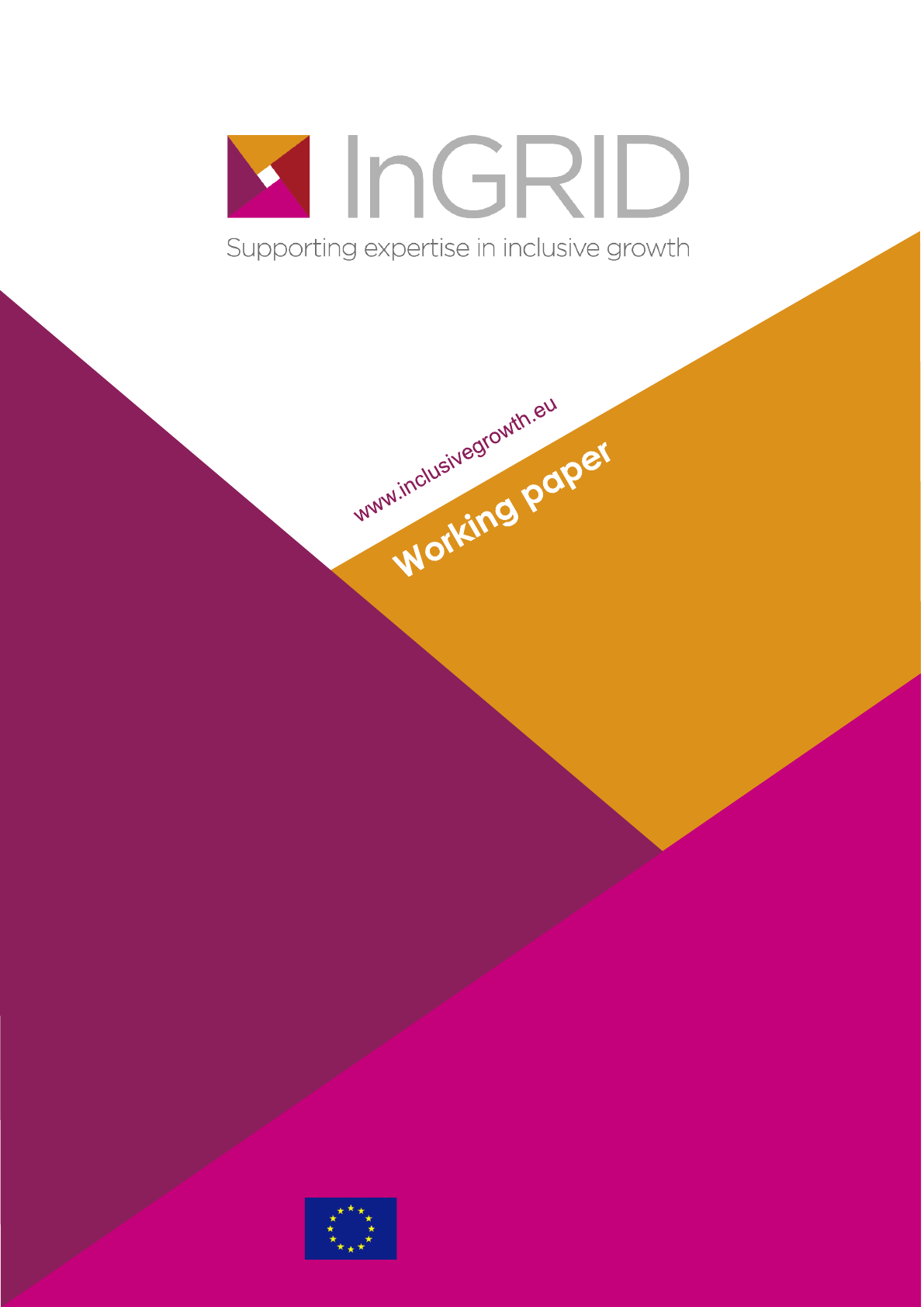
This project has received funding from the European Union’s
Horizon 2020 research and innovation programme under
Grant Agreement No 730998
PLATFORM WORKERS
AND LABOUR MARKET RISK
Who is vulnerable?
Leonie Westhoff
February 2021

Abstract
Platform work is an emerging labour market phenomenon that is increasingly drawing the attention of
policymakers and researchers. This exploratory study contributes to the growing body of evidence on
platform work and its connection to labour market risks. In particular, the study explores in how far labour
market risk is stratified within the population of platform workers due to platform workers’ individual
characteristics and the types of platform work they work in. Drawing on a new data set on platform workers
in Europe, the 2018 COLLEEM survey, three types of labour market risk are investigated: low income, inferior
working conditions and educational mismatch. The results of the analysis demonstrate that there is
significant heterogeneity in platform worker vulnerability to labour market risk. While low education
significantly increases the likelihood of all types of labour market risks for platform workers, the influence of
demographic characteristics is less systematic and depends on the type of labour market risk. In addition,
the influence of types of platform work tasks on labour market risks is complex. While low-skilled platform
work tasks are associated with a higher likelihood of low income, workers in higher-skilled types of platform
work are more likely to report experiencing inferior working conditions. The results of the study suggest that
the relationship between platform worker characteristics and labour market risk is nuanced and warrants
further examination in future research.

48
48
Acknowledgements
I would like to thank Sara Baiocco, Zachary Kilhoffer and Stephanie Steinmetz for their useful
comments on previous drafts of this work. I would also like to thank the Joint Research Centre of
the European Commission for providing access to the COLLEEM data set.

49
49
Contents
Acknowledgements 48
1. Introduction 50
2. Which platform workers are most vulnerable to labour market risk? 51
2.1 Risk of low income 51
2.2 Risk of inferior working conditions 52
2.3 Risk of educational mismatch 54
3. Data, variables and methods 56
4. Results: summary and discussion 59
4.1 Descriptive statistics: the population of platform workers across European countries 59
4.2 Regression results: the relationship between platform worker characteristics and
vulnerability to labour market risk 61
5. Conclusion 68
appendix 1 70
References 83

50
50
1. Introduction
Recent decades have seen the transformation of labour markets through processes such as digitalisa-
tion, globalisation and automation. Significantly, platform work is an emerging phenomenon in
labour markets, which is increasingly drawing the attention of academic research. Against this back-
ground, examining the characteristics of platform work and its economic and social consequences is
of critical importance. However, given the relative newness of the phenomenon and lack of high-
quality data, existing research remains limited.
In this exploratory study, platform work is understood as all labour provided through, on or medi-
ated by online platforms, where platforms operate in a wide range of sectors, work can be of varied
forms and is provided in exchange for payment (Kilhoffer et al., 2020). A platform worker is then a
natural person providing platform work (Ibid.). There are several reasons to expect platform workers
to be vulnerable to ‘old’ labour market risks, such as unemployment and occupational health and
safety risks, but also ‘new’ risks such as non-payment and dependency on ratings for receiving work.
In addition they might also experience exacerbated risks compared to more traditional forms of work,
including increased job and income instability, low income, a lack of training and skills development
opportunities, and skills or educational mismatch (Allaire et al., 2019). Nevertheless, platform work
is extremely heterogeneous, both in the composition of the workforce and the nature of platform
work tasks (Schor et al., 2020). As such, the individual and job characteristics of platform workers
may influence their vulnerability to labour market risk. This association is examined in this study.
The empirical analysis draws on a survey of platform workers, the Collaborative Economy and
Employment (COLLEEM) data set (Pesole et al., 2018; Urzì Brancati, Pesole and Fernandez Macias,
2020), covering 16 EU countries in 2018. This survey is considered to be the most reliable data source
on platform work in the EU (Kilhoffer et al., 2020). The study contributes to the growing literature
on the platform economy in several ways. Most significantly, it provides a systematic analysis of the
influence of different individual characteristics and platform work types on platform worker vulner-
ability to labour market risk. Furthermore, a comparative analysis of three types of labour market
risks is advanced: low income, inferior working conditions and educational mismatch. These are ‘old’
labour market risks, which all workers may face, but which could be exacerbated by platform work.
Indeed, the three labour market risks examined have been identified as particularly relevant to plat-
form workers in previous studies (Eurofound, 2018; Kilhoffer et al., 2020).
Hence, the following research questions are examined:
1. Is there an association between the individual characteristics and platform work tasks of platform
workers and their vulnerability to labour market risk?
2. If so, does this association differ for different types of labour market risk?

51
51
2. Which platform workers are most vulnerable to
labour market risk?
The nature of platform work is often vulnerable, as platform workers may be susceptible to inferior
working conditions and lack access to social, labour and health and safety protections (Garben, 2019).
This section reviews literature on three types of labour market risk - low income, inferior working
conditions and educational mismatch - and assesses the vulnerability of platform workers to these
risks. In this sense, vulnerability is understood as both a product of one’s inherent individual charac-
teristics as well as relational and context specific, being dependent on (among other things) social and
economic circumstances (Mackenzie, Rogers & Dodds, 2014).
The main interest of the study is to examine which platform workers are most vulnerable to labour
market risk within the population of platform workers. Given the relative lack of existing analysis on
this issue, this study is explicitly exploratory and descriptive in nature. The theoretical discussion
refers to literature on the working conditions of platform workers wherever possible; however, it also
draws on findings from the general literature on labour market stratification and working conditions
where appropriate. This literature provides a useful reference point to examine whether patterns
observed in the general labour market also apply for platform work. Types of labour market risk are
examined separately to analyse potential differences in effects.
Platform work is a diverse field of work that covers a multiplicity of tasks. These can be broadly
distinguished based on two main factors: whether they are conducted online or offline, and whether
they are high-skill or low-skill (De Groen & Maselli, 2016). Following Pesole et al. (2018), a fine-
grained typology of ten distinct types of platform work is examined: online clerical and data-entry
tasks, online professional services, online creative and multimedia work, online sales and marketing
support work, online software development and technology, online writing and translation work,
online microtasks, interactive services, transportation and delivery services, on-location services. This
is assumed to encompass the main types of platform work.
2.1 Risk of low income
Previous literature has identified low pay and pay irregularity as an issue for many platform workers,
exacerbated by a struggle to get a sufficient amount of work (Berg, 2016; Forde et al., 2017;
Eurofound, 2018). Platform workers face economic and legal insecurity, have little bargaining power
and are often not unionised or covered by minimum wages (Risak, 2018; Kilhoffer et al., 2020), leaving
them with low labour market standing that can be related to lower wages. Moreover, for online plat-
form work, global competition means that platform workers in high-income countries compete with
workers who can undercut their wages. Workers may also have to cover costs associated with plat-
form work, and there may be issues with non-payment and unpaid time, for instance due to com-
plaints or poor ratings (Risak, 2018). Where platform work is worker-initiated, a significant propor-
tion of time may be spent looking for tasks, researching requesters and communicating with clients,
and thus not be remunerated (Berg et al., 2018). While many platform workers use platform work to
supplement income from other sources (Eurofound, 2018), there are also some that count it as their
main source of income (Kilhoffer et al., 2020) and others that would prefer to work more, often
combining platform work with other poorly-paid work (Fabo, Karanovic & Dukova, 2017).

52
52
Many studies have examined the influence of individual and job-level characteristics on individual
incomes in the overall labour market. This literature has shown that wage returns are structured by
the socio-economic characteristics of workers, with higher wage returns expected for older
(Fournier & Koske, 2012), more educated (Card, 1999) and male (Blau & Kahn, 2017) workers,
among others. On the one hand, the traditional dividing lines of factors such as age and gender may
be replicated in the platform economy. On the other hand, due to the additional flexibility, ease of
work substitutability and transparency it offers, the platform economy may lower entry barriers for
specific groups traditionally disadvantaged in labour markets (Urzì Brancati, Pesole & Fernandez
Macias, 2020). If so, lower entry barriers may be associated with reduced pay gaps based on socio-
economic characteristics. For instance, the higher flexibility of the platform economy may enable
women to increase their labour supply within the context of persistent gender gaps in domestic work
(Foong et al., 2018). However, evidence on the influence of socio-economic characteristics of plat-
form workers on their income is generally scarce, and existing evidence indicates that pay gaps do
persist within the platform economy. Indeed, studies examining labour platforms in the United States
(Foong et al., 2018; Cook et al., 2020) and in Ukraine (Aleksynska, Bastrakova & Kharchenko, 2019)
show evidence of a gender pay gap in platform work, putting in doubt whether this emerging form
of work could close gender differences in labour markets.
In addition to socio-economic characteristics, types of platform work tasks will likely influence
platform workers’ pay. While there are some highly-qualified platform tasks, such as online profes-
sional services, that are highly rewarded, platform work also includes tasks that tend to be low-paid,
such as translation, social media and administrative tasks (Gomez-Herrera, Martens & Mueller-
Langer, 2018; Schwellnus et al., 2019). Generally, virtual services with general skills will be least
rewarded (De Groen and Maselli, 2016; Fabo, Karanovic & Dukova, 2017). In particular, online
microwork, where work is broken up into extremely small, low-skilled tasks, is an area where extreme
low pay is an issue (Berg, 2016; Webster, 2016; Berg et al., 2018; Cantarella & Strozzi, 2019). In con-
trast, income from on-location platform work is usually relatively stable, if modest (Eurofound,
2018).
31
As such, platform workers engaging in low-skilled platform work such as microtasks are
expected to be at higher risk of low income, while the location of platform work as such is not
expected to affect the risk of low income.
2.2 Risk of inferior working conditions
Stress
Work-related stress is associated with adverse impacts on individual health, safety at work and well-
being (Jain & Leka, 2019). Due to the nature of their work, stress may be common among platform
workers. Many forms of platform work are characterised by a high level of competition between
workers and the dependency of workers on rating mechanisms (Garben, 2019), which may encourage
a rapid pace of work without breaks. Indeed, platform workers may experience pressure to constantly
be online to be available for work and attempt to take on as many tasks as possible, especially given
low rates of pay for some tasks, as described above (Forde et al., 2017). In addition, platform workers
often have to coordinate multiple tasks at the same time, sometimes jointly with regular employment,
and have to cope with deadlines posed by clients (Ibid.). Such high levels of work intensity and pres-
sure are likely associated with stress and anxiety (Kilhoffer et al., 2020).
However, the stress platform workers experience at work may be mediated by other factors. In
general, socio-demographic factors matter for work-related stress. Across European countries,
studies focused on the general population have shown that higher levels of stress are observed among
women and lower-educated workers (De Smet et al., 2005). Marriage can also be a stress factor, given
31 For on-location platform work where platform workers set their own prices, pay may be more variable.

53
53
the higher financial pressure associated with family responsibilities and the potential for work-home
conflict (Marinaccio et al., 2013). The relationship between stress and age is u-shaped, with both
younger workers and older workers experiencing higher levels of work-related stress (De Smet et al.,
2005; Marinaccio et al., 2013). In principle, socio-economic factors are expected to affect platform
workers in a similar manner as workers in the overall labour market.
Moreover, the type of platform work may have an impact on levels of stress associated with it.
While tight deadlines are common across types of platform work, the threat of replaceability will be
higher among workers that perform tasks requiring a low level of skills (Kilhoffer et al., 2020). For
online work, microwork has been found to be associated with high levels of stress for workers
(Webster, 2016; Eurofound, 2018). As such, low-skilled platform work is expected to be associated
with higher levels of stress, while the location of platform work is not expected to play a significant
role.
Long working hours
In addition to work-related stress, working long hours, equally associated with psychosocial and
health and safety risks (Jain & Leka, 2019), can be a concern for some platform workers. While many
platform workers only devote a few hours to platform work, often using it as a supplement to regular
employment, anecdotal evidence suggests that there is a proportion that work very long hours,
though there are no precise estimates of how large this proportion is (Kilhoffer et al., 2020). Charac-
teristics of platform work that encourage long hours are the dependency on supply and demand, the
pressure to remain available and work overload, as elaborated on above (Ibid.). The potential for low
pay and the need to spend time waiting or searching for new tasks can further exacerbate this.
There is scarce evidence on the factors that may increase the likelihood of working long hours
among the population of platform workers. Within the general labour market, men are more likely
to work longer hours than women, particularly when they have children (Kodz et al., 2003; Lee,
McCann & Messenger, 2007; Anxo & Karlsson, 2019). Workers in prime age are also most likely to
work particularly long hours (Kodz et al., 2003; Lee, McCann & Messenger, 2007). In addition,
migrants may be more likely to work particularly long hours, while the role of education is disputed
(Anxo & Karlsson, 2019). The empirical analysis will explore whether these patterns also obtain
within the population of platform workers. However, given the lack of existing evidence on why
platform workers work long hours, concrete expectations cannot be formed. As regards the role of
platform work tasks, expectations are also unclear. On the one hand, it may be the case that workers
are more likely to work long hours in low-paid tasks such as online microwork (Berg et al., 2018). On
the other hand, similar to the regular labour market, workers in higher-level occupations may be more
likely to work longer hours (Kodz et al., 2003).
Health and safety
Finally, platform workers may be exposed to health and safety risks through their work. Traditional
health and safety risks at work can be exacerbated by the nature of platform work (EU OSHA, 2017).
Protective occupational health and safety regulations are not necessarily guaranteed for platform
workers given their unclear employment status, though this will depend on country-specific regula-
tion and the type of platform work. Workers often do not receive health and safety training and are
usually responsible for providing their own protective equipment and tools. In addition, platform
workers often do not have the right to paid sick leave.
Within the general population, research has shown that sociodemographic characteristics of
workers can have an influence on workplace health and safety (Schulte et al., 2012). Low education
may be a determinant of the risk of work injury, as education can provide better knowledge in health
and safety related issues or help workers advance to safer positions (Piha et al., 2013). Migrant workers
are also more likely to be exposed to inferior working conditions, in turn related to occupational
health and safety risk (Pérez et al., 2012). Men, younger workers and lower-skilled workers are at

54
54
higher risk of accidents at work, as laid out by Eurostat (2010). In contrast, women are at higher risk
of mental health problems, as are mid-age workers and higher-educated workers. Female workers are
also at higher risk of occupational diseases, the incidence of which strongly increases with age. In
principle, these mechanisms may apply in similar ways within the platform economy, though this
cannot be said with certainty given the lack of existing evidence.
In addition, the type of platform work undertaken is expected to be associated with differences in
exposure to health and safety risk. In the first place, the types of risks differ substantially between
online and offline work, but it is not clear which type of platform work is associated with higher
health and safety risk. While the risks associated with on-location platform work include accidents,
chemical exposure and harassment, online work exposes workers to postural disorders, eye strain and
psychosocial risks due to the lack of an office environment (EU OSHA, 2017; Eurofound, 2018;
Kilhoffer et al., 2020). Moreover, certain types of platform work, particularly low-skilled platform
work, are more likely to be associated with time pressure, stress and long working hours, as elaborated
on above, which may also exacerbate health and safety risks associated with this work (EU OSHA,
2017). As such, low-skilled platform work, is expected to be related to a higher health and safety risk
relative to high-skilled platform work.
2.3 Risk of educational mismatch
Finally, platform workers are at risk of educational mismatch. Overeducation is defined as an indi-
vidual working in a job for which a lower level of education than their own is required, whereas
undereducation, conversely, is defined as working in a job for which a higher level is required (Allen &
van der Velden, 2001). Educational mismatch is a form of skills mismatch, that is, a poor fit between
a worker’s qualifications and skills and those required by their job (OECD, 2013). Such mismatch
can have negative consequences for workers, both in the form of wages and job satisfaction (Quintini,
2011a).
Many providers of platform work engage in activities that have traditionally been blue or pink
collar, despite being highly educated (Schor, 2017). As such, most platform workers are overqualified
for the type of work they perform through platforms (Kilhoffer et al., 2020). While the types of skills
applied on platforms vary strongly (Eurofound, 2018), for many workers, tasks are frequently short
and repetitive, despite workers’ high level of education (Berg et al., 2018), resulting in educational and
skills mismatch. In addition, access to training is significantly lower than for other forms of work,
and most workers indicate that there are few opportunities to learn or develop skills (Eurofound,
2018; Kilhoffer et al., 2020). However, some workers highlight the opportunity to learn new things
such as navigating work in an online environment or improving their English (Berg et al., 2018).
Existing research on the overall labour market has shown that socio-demographic characteristics
influence the propensity of workers to be over- and under-qualified (for a thorough review see
Quintini, 2011a, 2011b). In particular, young workers and immigrants are substantially more likely to
be over-qualified for their work, which can be traced back to their lack of work experience and diffi-
culty in transferring qualifications to the domestic labour market. Some studies also find that women
are more likely to be overeducated as well as undereducated, though the evidence is more mixed in
this case. Equally, the role of marital status and children in influencing educational mismatch is
unclear.
It is an interesting question to what extent these traditional labour market dynamics will translate
to platform work. On the one hand, similar patterns as in the general labour market may be observed
for platform workers. If demands for qualifications, work experience and language skills on platforms
are similar to other jobs, workers that are traditionally more likely to face educational mismatch may
face similar risks in the platform economy and be trapped in lower-skilled platform work that does
not match their qualifications. On the other hand, it could also be the case that workers traditionally
at the margins of labour markets and struggling to find jobs matching their qualifications or skills in

55
55
the traditional economy are more able to do so in the platform economy. If this is the case, vulnera-
bility to educational mismatch may not be stratified by socio-economic characteristics in the platform
economy.

56
56
3. Data, variables and methods
One of the challenges in conducting research on the platform economy is the general lack of high-
quality data. This study is able to draw on perhaps the highest-quality survey of platform workers
available to date, the COLLEEM survey (Pesole et al., 2018; Urzì Brancati, Pesole & Fernandez
Macias, 2020). COLLEEM is an online panel survey of internet users aged 16-74, that contains
detailed information on respondents’ socio-demographic characteristics and activity in the platform
economy. COLLEEM data is collected by the Joint Research Centre of the European Commission
in partnership with the Directorate General for Employment, Social Affairs and Inclusion. The first
pilot wave of the survey was carried out in 2017, with fieldwork for a second survey carried out in
autumn of 2018. The data was collected through questionnaires administered online.
The data used originates from the second COLLEEM survey. This data includes 38,787 responses,
of which 5,489 are platform workers, from 16 European countries.
32
The survey data is a representa-
tive sample of internet users aged 16-74 based on a non-probability quota-based sampling approach.
The fact that only internet users are sampled in the COLLEEM survey is intentional, as the authors
state that non-internet users should not be sampled for a study on work on internet platforms (Pesole
et al., 2018). Nevertheless, there may be some bias in the sample and the results cannot necessarily be
generalised to the whole population of platform workers.
A variety of dependent variables are defined. First, a dummy variable on low income is created.
Ideally, the indicator of income would directly measure the income individuals make in the platform
economy. However, while COLLEEM includes a measure of hourly wages from work in the platform
economy, this indicator cannot be used in the analysis. First, it measures wages from the main plat-
form individuals work on, not wages generally received in the platform economy. Second, preliminary
examination of the variable showed many missing values, a large variation in outcomes and improb-
ably high values for many respondents, suggesting that the measure is not reliable. Instead, the indi-
cator of low income is coded as a dummy equalling one when individuals place themselves as receiv-
ing an income corresponding to the lowest quartile of their country’s income distribution. However,
this measure also has limitations. Besides relying on individuals accurately reporting their income, a
particular issue is that the measure refers to all income, not only income in the platform economy.
This is problematic, particularly as many individuals obtain income from platform work as a supple-
ment to their regular income. To mitigate potential error resulting from this, the analysis is limited to
individuals that make at least half of their income in the platform economy. While this should make
the results more reliable in linking individual characteristics to income from the platform economy,
they should nevertheless be interpreted with substantial caution. Indeed, as a substantial number of
cases are lost due to the restriction (see table below) and the link between independent variables and
income from platform work remains somewhat uncertain, the results of the regression on income
should be understood as exploratory and not generalisable.
Second, a variety of variables are used to examine working conditions. All these variables rely on
workers’ subjective evaluation of their working conditions. Stress is measured as a dummy variable
equalling one if a respondent indicates that they agree/strongly agree that their work on platforms is
stressful. Long hours are coded as a dummy variable equalling one if a respondent indicates that they
often/sometimes work more than ten hours a day on platforms. Health risk is a dummy variable
32 These include the UK, Germany, France, Italy, Spain, Finland, the Netherlands, Sweden, Hungary, Slovakia, Romania, Croatia, Lith-
uania, Ireland, the Czech Republic and Portugal.

57
57
equalling one if a respondent indicates that they agree/strongly agree that their work on platforms is
a risk to their health. In addition to these three variables, a joint dummy variable is created, equalling
one if an individual is subject to all three inferior working conditions. This adds value, given that the
theoretical discussion indicated that the three types of inferior working conditions may be inter-
connected. Individuals who are exposed to all three types of inferior working conditions can be
regarded as particularly vulnerable in the labour market.
Third, educational mismatch is measured in the form of two dummy variables. Overeducation is
measured as an individual’s level of education being higher than the level of education required for
the main task they carry out on platforms, while undereducation is defined as an individual’s level of
education being lower than the level of education required for the main task they carry out on plat-
form. Education levels were assigned to platform work tasks by matching them to ISCO codes and
corresponding skill levels (ILO, 2012). The assigned education levels are given in the Appendix,
Table a1.
However, it should be pointed out that this can only be a rough approximation, given the diversity
of platform work even within task categories, and since it is unclear in how far platform work tasks
map onto the ILO occupational classification.
A range of independent variables are included to examine associations between platform worker
characteristics and the measures of labour market risk. Socio-economic characteristics include gender
(a dummy equalling one if the respondent is female), age (categories 16-25, 26-40, 41-55, 56-64),
education (categories primary and lower secondary education (reference), upper secondary and post-
secondary non-tertiary education, tertiary education), a dummy variable for being in a couple, a
dummy variable for dependent children being present in the household and a dummy for migration
(not being born in the country of residence). In addition, the type of platform work is included in the
model, based on the main task respondents indicate they perform on platforms. This is done based
on the COLLEEM classification of platform work into ten categories: online clerical and data-entry
tasks, online professional services, online creative and multimedia work, online sales and marketing
support work, online software development and technology, online writing and translation work,
online microtasks, interactive services, transportation and delivery services and on-location services.
The regression analysis focuses on the working age population, defined as respondents aged 16-64.
In addition, to focus on platform workers who do a substantial amount of platform work, the sample
is limited to individuals who do platform work at least once a week. As robustness checks, the analysis
was also performed for a sample including platform workers who do platform work at least monthly,
rather than weekly (Appendix, Table a4.) and platform workers of any age (Appendix, Table a5.).
This did not substantially change results. Given the restrictions indicated above, the sample size of
the analysis is reduced, as summarised in Table 2. Most of the regression analysis focus on weekly
platform workers. However, as explained above, the regression on income focuses on weekly plat-
form workers who make at least 50% of income from platform work, which substantially reduces the
size of the sample. While the sample size is judged to be large enough for regression analysis (Green,
1991), substantial caution should be exercised when interpreting the results.

58
58
Table 1. Summary of sample sizes (individuals 16-64)
Sample Number of responses
Full COLLEEM Sample 35,035
Platform workers 5,009
Monthly platform workers 3,825
Weekly platform workers 2,871
Weekly platform workers who make at least 50% of their
income from platform work
444
Note: Observations with missing values on independent variables included.
Logit regressions are run on the dependent variables to determine in how far the different variables
affect the likelihood of platform workers to experience the different types of labour market risk. In
addition, as a robustness check, linear probability models (LPM) were also run (Appendix,
Table a6. - a8.), as they can be an alternative for models with binary dependent variables where the
sign and significance of the relation are the main interest, rather than non-linearity of the relation per
se (Mood, 2010). The results of the LPM were virtually identical to the average marginal effects
(AME) in the logit regression. Regressions are run in a stepwise manner, first including only the
socio-economic characteristics of respondents and then adding their main task on platforms. In this
way, it can be determined in how far the main tasks of platform workers account for the effect of
their socio-economic characteristics. Given the small sample size for individual countries, the regres-
sions are run on the pooled sample of European countries. To account for potential country-level
effects on the dependent variable, country fixed effects are included in all models. All data are
weighted to account for sampling design.

59
4. Results: summary and discussion
4.1 Descriptive statistics: the population of platform workers across European countries
Figure 1 illustrates the proportion of platform workers that engage in platform work at least weekly
in the sample, within the working age population. There is strong variation in the size of the platform
economy across countries. Estimates range from 12% in Spain to 4.2% in the Czech Republic.
Figure 2 shows the relative proportions of high-skilled online work, low-skilled online work and on-
location work in each country. In all countries, the vast majority of respondents engage in online
platform work. However, this may be a function of the sampling design, given that data was collected
through an online survey. The relative proportions of high-skilled and low-skilled online work differ
across countries, though in most, the split is relatively even.
The appendix (Table a2.) contains further descriptive statistics on the composition of the sample with
regard to the independent and dependent variables. About a quarter (25.29%) of platform workers
indicate that their income is located in the lowest quartile of the income distribution of their respec-
tive country. Inferior working conditions are more common than low income among platform
workers. More than half of platform workers surveyed indicate that they experience high stress
(53.55%), frequently work more than 10 hours per day (61.85%) or perceive their work to be asso-
ciated with a high health risk (52.31%). Around a third of workers (31.81%) experience all three. As
regards educational mismatch, 26.14% of platform workers in the sample are undereducated for their
work, while a larger proportion (39.54%) are overeducated. A cross tabulation of the dependent var-
iables with the independent variables is shown in the Appendix (Table a3.).
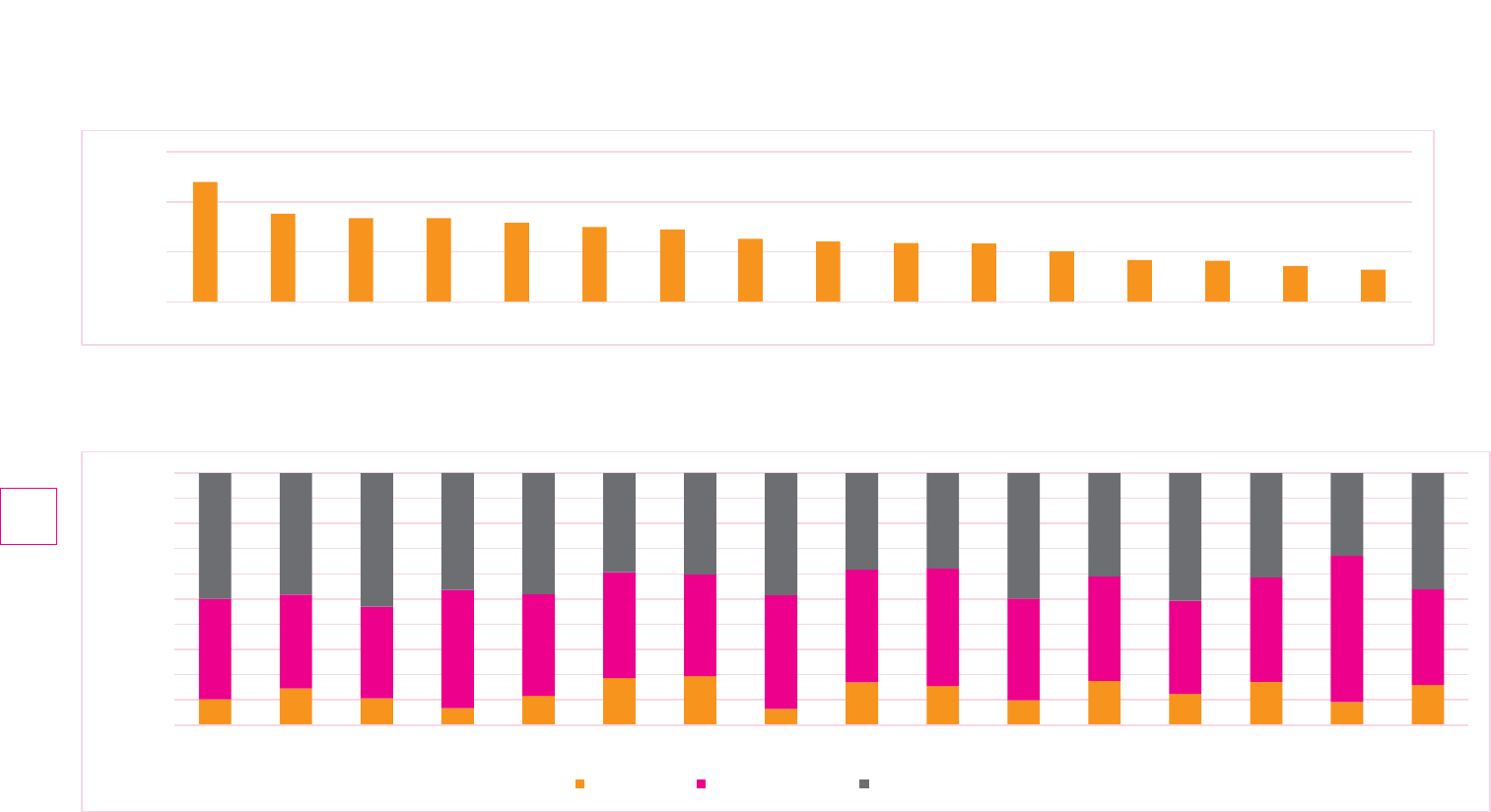
60
Figure 1. Proportion of weekly platform workers by country
Note: Estimates are adjusted by internet use using data from Eurostat, ICT Survey.
Figure 2. Distribution of types of platform work by country
12,0
8,8
8,4
8,4
7,9
7,5
7,2
6,3
6,0
5,9
5,8
5,1
4,2
4,1
3,6
3,2
0
5
10
15
ES IE NL UK PT DE RO IT HR LT FR SE CZ SK HU FI
Proportion (%)
10
15
11
7
12
19
19
6
17
16
10
18
12
17
9
16
40
37
36
47
40
42
40
45
45
47
40
41
37
41
58
38
50
48
53
46
48
39
40
49
38
38
50
41
51
41
33
46
0
10
20
30
40
50
60
70
80
90
100
ES IE NL UK PT DE RO IT HR LT FR SE CZ SK HU FI
Proportion (%)
On-location Online low-skilled Online high-skilled

61
4.2 Regression results: the relationship between platform worker characteristics and
vulnerability to labour market risk
Table 2 shows the results of the logistic regressions on low income including only socio-economic
characteristics (Model 1) and adding the main task on platforms (Model 2). All results are presented
as Average Marginal Effects (AMEs) to facilitate comparison across models (Mood, 2010). Starting
with Model 1, relative to platform workers aged 16-25, prime-age workers’ probability of low income
is decreased by 26.7%, whereas there is no significant difference between younger and older workers
(41 or older). In addition, the risk of low income decreases with the level of education. Being in a
couple and having children are also associated with a decrease in the probability of low income. As
such, age, education and family characteristics appear to influence the risk of low income to platform
workers. In contrast, gender and immigration do not have a significant effect on the probability of
being in the low-income group for platform workers. This is contrary to what has been found by
studies on the general labour market and in existing studies examining gender pay gaps in the platform
economy, as laid out in the theoretical section. This could provide some first evidence that work in
the platform economy could indeed help to overcome income discrimination. However, these results
should be interpreted with caution, given the issues with linking income to work in the platform
economy and the small sample size of the regression, as elaborated in the previous section.
In a second step, information on the main task workers perform on platforms is added to the
regressions (Model 2). While the significance of socio-economic characteristics does not change, the
size of the AME of education and family characteristics on low income decreases, indicating that this
effect can be partly be explained by the different tasks higher-educated workers and workers with
family engage in on platforms. Nevertheless, education and family characteristics continue to have a
substantial effect in the full model. As regards the role of platform tasks, relative to online profes-
sional services, aligning with expectation, workers performing online microtasks are at significantly
higher probability (33.2%) of low income. In addition, doing online writing and translation work
(33.6%) and online software development and technology (34%) are also associated with a higher
probability of low income. Effects are also found for interactive services (29.6%) and on-location
services (20.5%). While these are only marginally significant, at significance level 10%, these effects
are nevertheless interesting, given the small sample size of the regression.

62
Table 2. Results of logistic regression on low income, average marginal effects, sample of 16 EU countries,
platform workers who do platform work at least weekly, 16-64
Y = Low income
Model 1
Model 2
Female
-0.044
-0.021
(0.055) (0.059)
Age (ref = 16-25)
26-40
-0.267***
-0.263***
(0.072) (0.068)
41-55
-0.119
-0.107
(0.105)
(0.085)
56-64
-0.249
-0.192
(0.159)
(0.194)
Education (ref = primary and lower secondary)
Upper secondary and post-secondary non-tertiary -0.284** -0.230*
(0.140)
(0.126)
Tertiary -0.284** -0.247**
(0.138)
(0.122)
Couple -0.125** -0.115**
(0.057)
(0.051)
Dependent children in household
-0.240***
-0.210***
(0.056) (0.055)
Foreign-born
0.008
0.055
(0.074) (0.058)
Main task on platform (ref = online professional services)
Online clerical and data entry tasks
0.060
(0.070)
Online creative and multimedia work
0.139
(0.131)
Online sales and marketing support work 0.114
(0.094)
Online software development and technology 0.340***
(0.095)
Online writing and translation work 0.336***
(0.098)
Online microtasks
0.322***
(0.104)
Interactive services
0.296*
(0.165)
Transportation and delivery services
-0.005
(0.093)
On-location services
0.205*
(0.105)
Observations
417
417
Country FE
Yes
Yes
Note: Standard errors in parentheses.
*** p<0.01, ** p<0.05, * p<0.1.
Regression results from logistic regression on low income.
All regression results weighted.
Regressions on low income exclude workers who gain less than 50% of their income in the platform economy.
Next, the results for working conditions are examined focusing on indicators for stress, long hours
and health and safety risk, as well as on the cumulative indicator for experiencing all three simulta-
neously. The results are shown in Table 3, for both a model including only socio-economic charac-

63
teristics (Model 1) and the full model (Model 2). In most cases, gender and immigration do not play
a role in influencing working conditions. However, women are more likely to work long hours on
platforms than men, in contrast to previous studies on the regular economy. It is possible that such
differences are observed due to the additional flexibility of platform hours compared to regular work,
so that women can combine this work with caretaking responsibilities, unlike other forms of employ-
ment, where they are more likely to work lower hours. However, this exploratory analysis cannot
definitely claim to identify such pathways.
There are also age patterns, in that prime-age workers are more likely to experience health and
safety risks at work, as well as work long hours, as expected. In contrast, relative to workers aged
16-25, somewhat older workers (41-55) are less likely to report feeling stressed or experiencing health
risks at work, while there is no significant difference to older workers. With regard to all three indi-
cators of inferior working conditions, as expected, higher levels of education decrease the probability
of experiencing them. Hence, the platform economy reflects patterns found in the overall labour
market, where skills, and educational qualifications which function as signals of skills, are a significant
determinant of labour market risk in the form of working conditions. Finally, family characteristics
play a role as expected, in that being in a couple or having children in the household increases the
risk of inferior working conditions. As regards the cumulative measure of working conditions, the
probability of experiencing all three inferior working conditions increases for prime-age workers
(11.7%) and those with children (9.8%) but decreases significantly with higher levels of education.
Overall, therefore, the patterns found in the general labour market, elaborated on in the theoretical
section, appear to be reflected in the platform economy, workers with lower education or with family
are at higher risk of inferior working conditions.
Once the task content of platform work is added to the model, as seen in Model 2, most effects of
socio-economic characteristics persist, and the size of effects does not change substantially. However,
the influence of being in a couple on perceived health and safety risk becomes insignificant, sug-
gesting that this effect is driven by individuals in a couple working in different types of tasks than
those who are single. As regards the role of types of platform tasks as such, interesting patterns are
found. Contrary to expectation, it does not appear that low-skilled platform work is associated with
inferior working conditions. Rather, relative to online professional services, online microtasks and
online writing translation work are associated with a lower probability of perceived inferior working
conditions, on all measures. In addition, online creative and multimedia work is associated with a
lower probability of working long hours (14.2%) compared to online professional services, while
transportation and delivery services are associated with a lower probability of health and safety risk
(19.8%). Hence, it appears that the inferior working conditions associated with platform work are
not only experienced by workers performing low-skilled tasks. However, it should be borne in mind
that these results are based on the subjective evaluation of workers in these tasks. It may be the case
that workers in higher-skilled tasks evaluate working conditions differently to those in lower-skilled
tasks, which could influence results, for instance due to different relative benchmarks in the classic
labour market. In addition, examination of the source data revealed that in the categories found to
be significantly different from online professional services, comparatively lower proportions of
workers derive at least 50% of their income from platform work or do platform work daily.
33
The
subjective evaluation of platform work as more dangerous and stressful could thus be a result of
greater dependency on it.
33 The shares of these types of platform workers by type of platform work task are shown in the Appendix, Table a9.

64
Table 3. Results of logistic regression on different measures of working conditions, average marginal effects, sample of 16 EU countries, platform workers who do platform work
at least weekly, 16-64
Y = Stress Y = Long hours Y = Health risk Y = Working conditions
(cumulative)
Model 1
Model 2
Model 1
Model 2
Model 1
Model 2
Model 1
Model 2
Female
0.010
0.017
0.055*
0.062**
-0.023
-0.016
0.027
0.033
(0.032)
(0.031)
(0.030)
(0.029)
(0.031)
(0.031)
(0.030)
(0.030)
Age (ref = 16-25)
26-40 -0.005 -0.001 0.133*** 0.134*** 0.096** 0.099*** 0.117*** 0.117***
(0.039)
(0.038)
(0.037)
(0.036)
(0.038)
(0.037)
(0.036)
(0.036)
41-55 -0.183*** -0.168*** -0.014 -0.004 -0.108** -0.099** -0.045 -0.039
(0.045)
(0.044)
(0.045)
(0.044)
(0.044)
(0.043)
(0.038)
(0.038)
56-64 -0.104 -0.100 -0.026 -0.038 -0.059 -0.064 -0.011 -0.016
(0.075)
(0.072)
(0.073)
(0.069)
(0.072)
(0.069)
(0.067)
(0.064)
Education (ref = primary and lower secondary)
Upper secondary and post-secondary non-tertiary
-0.097**
-0.093*
-0.077*
-0.077*
-0.098**
-0.096**
-0.125**
-0.127**
(0.049) (0.049) (0.046) (0.045) (0.049) (0.048) (0.049) (0.050)
Tertiary
-0.128***
-0.131***
-0.117***
-0.121***
-0.155***
-0.165***
-0.166***
-0.174***
(0.047) (0.047) (0.045) (0.044) (0.047) (0.047) (0.046) (0.048)
Couple
0.058*
0.039
0.064**
0.034
0.084**
0.057*
0.063*
0.046
(0.034) (0.034) (0.033) (0.032) (0.033) (0.032) (0.032) (0.032)
Dependent children in household
0.081**
0.078**
0.119***
0.107***
0.092***
0.088***
0.098***
0.094***
(0.035) (0.035) (0.032) (0.031) (0.034) (0.034) (0.033) (0.034)
Foreign-born
-0.027
-0.040
0.005
-0.014
0.060
0.044
0.046
0.039
(0.046)
(0.047)
(0.044)
(0.044)
(0.046)
(0.046)
(0.040)
(0.041)

65
Table 3. Results of logistic regression on different measures of working conditions, average marginal effects, sample of 16 EU countries, platform workers who do platform work
at least weekly, 16-64 (continued)
Y = Stress Y = Long hours Y = Health risk Y = Working conditions
(cumulative)
Model 1
Model 2
Model 1
Model 2
Model 1
Model 2
Model 1
Model 2
Main task on platform (ref = online professional services)
Online clerical and data entry tasks -0.071 -0.045 -0.028 -0.043
(0.057)
(0.051)
(0.054)
(0.057)
Online creative and multimedia work
0.002
-0.128**
-0.032
-0.071
(0.059) (0.057) (0.060) (0.061)
Online sales and marketing support work
-0.060
-0.099*
-0.101*
-0.078
(0.061) (0.057) (0.060) (0.061)
Online software development and technology
-0.061
-0.039
-0.032
-0.087
(0.068) (0.065) (0.064) (0.066)
Online writing and translation work
-0.119*
-0.127**
-0.107*
-0.137**
(0.063)
(0.060)
(0.061)
(0.064)
Online microtasks -0.244*** -0.324*** -0.266*** -0.230***
(0.061)
(0.055)
(0.057)
(0.057)
Interactive services -0.137* -0.042 0.001 -0.098
(0.075)
(0.065)
(0.072)
(0.073)
Transportation and delivery services -0.088 -0.089 -0.198*** -0.126*
(0.078)
(0.070)
(0.076)
(0.076)
On-location services -0.011 -0.048 -0.036 -0.050
(0.077)
(0.071)
(0.077)
(0.082)
Observations 2,722 2,722 2,722 2,722 2,722 2,722 2,722 2,722
Country FE
Yes
Yes
Yes
Yes
Yes
Yes
Yes
Yes
* Standard errors in parentheses.
*** p<0.01, ** p<0.05, * p<0.1.
Regression results from logistic regression stress, long hours, health risk and a cumulative measure of working conditions.
All regression results weighted.

66
Finally, the results for regressions on over- and undereducation of platform workers are evaluated
(Table 4). These regressions do not include variables on education or main platform task, as the
dependent variable is constructed from these two indicators. Hence, the second step of the regres-
sions is not conducted for educational mismatch. The results show that socio-economic characteris-
tics do have an influence on educational mismatch. Matching the results of most general labour eco-
nomics literature, female platform workers are more likely to be overeducated than male platform
workers (6.7%) and, conversely, are less likely to be undereducated (7.2%). With regard to age pat-
terns, it is evident that the likelihood of undereducation decreases with age, that is, younger workers
are more likely to be undereducated. Conversely, the group of mid-age workers (41-55) is most likely
to be overeducated, rather than the reference group of workers aged 16-25. Similarly, contrary to
findings for the general labour market, platform workers with an immigrant background are less likely
to be overeducated (16.5%), and more likely to be undereducated (10.5%). This could suggest that
workers such as the young and migrants, who may be struggling to access the regular labour market
due to a lack of official qualifications or experience, or difficulties in transferring these to the domestic
labour market, can apply these skills in the platform economy, potentially providing a stepping stone
to the regular labour market eventually. Finally, family patterns are unsystematic - individuals in
couples are less likely to be undereducated while those with children are more likely to be over-
educated.

67
Table 4. Results of logistic regression on platform work potential risk factors, average marginal effects,
sample of 16 EU countries, platform workers who do platform work at least weekly, 16-64
VARIABLES Overeducated Undereducated
Female 0.067** -0.072**
(0.030) (0.030)
Age (ref = 16-25)
26-40 0.031 -0.074*
(0.035) (0.038)
41-55 0.086** -0.109**
(0.042) (0.043)
56-64 0.038 -0.137**
(0.066) (0.059)
Education (ref = primary and lower secondary)
Upper secondary and post-secondary non-tertiary
Tertiary
Couple 0.017 -0.076**
(0.031) (0.031)
Dependent children in household -0.066** -0.023
(0.032) (0.033)
Foreign-born -0.165*** 0.107***
(0.044) (0.039)
Observations 2,853 2,853
Country FE Yes Yes
Note: Standard errors in parentheses.
*** p<0.01, ** p<0.05, * p<0.1.
Regression results from logistic regression overeducated and undereducated.
All regression results weighted.

68
5. Conclusion
Platform work is a labour market phenomenon that is increasingly attracting the attention of
researchers. To add to this growing body of work, this exploratory study has sought to examine the
factors which influence the vulnerability of platform workers to labour market risk. There are reasons
to believe that platform workers are indeed vulnerable to labour market risk, including low income,
inferior working conditions - in form of stress, long working hours and health and safety risk - and
educational mismatch. However, the analysis using a high-quality data set on the platform economy,
the 2018 COLLEEM survey, showed that not all platform workers are equally vulnerable to such
risks. This is not a surprising finding, given the large heterogeneity in both the composition of the
platform workforce and the nature of tasks carried out on platforms.
While lower levels of education appear to significantly increase the likelihood of all types of labour
market risk, the influence of socio-demographic characteristics is more heterogeneous. Though non-
prime-age and single platform workers are most at risk of low income, it is prime-age platform
workers as well as platform workers in couples or with children that are most likely to report expe-
riencing inferior working conditions on platform. In contrast, gender and immigration play a limited
role. This is a contrast to findings of literature on the stratification of labour market risk within the
overall working population, which tends to find that these characteristics are significant in influencing
labour market divides. Hence, factors that typically stratify labour markets appear to matter less in
platform work than in the general labour market, or even work in the opposite direction in some
cases. However, this exploratory study cannot definitely make such a claim, particularly given the
limitations of the data available.
Equally, the influence of types of platform work tasks on labour market risk is complex. Lower-
skilled platform work tasks, such as online microtasks, are associated with increased risk of low
income relative to higher-skilled online tasks. However, it is in fact workers in higher-skilled types of
platform work, such as online professional services, that appear particularly vulnerable to experienc-
ing inferior working conditions in platform work. While one should be careful to draw definitive
conclusions based on this first explorative study on this topic, this suggests that the relation between
types of platform work and labour market risk is more nuanced than might be thought initially.
While a significant contribution to existing research on the platform economy, this study has several
limitations. First, there are significant issues with online panel surveys such as COLLEEM, as laid
out by Pesole et al. (2018), including the potential lack of generalisability of results given the sampling
strategy. Second, the small sample size of the data set does not allow for a disaggregated analysis by
country, which would add an important dimension. Third, as detailed in the methodological section,
given the nature of the data set, several approximations have to be used in the measurement of labour
market risk.
As such, the results should be interpreted with caution and further research is needed to supple-
ment the evidence of this study. However, this would require providing higher-quality data on plat-
form workers. While the COLLEEM data set is a very welcome step in this direction, large-scale
representative surveys on platform workers are still lacking. In particular, it would be desirable to add
items on platform work to existing data sets, such as the European Labour Force Survey. In addition,
longitudinal data is needed to examine moves into and out of platform work and their implications.
This would enable researchers, for instance, to examine whether platform work can serve as a step-
ping stone to regular employment.

69
Ultimately, this study underlines, similar to previous research, the large heterogeneity in platform
work. This extends not only to the types of platform work, but also to working conditions and other
labour market circumstances associated with it. For future research, but also for policy decisions on
the platform economy, it is essential that this heterogeneity is adequately taken into account.

70
appendix 1
Table a1. Skill level allocated to platform work task groups
Task Corresponding education level
Online clerical and data-entry tasks (e.g. customer services, data
entry, transcription and similar)
Primary and lower secondary education
Online professional services (e.g. accounting, legal, project
management and similar)
Tertiary education
Online creative and multimedia work (e.g. animation, graphic
design, photo editing and similar)
Tertiary education
Online sales and marketing support work (e.g. lead generation,
posting ads, social media management, search engine optimisa-
tion and similar)
Tertiary education
Online software development and technology work (e.g. data
science, game development, mobile development and similar)
Tertiary education
Online writing and translation work (e.g. article writing, copy-
writing, proofreading, translation and similar)
Upper secondary and post-secondary non-tertiary educa-
tion
Online microtasks (e.g. object classification, tagging content
review, website feedback and similar)
Primary and lower secondary education
Interactive services (e.g. language teaching, interactive online
lessons, interactive consultations and similar)
Upper secondary and post-secondary non-tertiary educa-
tion
Transportation and delivery services (e.g. driving, food delivery,
moving services and similar)
Primary and lower secondary education
On-location services (e.g. housekeeping, beauty services, on-
location services and similar)
Primary and lower secondary education

71
Table a2. Descriptive statistics on the sample composition, weekly platform workers 16-64, weighted sample
Variable Proportion (in %)
Female 34.80
Age
16-25 26.63
26-40 48.20
41-55 19.57
56-74 5.61
Education
Primary 17.17
Upper secondary/Post-secondary non-tertiary 39.15
Tertiary 43.69
In a couple 65.79
Dependent children in household 72.25
Not resident in country of birth 15.03
Main platform work task
Online clerical and data entry 15.42
Online professional services 10.75
Online creative and multimedia work 12.43
Online sales and marketing support 13.02
Online software development and technological support 9.85
Online writing and translation 9.39
Online microtasks 12.05
Interactive services 5.48
Transportation and delivery 6.22
On-location services 5.40
Lowest quartile of income distribution 25.29
High stress through work 53.55
High health risk 52.31
Work > 10h per day 61.85
Working conditions - cumulative 31.81
Educational mismatch
No mismatch 34.31
Undereducated 26.14
Overeducated 39.54
Note: Data on low income includes only respondents who gain at least 50% of their income from platform work.

72
Table a3. Crosstabulation, dependent variables and independent variables, weekly platform workers 16-64, weighted sample
Variable Low income
(%)
High stress
(%)
Long hours
(%)
Health risk
(%)
Working
conditions –
cumulative
Undereducated
(%)
Overeducated
(%)
Gender
Men
26.15
53.7
60.4
53.14
31.16
28.51
37.39
Female
23.79
53.27
64.57
50.73
33.03
21.76
43.53
Age
16-25 41.84 56.42 55.02 49.73 26.45 34.24 36.08
26-40
12.5
57.9
69.7
60.07
39.63
24.51
38.94
41-55 26.17 41.18 55.42 40 22.29 21.11 45.23
56-74
11.66
45.53
49.24
40.5
22.82
19.18
41.26
Education
Primary 56.25 60.98 66.79 61.22 42.48 60.25 0
Upper secondary/Post-secondary non-tertiary
26.59
51.86
59.92
50.76
29.24
40.36
43.9
Tertiary
17.39
51.23
60.82
49.24
28.55
0
51.17
Family characteristics
Not in a couple 41.36 52.19 57.2 47.88 28.21 33.92 37.29
In a couple
16.84
54.25
64.27
54.58
33.66
22.19
40.69
No dependent children in household 53.83 46.99 51.29 42.98 23.23 28.28 45.26
Dependent children in household
16.22
56.05
65.9
55.89
35.09
25.32
37.34
Residency status
Resident in country of birth
22.87
52.91
61.01
50.46
29.87
24.39
42
Not resident in country of birth
36.97
57.14
66.57
62.74
42.75
36.39
25.13

73
Table a3. Crosstabulation, dependent variables and independent variables, weekly platform workers 16-64, weighted sample (continued)
Variable Low income
(%)
High stress
(%)
Long hours
(%)
Health risk
(%)
Working
conditions –
cumulative
Undereducated
(%)
Overeducated
(%)
Main platform work task
Online clerical and data entry
16.54
54.64
68.24
57.37
36.71
0
86.35
Online professional services
11.31
60.95
72.14
60
40.03
41.48
0
Online creative and multimedia work 27.37 62.23 59.4 58.45 35.97 54.68 0
Online sales and marketing support
12.9
54.75
63.66
51.48
33.17
61.38
0
Online software development and technological
support
59.24 57.03 68.43 59.38 33.59 54.57 0
Online writing and translation 37.21 46.45 56.58 47.06 24.33 6.34 53.65
Online microtasks
43.42
36.71
37.48
31.78
16.91
0
82.59
Interactive services 24.26 50.29 70.96 63.01 33.52 18.5 38.32
Transportation and delivery
7.78
53.64
63.21
42.25
28.89
0
74.75
On-location services
32.5
60.05
65.1
53.45
33.33
0
80.88
Note: Data on low income includes only respondents who gain at least 50% of their income from platform work.

74
Table a4. Results of logistic regression on platform work potential risk factors, average marginal effects, sample of 16 EU countries, platform workers who do platform work at
least monthly, 16-64
Variables Low income Stress Long hours Health risk Working
conditions
(cumulative)
Overeducated Undereducated
Female -0.029 0.027 0.047* -0.010 0.031 0.071*** -0.069***
(0.055)
(0.027)
(0.026)
(0.026)
(0.025)
(0.025)
(0.025)
Age (ref = 16-25)
26-40
-0.293***
-0.003
0.133***
0.105***
0.112***
0.060**
-0.105***
(0.063) (0.033) (0.032) (0.032) (0.030) (0.029) (0.032)
41-55
-0.123
-0.146***
0.004
-0.083**
-0.040
0.111***
-0.122***
(0.083) (0.038) (0.038) (0.038) (0.032) (0.036) (0.037)
56-64
-0.210
-0.143**
-0.012
-0.082
-0.039
0.092
-0.143***
(0.197) (0.063) (0.060) (0.059) (0.052) (0.058) (0.051)
Education (ref = primary and lower secondary)
Upper secondary and post-secondary non-tertiary
-0.270**
-0.105**
-0.077*
-0.109**
-0.139***
(0.113)
(0.043)
(0.041)
(0.042)
(0.043)
Tertiary -0.294*** -0.147*** -0.115*** -0.166*** -0.175***
(0.109)
(0.041)
(0.040)
(0.041)
(0.041)
Couple -0.120*** 0.036 0.030 0.059** 0.041 0.015 -0.051*
(0.045)
(0.028)
(0.028)
(0.028)
(0.027)
(0.027)
(0.027)
Dependent children in household -0.196*** 0.069** 0.102*** 0.101*** 0.090*** -0.074*** -0.010
(0.052)
(0.029)
(0.028)
(0.029)
(0.028)
(0.027)
(0.027)
Foreign-born
0.076
-0.005
0.033
0.078**
0.057*
-0.138***
0.102***
(0.054) (0.040) (0.038) (0.039) (0.034) (0.038) (0.033)

75
Table a4. Results of logistic regression on platform work potential risk factors, average marginal effects, sample of 16 EU countries, platform workers who do platform work at
least monthly, 16-64 (continued)
Variables Low income Stress Long hours Health risk Working
conditions
(cumulative)
Overeducated Undereducated
Main task on platform (ref = online professional
services)
Online clerical and data entry tasks
0.084
-0.114**
-0.061
-0.049
-0.084*
(0.069) (0.049) (0.047) (0.048) (0.049)
Online creative and multimedia work
0.149
-0.025
-0.114**
-0.066
-0.096*
(0.124) (0.051) (0.050) (0.052) (0.051)
Online sales and marketing support work
0.144*
-0.061
-0.073
-0.064
-0.069
(0.083) (0.053) (0.050) (0.052) (0.053)
Online software development and technology
0.343***
-0.094
-0.034
-0.090
-0.118**
(0.086) (0.058) (0.058) (0.057) (0.055)
Online writing and translation work
0.310***
-0.172***
-0.184***
-0.131**
-0.190***
(0.095)
(0.052)
(0.052)
(0.053)
(0.052)
Online microtasks 0.296*** -0.281*** -0.313*** -0.231*** -0.244***
(0.085)
(0.051)
(0.050)
(0.051)
(0.048)
Interactive services 0.329** -0.136** -0.060 0.002 -0.116*
(0.161)
(0.064)
(0.062)
(0.061)
(0.061)
Transportation and delivery services 0.113 -0.048 -0.085 -0.140** -0.097
(0.098)
(0.066)
(0.063)
(0.066)
(0.066)
On-location services
0.232**
-0.059
-0.039
-0.024
-0.061
(0.091) (0.065) (0.061) (0.065) (0.069)
Observations 475 3,628 3,628 3,628 3,628 3,800 3,800
Country FE
Yes
Yes
Yes
Yes
Yes
Yes
Yes
* Note: Standard errors in parentheses.
*** p<0.01, ** p<0.05, * p<0.1.
Regression results from logistic regression stress, long hours, health risk and a cumulative measure of working conditions.
All regression results weighted.
Regressions on low income only include respondents who gain at least 50% of their income from platform work.

76
Table a5. Results of logistic regression on platform work potential risk factors, average marginal effects, platform workers who do platform work at least weekly
Variables Low income Stress Long hours Health risk Working
conditions
(cumulative)
Overeducated Undereducated
Female -0.015 0.028 0.048* -0.016 -0.010 0.069** -0.078***
(0.059)
(0.026)
(0.025)
(0.030)
(0.026)
(0.030)
(0.030)
Age (ref = 16-25)
26-40
-0.263***
-0.004
0.132***
0.098***
0.105***
0.031
-0.075**
(0.068) (0.033) (0.032) (0.037) (0.032) (0.035) (0.038)
41-55
-0.109
-0.148***
0.003
-0.094**
-0.084**
0.087**
-0.110**
(0.085) (0.038) (0.038) (0.043) (0.038) (0.042) (0.043)
56-74
-0.265
-0.162***
-0.016
-0.082
-0.071
0.075
-0.124**
(0.174) (0.057) (0.054) (0.062) (0.054) (0.060) (0.054)
Education (ref = primary and lower secondary)
Upper secondary and post-secondary non-tertiary
-0.228*
-0.103**
-0.082**
-0.110**
-0.116***
(0.125)
(0.043)
(0.040)
(0.047)
(0.042)
Tertiary -0.251** -0.144*** -0.123*** -0.176*** -0.173***
(0.119)
(0.041)
(0.039)
(0.046)
(0.041)
Couple -0.108** 0.037 0.035 0.059* 0.058** 0.013 -0.072**
(0.049)
(0.028)
(0.027)
(0.032)
(0.028)
(0.031)
(0.031)
Dependent children in household -0.197*** 0.073** 0.100*** 0.092*** 0.101*** -0.061* -0.032
(0.053)
(0.029)
(0.027)
(0.033)
(0.029)
(0.032)
(0.032)
Foreign-born
0.058
-0.005
0.035
0.036
0.075*
-0.163***
0.107***
(0.056) (0.040) (0.038) (0.045) (0.039) (0.043) (0.038)

77
Table a5. Results of logistic regression on platform work potential risk factors, average marginal effects, platform workers who do platform work at least weekly (continued)
Variables Low income Stress Long hours Health risk Working
conditions
(cumulative)
Overeducated Undereducated
Main task on platform (ref = online professional
services)
Online clerical and data entry tasks
0.059
-0.112**
-0.067
-0.028
-0.049
(0.072) (0.049) (0.046) (0.053) (0.048)
Online creative and multimedia work
0.138
-0.026
-0.109**
-0.029
-0.061
(0.135) (0.051) (0.050) (0.059) (0.052)
Online sales and marketing support work
0.109
-0.063
-0.078
-0.105*
-0.065
(0.091) (0.052) (0.050) (0.058) (0.052)
Online software development and technology
0.336***
-0.095
-0.034
-0.033
-0.086
(0.098) (0.058) (0.057) (0.064) (0.057)
Online writing and translation work
0.336***
-0.166***
-0.190***
-0.097
-0.129**
(0.098)
(0.052)
(0.051)
(0.060)
(0.052)
Online microtasks 0.323*** -0.280*** -0.317*** -0.264*** -0.232***
(0.105)
(0.051)
(0.049)
(0.056)
(0.051)
Interactive services 0.209 -0.141** -0.073 -0.001 0.014
(0.163)
(0.063)
(0.060)
(0.071)
(0.061)
Transportation and delivery services -0.001 -0.043 -0.088 -0.192** -0.137**
(0.093)
(0.065)
(0.062)
(0.075)
(0.065)
On-location services
0.201*
-0.052
-0.040
-0.036
-0.024
(0.106) (0.065) (0.061) (0.076) (0.065)
Observations 419 2,769 2,769 2,769 2,769 2,904 2,904
Country FE
Yes
Yes
Yes
Yes
Yes
Yes
Yes
* Note: Standard errors in parentheses.
*** p<0.01, ** p<0.05, * p<0.1.
Regression results from logistic regression stress, long hours, health risk and a cumulative measure of working conditions.
All regression results weighted.
Regressions on low income only include respondents who gain at least 50% of their income from platform work.

78
Table a6. Results of linear probability model, regression on low income, sample of 16 EU countries, platform
workers who do platform work at least weekly, 16-64
Y = Low income
Model 1
Model 2
Female
-0.026
-0.005
(0.050) (0.051)
Age (ref = 16-25)
26-40
-0.229***
-0.223***
(0.065) (0.061)
41-55
-0.118
-0.117
(0.098)
(0.087)
56-64
-0.243*
-0.192
(0.137)
(0.137)
Education (ref = primary and lower secondary)
Upper secondary and post-secondary non-tertiary -0.268** -0.249**
(0.115)
(0.107)
Tertiary -0.267** -0.259**
(0.116)
(0.107)
Couple -0.142** -0.112*
(0.066)
(0.057)
Dependent children in household
-0.303***
-0.268***
(0.072) (0.068)
Foreign-born
0.018
0.041
(0.077) (0.064)
Main task on platform (ref = online professional services)
Online clerical and data entry tasks
0.042
(0.064)
Online creative and multimedia work
0.105
(0.096)
Online sales and marketing support work 0.076
(0.077)
Online software development and technology 0.336***
(0.098)
Online writing and translation work 0.308***
(0.112)
Online microtasks
0.299***
(0.108)
Interactive services
0.220
(0.138)
Transportation and delivery services
-0.020
(0.097)
On-location services
0.161
(0.122)
Observations
417
417
Country FE
Yes
Yes
Note: Standard errors in parentheses.
*** p<0.01, ** p<0.05, * p<0.1.
Regression results from logistic regression on low income.
All regression results weighted.
Regressions on low income exclude workers who gain less than 50% of their income in the platform economy.

79
Table a7. Results of linear probability model, regression on different measures of working conditions, sample of 16 EU countries, platform workers who do platform work at least
weekly, 16-64
Y = Stress Y = Long hours Y = Health risk Y = Working conditions
(cumulative)
Model 1
Model 2
Model 1
Model 2
Model 1
Model 2
Model 1
Model 2
Female
-0.001
0.005
0.051*
0.057**
-0.023
-0.017
0.029
0.033
(0.032) (0.032) (0.030) (0.029) (0.031) (0.031) (0.031) (0.031)
Age (ref = 16-25)
26-40
-0.007
-0.004
0.129***
0.128***
0.096**
0.097***
0.117***
0.118***
(0.038) (0.038) (0.036) (0.035) (0.038) (0.037) (0.037) (0.037)
41-55
-0.171***
-0.160***
-0.006
-0.001
-0.105**
-0.095**
-0.049
-0.041
(0.045)
(0.044)
(0.045)
(0.043)
(0.045)
(0.043)
(0.040)
(0.040)
56-64 -0.095 -0.094 -0.037 -0.052 -0.059 -0.066 -0.011 -0.019
(0.074)
(0.073)
(0.072)
(0.069)
(0.071)
(0.069)
(0.066)
(0.063)
Education (ref = primary and lower secondary)
Upper secondary and post-secondary non-tertiary -0.094* -0.087* -0.061 -0.059 -0.103** -0.103** -0.126** -0.125**
(0.050)
(0.050)
(0.048)
(0.047)
(0.050)
(0.049)
(0.050)
(0.050)
Tertiary -0.123*** -0.122** -0.097** -0.100** -0.159*** -0.170*** -0.167*** -0.174***
(0.048)
(0.048)
(0.046)
(0.046)
(0.048)
(0.047)
(0.047)
(0.048)
Couple
0.046
0.026
0.057*
0.028
0.084**
0.059*
0.063*
0.045
(0.034) (0.034) (0.033) (0.032) (0.033) (0.033) (0.033) (0.033)
Dependent children in household
0.080**
0.074**
0.125***
0.110***
0.094***
0.090***
0.094***
0.087***
(0.035) (0.035) (0.033) (0.033) (0.035) (0.035) (0.032) (0.032)
Foreign-born
-0.027
-0.037
0.005
-0.009
0.055
0.041
0.053
0.045
(0.046) (0.046) (0.042) (0.042) (0.045) (0.045) (0.046) (0.041)

80
Table a7. Results of linear probability model, regression on different measures of working conditions, sample of 16 EU countries, platform workers who do platform work at least
weekly, 16-64 (continued)
Y = Stress Y = Long hours Y = Health risk Y = Working conditions
(cumulative)
Model 1
Model 2
Model 1
Model 2
Model 1
Model 2
Model 1
Model 2
Main task on platform (ref = online professional services)
Online clerical and data entry tasks
-0.063
-0.044
-0.030
-0.042
(0.057)
(0.050)
(0.055)
(0.059)
Online creative and multimedia work
-0.017
-0.143**
-0.037
-0.072
(0.060) (0.058) (0.060) (0.062)
Online sales and marketing support work
-0.073
-0.095*
-0.105*
-0.080
(0.061) (0.055) (0.060) (0.063)
Online software development and technology
-0.054
-0.046
-0.036
-0.087
(0.067) (0.063) (0.064) (0.068)
Online writing and translation work
-0.124**
-0.136**
-0.104*
-0.136**
(0.063)
(0.060)
(0.061)
(0.063)
Online microtasks
-0.244***
-0.337***
-0.266***
-0.227***
(0.061)
(0.055)
(0.057)
(0.058)
Interactive services -0.119 -0.036 -0.004 -0.095
(0.074)
(0.062)
(0.071)
(0.076)
Transportation and delivery services -0.084 -0.092 -0.200** -0.128
(0.079)
(0.070)
(0.078)
(0.079)
On-location services 0.014 -0.054 -0.039 -0.054
(0.077)
(0.071)
(0.078)
(0.082)
Observations 2,722 2,722 2,722 2,722 2,722 2,722 2,722 2,722
Country FE
Yes
Yes
Yes
Yes
Yes
Yes
Yes
Yes
Note: Standard errors in parentheses.
*** p<0.01, ** p<0.05, * p<0.1.
Regression results from logistic regression stress, long hours, health risk and a cumulative measure of working conditions.
All regression results weighted.

81
Table a8. Results of linear probability model, regression on educational mismatch, sample of 16 EU countries,
platform workers who do platform work at least weekly, 16-64
Variables Overeducated Undereducated
Female
0.068**
-0.071**
(0.031) (0.029)
Age (ref = 16-25)
26-40
0.031
-0.075**
(0.035) (0.038)
41-55
0.087**
-0.108**
(0.042) (0.043)
56-64
0.040
-0.139**
(0.066)
(0.059)
Education (ref = primary and lower secondary)
Upper secondary and post-secondary non-tertiary
Tertiary
Couple 0.016 -0.081**
(0.031)
(0.033)
Dependent children in household
-0.068**
-0.026
(0.033) (0.033)
Foreign-born
-0.153***
0.116**
(0.038) (0.045)
Observations 2,853 2,853
Country FE
Yes
Yes
Note: Standard errors in parentheses.
*** p<0.01, ** p<0.05, * p<0.1.
Regression results from logistic regression overeducated and undereducated.
All regression results weighted.

82
Table a9. Share of platform workers gaining at least 50% of income from platform work and working on plat-
form daily or almost daily by type of platform work, employees 16-64, platform workers doing plat-
form work at least weekly, weighted sample
Type of platform work
Proportion gaining at least 50% of
income from platform work
Proportion working on platforms
daily or almost daily
Online clerical and data-entry tasks
(e.g. customer services, data entry,
transcription and similar)
17.00
52.06
Online professional services (e.g.
accounting, legal, project management
and similar)
21.54
52.87
Online creative and multimedia work
(e.g. animation, graphic design, photo
editing and similar)
12.99 46.49
Online sales and marketing support
work (e.g. lead generation, posting ads,
social media management, search
engine optimisation and similar)
12.8 44.48
Online software development and
technology work (e.g. data science,
game development, mobile develop-
ment and similar)
12.09 48.06
Online writing and translation work
(e.g. article writing, copywriting, proof-
reading, translation and similar)
12.20
42.46
Online microtasks (e.g. object classifi-
cation, tagging content review, website
feedback and similar)
8.24 45.52
Interactive services (e.g. language
teaching, interactive online lessons,
interactive consultations and similar)
4.17
41.57
Transportation and delivery services
(e.g. driving, food delivery, moving ser-
vices and similar)
8.83
36.06
On-location services (e.g. house-
keeping, beauty services, on-location
services and similar)
13.32 38.81

83
References
Aleksynska, M., Bastrakova, A., & Kharchenko, N. (2019). Working Conditions on Digital Labour Platforms:
Evidence from a Leading Labour Supply Economy. IZA Discussion Paper No. 12245.
Allaire, N., et al. (2019). Covering risks for platform workers in the digital age. Available at:
https://www.sciencespo.fr/public/chaire-numerique/wp-content/uploads/2019/05/covering-risks-
plateform-workers-digital-age.pdf.
Allen, J., & van der Velden, R. (2001). Educational mismatches versus skill mismatches: Effects on wages, job
satisfaction, and on-the-job search’, Oxford Economic Papers, 53(3), 434–452. doi: 10.1093/oep/53.3.434.
Anxo, D., & Karlsson, M. (2019). Overtime work: A review of literature and initial empirical analysis. Conditions of
Work and Employment Series No. 104. Geneva: International Labour Office.
Berg, J. (2016). Income security in the on-demand economy: findings and policy lessons from a survey of
crowdworkers, Comparative labor law and policy journal, 37(3), 506–543.
Berg, J. M., et al. (2018). Digital labour platforms and the future of work: Towards decent work in the online
world. Geneva: International Labour Office.
Blau, F.D., & Kahn, L.M. (2017). The Gender Wage Gap:Extent, trends, and Explanations, Journal of Economic
Literature, 55(3), 789–865.
Cantarella, M., & Strozzi, C. (2019). Workers in the Crowd: The Labour Market Impact of the Online Platform
Economy. IZA Discussion Paper No. 12327.
Card, D. (1999). The causal effect of education on earnings, in Ashenfelter, O. & Card, D. (eds) Handbook of
Labor Economics, Volume 3. Amsterdam: Elsevier, pp. 1801–1863. doi: 10.1016/S1573-4463(99)03011-4.
Cook, C. et al. (2020). The Gender Earnings Gap in the Gig Economy: Evidence from over a Million Rideshare
Drivers. NBER Working Paper 24732. doi: 10.3386/w24732.
EU OSHA (2017). Protecting workers in the online platform economy: An overview of regulatory and policy
developments in the EU. Luxembourg: Publications Office of the European Union. doi: 10.2802/918187.
Eurofound (2018). Employment and working conditions of selected types of platform work. Luxembourg:
Publications Office of the European Union. doi: 10.2806/42948.
Eurostat (2010). Health and safety at work in Europe. Luxembourg: Publications Office of the European Union.
doi: 10.2785/38630.
Fabo, B., Karanovic, J., & Dukova, K. (2017). In search of an adequate European policy response to the platform
economy, Transfer, 23(2), 163–175. doi: 10.1177/1024258916688861.
Foong, E., et al. (2018). Women (Still) Ask For Less, Proceedings of the ACM on Human-Computer Interaction,
2(CSCW). doi: 10.1145/3274322.
Forde, C., et al. (2017). The Social Protection of Workers in the Platform Economy. Luxembourg: Publications
Office of the European Union.
Fournier, J.-M., & Koske, I. (2012). The Determinants of Earnings Inequality: Evidence From Quantile Regressions’,
OECD Journal: Economic Studies, 2012(1), 5–36.
Garben, S. (2019). Tackling social disruption in the online platform economy. FEPS Policy Paper. Available at:
https://www.feps-europe.eu/attachments/publications/feps paper - garben - clean final.pdf
.
Gomez-Herrera, E., Martens, B., & Mueller-Langer, F. (2018). Trade, Competition and Welfare in Global Online
Labour Markets: A ‘Gig Economy’ Case Study. JRC Digital Economy Working Paper 2017-05. Luxembourg:
Publications Office of the European Union. doi: 10.2139/ssrn.3090929.
Green, S. B. (1991). How many subjects does it take to do a regression analysis?, Multivariate Behavioral
Research, 26(3), 499–510.
De Groen, W. P., & Maselli, I. (2016). The Impact of the Collaborative Economy on the Labour Market, CEPS
Special Report No. 138. Available at: http://aei.pitt.edu/76467/
.
ILO (2012). International Standard Classification of Occupations: Structure, Group Definitions and
Correspondence Tables. Geneva: International Labour Office.

84
Jain, A., & Leka, S. (2019). Occupation and Health, in Llewellyn, C. D. et al. (eds) Cambridge Handbook of
Psychology, Health and Medicine. Cambridge: Cambridge University Press, pp. 28–31.
Kilhoffer, Z., et al. (2020.) Study to gather evidence on the working conditions of platform workers. Luxembourg:
Publications Office of the European Union. doi: 10.2767/26582.
Kodz, J., et al. (2003). Working long hours: a review of the evidence. Volume 1—Main report. Employment
Relations Research Series 16. doi: 10.13140/2.1.4808.3527.
Lee, S., McCann, D., & Messenger, J.C. (2007). Working time around the world: Trends in working hours, laws
and policies in a global comparative perspective. Geneva: International Labour Organization.
doi: 10.4324/9780203945216.
Mackenzie, C., Rogers, W. & Dodds, S. (2014). Introduction: What is Vulnerability and Why Does It Matter for
Moral Theory?’, in Mackenzie, C., Rogers, W., and Dodds, S. (eds) Vulnerability: New essays in ethics and
feminist philosophy. Oxford: Oxford University Press.
Marinaccio, A., et al. (2013). ‘The relevance of socio-demographic and occupational variables for the
assessment of work-related stress risk’, BMC Public Health, 13(1). doi: 10.1186/1471-2458-13-1157.
Mood, C. (2010). Logistic regression: Why we cannot do what we think we can do, and what we can do about
it, European Sociological Review, 26(1), 67–82. doi: 10.1093/esr/jcp006.
OECD (2013). Skills Outlook 2013: First Results from the Survey of Adult Skills. Paris: OECD Publishing.
Pérez, E.R., et al. (2012). Differences in working conditions and employment arrangements among migrant and
non-migrant workers in Europe’, Ethnicity and Health, 17(6), 563–577. doi: 10.1080/13557858.2012.730606.
Pesole, A., et al. (2018). Platform Workers in Europe: Evidence from the COLLEEM Survey. Luxembourg:
Publications Office of the European Union. doi: 10.2760/742789.
Piha, K., et al. (2013). Socio-economic and occupational determinants of work injury absence, European
Journal of Public Health, 23(4), 693–698. doi: 10.1093/eurpub/cks162.
Quintini, G. (2011a). Over-Qualified or Under-Skilled : A Review of Existing Literature. OECD Social, Employment
and Migration Working Papers No. 121. Paris: OECD Publishing.
Quintini, G. (2011b). Right for the Job : Over-Qualified or Under-Skilled ? OECD Social, Employment and
Migration Working Papers No. 120. Paris: OECD Publishing.
Risak, M. (2018) ‘Fair working conditions for platform workers : Possible regulatory approaches at the EU level’.
Available at: https://library.fes.de/pdf-files/id/ipa/14055.pdf
.
Schor, J.B. (2017). Does the sharing economy increase inequality within the eighty percent?: Findings from a
qualitative study of platform providers’, Cambridge Journal of Regions, Economy and Society, 10(2),
263-279. doi: 10.1093/cjres/rsw047.
Schor, J.B., et al. (2020). Dependence and precarity in the platform economy, Theory and Society. [online].
doi: 10.1007/s11186-020-09408-y.
Schulte, P.A., et al. (2012). Interaction of occupational and personal risk factors in workforce health and safety,
American Journal of Public Health, 102(3), 434–448. doi: 10.2105/AJPH.2011.300249.
Schwellnus, C., et al. (2019). Gig economy platforms: Boon or Bane ? OECD Economics Department Working
Papers No. 1550. Paris: OECD Publishing. doi: 10.1787/fdb0570b-en.
De Smet, P., et al. (2005). Gender and regional differences in perceived job stress across Europe, European
Journal of Public Health, 15(5), 536–545. doi: 10.1093/eurpub/cki028.
Urzì Brancati, C., Pesole, A., & Fernandez Macias, E. (2020). New evidence on platform workers in Europe: Results
from the second COLLEEM survey. Luxembourg: Publications Office of the European Union.
doi: 10.2760/459278.
Webster, J. (2016). Microworkers of the Gig Economy’, New Labor Forum, 25(3), 56–64.
doi: 10.1177/1095796016661511.
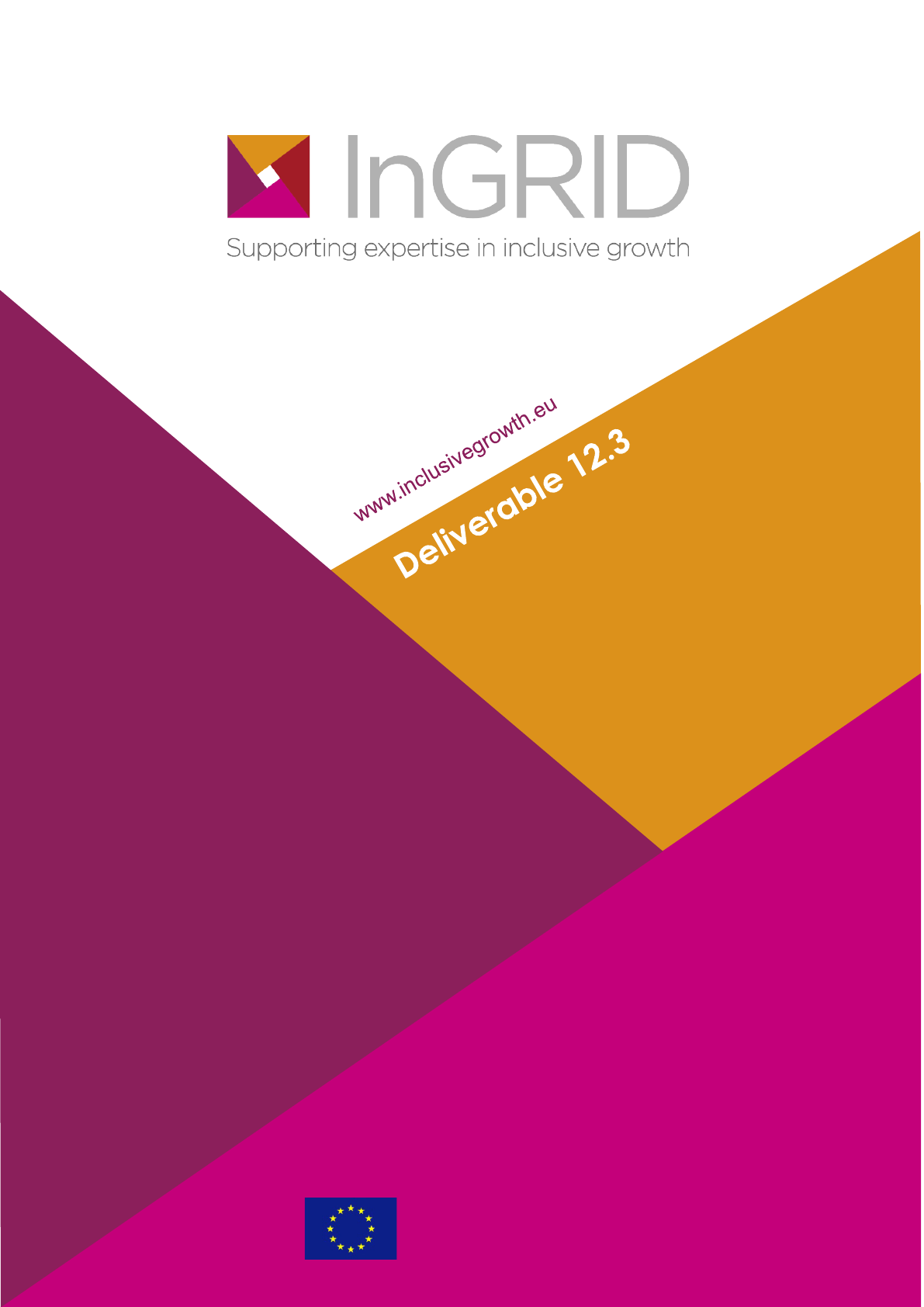
This project has received funding from the European Union’s
Horizon 2020 research and innovation programme under
Grant Agreement No 730998
WHAT DETERMINES PRICE IN
PLATFORM WORK?
An empirical study on the impact of
ratings, experience, and duration
Zachary Kilhoffer
April 2021

Abstract
Platform work is a fast-growing form of non-standard work characterised by an online platform that
intermediates paid services. Among the main concerns discussed in the platform work literature at present
are fair pay, ratings, and algorithmic management. However, very little empirical evidence has
attempted to shed light on these issues.
This report builds on a data set of platform worker profiles (n=1,420) retrieved by webscraping a German
labour platform for cleaning services. This platform allows workers to set their hourly price, allowing analysis
to better understand what determines price for platform workers.
Ratings are found to be a statistically significant, but economically insignificant, predictor of price. The
most likely reason for this is that ratings are very inflated; essentially all platform workers are rated from 4-5.
Experience is found to be statistically significant predictor of price; for every 100 tasks completed, hourly
wages rise 2-4%. Duration on the platform is a significant and stronger predictor of price, as people who
have been on the platform for longer earn more. This may be related to the importance of perceived
trustworthiness for platform workers, whom clients invite into their homes to perform services. Gender and
unemployment are also found to be significant, as men earn 3-4% less hourly than women, and an
additional 1% unemployment reduces hourly earnings about 5%.
The findings suggest that ratings and reputation mechanics are an important topic for platform workers’
earnings. The interface and design choices of platforms have real-world impacts on platform workers, which
should elevate them as consequential issues in policy discussions.

87
Acknowledgements
I would like to thank, in no particular order, the following individuals for their invaluable feedback
and discussions over the course of writing this paper: Hannah Johnston, Janine Berg, Six Silberman,
Sara Baiocco, Mattia Di Salvo, Leonie Westhoff, Andreas Haupt, Daniel Gros, Karolien Lenaerts,
and Stephanie Steinmetz.
I would further like to thank Annarosa Pesole and Uma Rani for their approval to use these data,
which I gathered on the basis of an earlier project in cooperation with the Joint Research Centre. The
data will also appear in their forthcoming European Commission Working Paper ‘How many online
workers? Estimated based on selected online web-based and location-based platforms’.

88
Contents
Acknowledgements 87
1. Introduction 89
2. Theory 91
2.1 Assumptions 93
3. Methodology 94
3.1 Data collection 94
3.2 Pre-processing 95
3.3 Describing the data 95
3.4 Analysis 95
3.4.1 Bivariate analysis 99
3.4.2 OLS 102
4. Results 104
4.1 Models 1-4 104
4.2 Models 5-8 105
4.3 Models 9-13 107
4.4 Summary 108
5. Discussion 109
appendix 1 111
References 116

89
1. Introduction
Data on platform work are essential to understand the phenomenon, but good data are hard to come
by for a number of technical and theoretical reasons.
34
This shortcoming is all too evident in efforts
to define and measure the platform economy (e.g. the number of platform workers), which scholars
have been attempting for years. Conceptual challenges in this task include definitional complexity
and a lack of standardised terminology. On the technical side, data on platform work is not or cannot
be gathered in most of the ways that data on other forms of work can be, such as national labour
surveys and administrative reporting (Riso, 2019; Kilhoffer et al., 2020).
This focus on the whole landscape of platforms is understandable; after all, the entire platform
economy is more impactful than any single platform. Still, data on the platform economy are com-
posed of data on individual platforms. While understanding the forest remains the ultimate goal, we
can certainly gain from examining individual trees. This has a number of advantages, foremost of
which is feasibility. Even though platforms are extremely diverse, better understanding a single plat-
form can give important clues to how platform business models impact the workers.
This study attempts to shed light on certain factors about a particular platform – particularly, the
relationship between a platform worker’s characteristics (rating, gender, experience, etc.) and their
earnings. This is relevant for decent working conditions, algorithmic management, and fairness in
platform design.
Box 1: Selected platform description
The selected platform offers cleaning services, primarily in clients’ homes. While based in and originating in
Germany, it has expanded to other EU countries.
The selection process begins when a client enters a location (zip code), date, and time of day, then sees a
list of candidate platform workers available at that time and place. The client sees each candidate’s name,
gender, average rating, experience (number of cleanings), duration (time since registering on the platform),
and price per hour (which the workers themselves choose).
The client can then select a platform worker, who accepts or rejects the client’s work offer. Upon acceptance,
client and platform worker are put in contact to arrange logistics, and the platform worker meets the client
and cleans for a specified number of hours. The client can rate the worker if they wish, and the worker’s profile
is updated to reflect their new average rating and experience. The service can be one-off or recurring.
Rather than relying on administrative data, surveys, or other more common methodologies, this case
study uses data web-scraped in January and February 2020 from a German cleaning platform. This
platform falls into a category of platform work sometimes called ‘on-location’ or ‘location-dependent’
(Eurofound, 2018; Brancati et al., 2019).
A primary reason for selecting this platform is the pricing model. Unlike many on-location plat-
forms, such as the big players offering personal transportation (Uber, Taxify) or food delivery
(UberEats, Deliveroo, TakeAway), the selected platform allows platform workers to set their own
hourly prices. Furthermore, many ‘handyman’ or multipurpose platforms intermediate an array of
services, which makes it more difficult to compare similar work. By contrast, the selected platform
only offers cleaning services.
In short, the characteristics of the selected platform allow us to gather data on and empirically
explore policy-relevant research questions concerning prices and earnings on platform work. This
34 See discussion in Kilhoffer (2020a).

90
report aims to understand how platform workers set their price, and how signals visible to clients and
platform workers impact this decision.

91
2. Theory
The analysis builds on signalling theory, which focuses on information asymmetries between at
least two different market sides during the initiation of transactions. Platforms are multi-sided mar-
kets, making them an appropriate subject to apply the theory.
Sellers of goods and services know more about what they sell than clients, creating an infor-
mation asymmetry. Traditional business transactions occur face-to-face, at least initially, which
helps clients get a clearer idea of what they are purchasing, while establishing rapport between parties.
This is usually not the case in platform work, and is not possible in many transactions occurring
exclusively online (e.g. hiring a freelancer to design a graphic on 99Designs or UpWork). This creates
an asymmetric information problem that platforms and platform workers must address.
Sellers can help to mitigate the information asymmetry and assure prospective clients by sig-
nalling the quality of their product service with descriptions, guarantees, warranties, or branding
(Spence, 2002). Signals can be conventional (e.g. self-descriptions, promises), handicap (a product guar-
antee or well-crafted CV), or index. Index signals rely on some form of confirmation through an
independent third party that used or experienced the product or service (Teubner et al., 2017), and
are generally considered the strongest type of signal (Aiken & Boush, 2006). The data scraped from
the selected platform include several index signals:
1. average client rating;
2. number of jobs completed (experience);
3. duration on platform.
The first topic of interest is client ratings for platform workers. Ratings, typically shown as a number
of stars between 1 and 5, are a critical component of platform work and online interactions more
generally, and have become a ubiquitous factor in addressing information asymmetry (Belle-
flamme & Peitz, 2018). Van Doorn (2017: p. 903) writes:
… ratings have become a major decentralised and scalable management technique that outsources quality control to
customers of on-demand platforms, creating a generalised audit culture in which service providers are continually
pushed to self-optimise and cater to the customer’s every whim.
Ratings are essential to understanding how Uber created a business model where clients willingly
enter a complete stranger’s car. Caretaking, ‘handyman’ and cleaning platforms must go a step further,
as clients invite strangers into their homes with or without supervision.
35
For the service providers, ratings are extremely consequential. Platform workers’ ratings can
serve as a threshold for satisfactory work; Uber previously ‘deactivated’ drivers who failed to maintain
a 4.6 out of 5 (Cook, 2015). Ratings attract or deter prospective clients, who primarily rely on reviews
of earlier work to choose a platform worker (De Groen & Kilhoffer, 2019). Thus, ratings matter a
great deal for platform workers’ income and future job prospects (Huws et al., 2019; Kilhoffer et al.,
35 Note that ratings are not the only risk mitigating factor for most platforms. For example, the selected platform offers clients insurance
for property damaged during the cleaning.

92
2020). They also play a role in discrimination. For example, a worker’s ethnicity might negatively
impact their ratings (Ye et al., 2017), or improve trust to counteract biases (Cui et al., 2017).
Rating systems also provide an important source of network effects. The more platform workers
on a platform, and the more ratings they have, the better informed clients are in their purchasing
decisions. Rating systems are therefore part of self-reinforcing mechanisms that cause successful plat-
forms to become more successful at the expense of smaller rivals (Belleflamme and Peitz, 2018).
Similarly, within a single platform, a few platform workers with many reviews and high ratings are
likely to edge out others, thereby attracting ever more clients in the future.
In spite of their importance, rating systems are imperfect. For example, Zervas et. al describe
rating inflation, finding that 95% of AirBnB properties have an average rating between 4.5 and
5 stars, while virtually none have 3.5 or lower (2015). Wired Magazine described a situation familiar
to many Uber users – a white-knuckle, harrowing ride through the city, which they rated a five star
experience (Kane, 2015). Online marketplaces contain reviews that may be sincere, malicious, or
fraudulent (Kaghazgaran et al., 2017).
In platform work, five star reviews seem to be the default, while only the most unsatisfied clients
leave one star reviews.
36
In previous interviews, workers of the selected platform suggested that
below a four star rating, clients would never hire them (Eurofound, 2018). It is therefore unsurprising
that platform workers and their advocates continue to call for more transparent and contestable
review systems (Berg et al., 2018).
Because ratings are important for both the platform (versus other platforms) and the platform
workers themselves, I investigate the relationship between average ratings and hourly price. For
the reasons explained above, and empirical evidence on how various signals translate to price
(Edelman & Luca, 2014), higher ratings are expected to increase the hourly price a platform
worker requests.
37
H1: Higher average ratings are positively correlated with hourly price.
An additional index signal is the number of completed tasks. This serves to demonstrate a platform
worker’s experience, signalling trustworthiness and capacity to perform services. Some measure of
experience is likely to be very important for platform workers, whom (on this platform) clients cannot
select on the basis of more detailed job histories provided in a CV or similar.
H2: Higher experience is positively correlated with hourly price.
Next, longer duration on the platform is likely to signal that a platform worker is an established
member of the community, which could impact the price a platform worker can successfully charge.
For example, a platform worker who began yesterday is probably more likely to be fraudulent, as very
little time has passed allowing fraud or malign intentions to be uncovered. Moreover, longer duration
on the platform signals higher social capital, which may increase clients’ satisfaction (Huang et al.,
2017; Teubner et al., 2017).
H3: Longer duration on the platform is positively correlated with hourly price.
Finally, I expect that the number of completed tasks impacts how clients perceive the value of ratings,
and thus explore an interaction effect between the average rating score and the total number of
ratings. Consider two platform workers, each with an average five-star rating, but one having com-
pleted a single task, and one having completed a hundred. The latter would signal a consistent record
of success and experience, whereas the former has too small a sample size to draw any strong con-
36 Two additional points on this note. First, some interviewed platform workers of the selected platform indicated that satisfied clients
sometimes leave a four-star review, either not understanding or not caring that this greatly harms the worker. Some interviewees
further described receiving reviews from elderly clients who misunderstood the star system. The written review was a glowing recom-
mendation, but the client left a single star, apparently not understanding that this is the worst possible review.
37 On the other hand, platform workers, particularly those with more general skills (e.g. cleaning), have limited ability to set rates
(De Groen & Kilhoffer, 2019). This would indicate that the size of the effect is not expected to be very large.

93
clusions.
38
With this theoretical grounding and empirical support (Gutt & Herrmann, 2015), I pro-
pose:
H4: The positive wage return to ratings increases with the number of tasks a platform worker has
completed.
The expected relationships are summarised in Table 1.
Table 1. Summary of expectations for independent variables
Variable Hypothesis Models Impact on Price
Rating 1 1, 9, 13 +
Experience 2 2, 10, 13 +
Duration 3 3, 11, 13 +
Interaction (rating*experience) 4 4, 12 +
* + indicates I expect a positive correlation between the independent and dependent variables.
I rely on four control variables: gender, unemployment, GDP per capita, and location (NUTS-3
region). Most general and platform work literature suggests that men earn more than women, which
is also my expectation (Cook et al., 2018; Aleksynska et al., 2019). I also expect that areas of Germany
with lower unemployment, higher GDP per capita, and higher living costs are associated with higher
price per hour.
39
The main tool of analysis is ordinary least squares (OLS) linear regression.
2.1 Assumptions
A number of assumptions underlie this analysis. While those listed below are not exhaustive, they are
useful to simplify the complex interactions between platform workers and clients in this online
marketplace.
1. The platform operates on a hedonic price model, meaning that marketable features will be
reflected in market prices (Rosen, 1974).
2. Clients and platform workers are aware that rating, experience, and duration signal the quality of
services offered.
3. Platform workers charge the highest price per hour that allows them to continue finding work.
4. Clients seek to maximise the quality of services received and minimise price paid.
38 Or as Germans would say, ‘Einmal ist keinmal’ – approximately ‘Once is never’.
39 Unemployment data are from Eurostat representing NUTS-2 region in 2019. GDP per capita data are from Eurostat representing NUTS-3
region in 2019. Location is a categorical variable for NUTS-3 region, derived from the zip-code (Postleitzahl) used during webscraping.

94
3. Methodology
3.1 Data collection
To gather the data, I used Python to develop a webscraping programme.
Box 3: Webscraping description
Webscraping is a means of gathering data from websites. Webscraping typically makes use of automated
tools developed with programming languages to extract data from webpages. In principle, anything that
can be viewed online can be webscraped using a variety of techniques. Unstructured text, structured data,
images, and anything else contained on a website can be retrieved.
Source: Kilhoffer (2020b: p. 8).
Webscraping has a number of pros and cons,
40
so researchers must be wary of ethical, practical, and
legal restrictions on the practice. For example, webscraped data can be noisy, and not all websites are
possible to scrape due to CAPTCHA, rate limiting, log-in requirements, etc. Nevertheless, web-
scraping can help equalise what researchers, policy-makers, and the platforms themselves know about
their business models.
Typically, webscraping with Python uses the libraries Requests and BeautifulSoup, which is rela-
tively quick and easy. However, the selected platform was unsuited for this method. More specifically,
the platform’s website does not list workers unless one specifies a date, time, and location. At this
point, the website displays a list of workers who have made themselves available at this time and
place. In testing, I was unable to recreate the request headers necessary to retrieve worker data using
the website’s API,
41
so I relied on a slower webscraping method.
With the goal of attaining a comprehensive dataset of workers on the platform, I used the Python
library Selenium. Selenium is a tool for automating web browsers, primarily used for testing web
applications, but it can also be used for webscraping. The main downside is that it is significantly
slower and more computationally intensive than alternative methods.
I used Selenium to automate a web browser, simulating a human requesting available platform
workers at various locations, dates, and times, and writing the data to CSV files. The process required
a few weeks and took place in late January and early February 2020. I observed polite scraping pro-
tocol, placing delays between requests so as to not spam the platform’s servers too frequently. I also
ensured that the data were scraped and handle in accordance with the European Parliament’s GDPR
guidelines on webscraping.
42
The webscraping programme searched all German zip codes at different dates and times. This
aimed to ensure that platform workers would be found even if they are only sporadically available,
such as only on weekends, or at certain times of day. Even so, only platform workers who made
themselves available to work on the searched days and times could be retrieved. If they were regis-
tered on the platform but selected no dates to be available, they would not be found. Similarly, if a
platform worker was taking a long break from the platform, they could not be retrieved.
40 See discussion in Kilhoffer (2020b).
41 Application programming interface.
42 The data gathered cannot be linked to a natural person; they do not contain last names, addresses, birthdays, emails, or anything
else typically classified as protected, personal data. See European Parliament resolution (2016/2225(INI)) (European Parliament, 2017).

95
3.2 Pre-processing
The data needed to represent a single platform worker per row for analysis. Thus, we needed to merge
and de-duplicate all of the CSV files created during webscraping. In some cases, the same platform
worker was available in a number of zip codes, all days of the week, and virtually all times of day.
Other platform workers were only sporadically available.
Exactly de-duplicating could not be performed using all columns of data, as certain aliases turned
out to be common, and the scrape took place over a few weeks. I deliberately retrieved no worker
ID number or other data that could definitively be linked to a person. In practice, this meant that
some platform workers would have multiple rows where they were potentially listed with different
numbers of completed cleanings, ratings, or durations. In exceptional cases, I had to manually check
that workers with the same name and locations were not the same person. I could not be certain of
six cases, where a row may or may not represent a duplicate of another person. These were removed
from the dataset. Next, I added the NUTS-3 region for each platform worker based on zip-code
searched.
3.3 Describing the data
The data consist of 1,420 observations, each representing a unique platform worker. Each worker
has an alias, average rating, experience (count of completed assignments), duration on platform,
hourly price, gender, and zip code.
43
The average rating is a value from 1-5 to a single decimal place, or a blank if no client had yet left
a rating. Experience was given as a whole number greater than five, except for those who had not yet
completed five assignments; these were listed as ‘<5’.
The duration on the platform is listed in one of five categories: new, 1-6 months, 6-12 months,
1-3 years, or greater than 3 years. Hourly price is given in Euros and cents, while gender was given as
m
ale or female
44
based on the avatar displayed.
Table 2 Descriptive overview of continuous variables
Count Mean Std. Min. 25% 50% 75% Max.
Price (€) 1,420 18.3 3.7 10.0 16.2 16.6 19.9 45
Rating (1-5) 1,065 4.7 0.4 1.0 4.6 4.8 4.9 5
Experience (# of jobs) 947 152.3 266.3 5 20 53 154 2,456
We see that hourly price is known for all 1,420 platform workers in the data. Average rating was
known for 1,065, while the website displayed a blank for the remainder. In 947 cases, experience (the
number of completed tasks) was listed as an integer. I discuss the treatment of these missing data
below.
3.4 Analysis
Location data reveal platform workers are concentrated in the most urban areas of Germany (Fig-
ure 1). Berlin alone has almost 30% of all platform workers. The tendency for more activity in urban
areas is unsurprising; other forms of on-location platform work are thought to be similar (Kilhoffer
et al., 2020).
43 From the search query used in the web-scraping programme.
44 Later in 2020, the platform began displaying profile pictures. This was not the case at the time of the scrape; all platform workers had
either a generic female or male avatar.
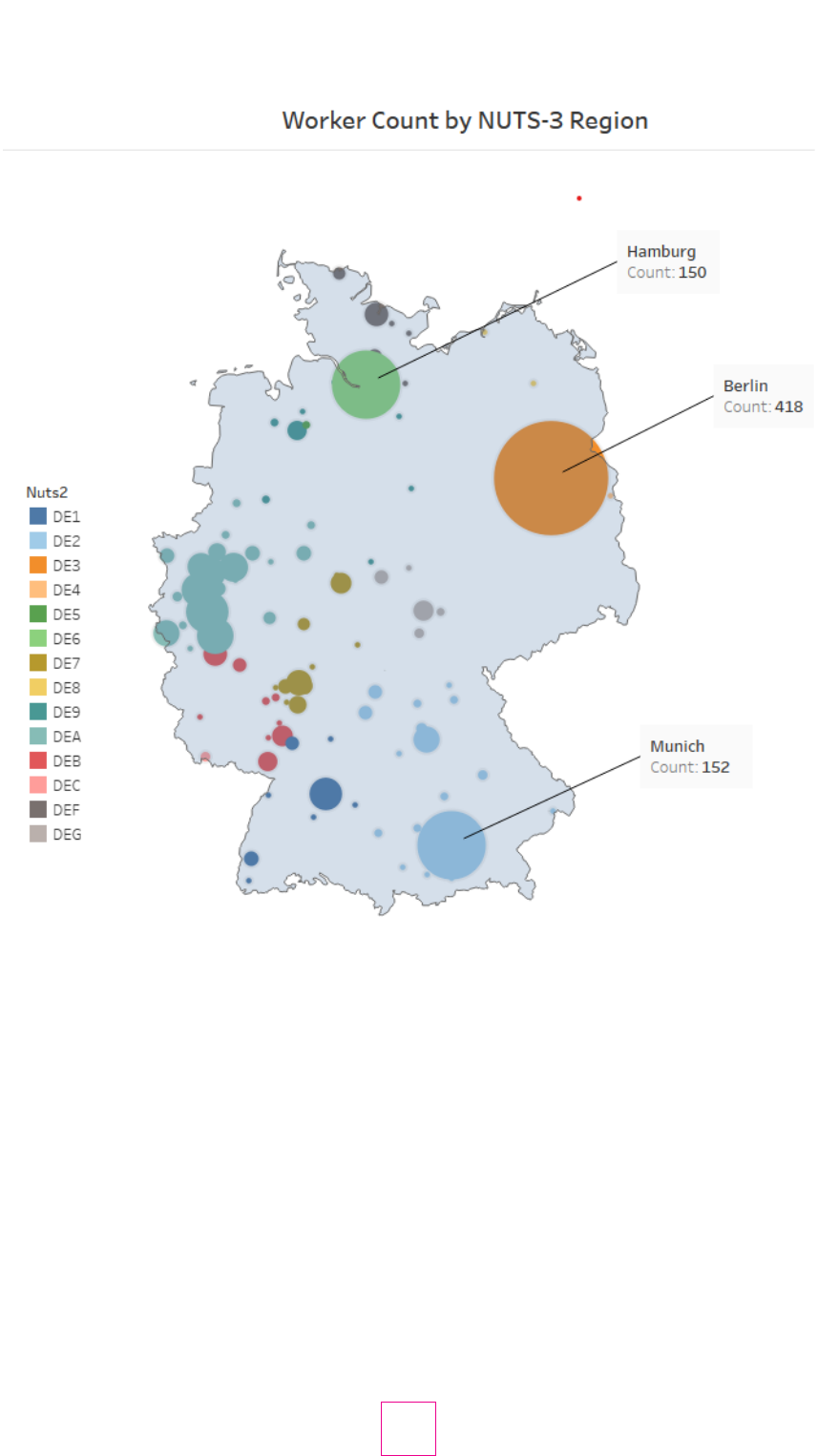
96
Figure 1. Distribution of platform workers in Germany
N
ote: The colour of each circle represents the NUTS2 region. Each NUTS-3 region with at least 2 platform workers
has a circle shown. Larger circles indicate more platform workers.
As shown in Figure 2, the distribution of prices has a long right tail with high skewness. A few outliers
are notable here. While the mean price is 18.30 EUR per hour, and the 99
th
percentile is 33 EUR per
hour, five workers charge over 44.00 EUR. These are not expected to be illustrative of larger trends;
in fact, two of these individuals have virtually no experience and may not be setting realistic prices.
To remove outliers, I calculate the z-score for price, then excluding observations with z-scores greater
than 3.
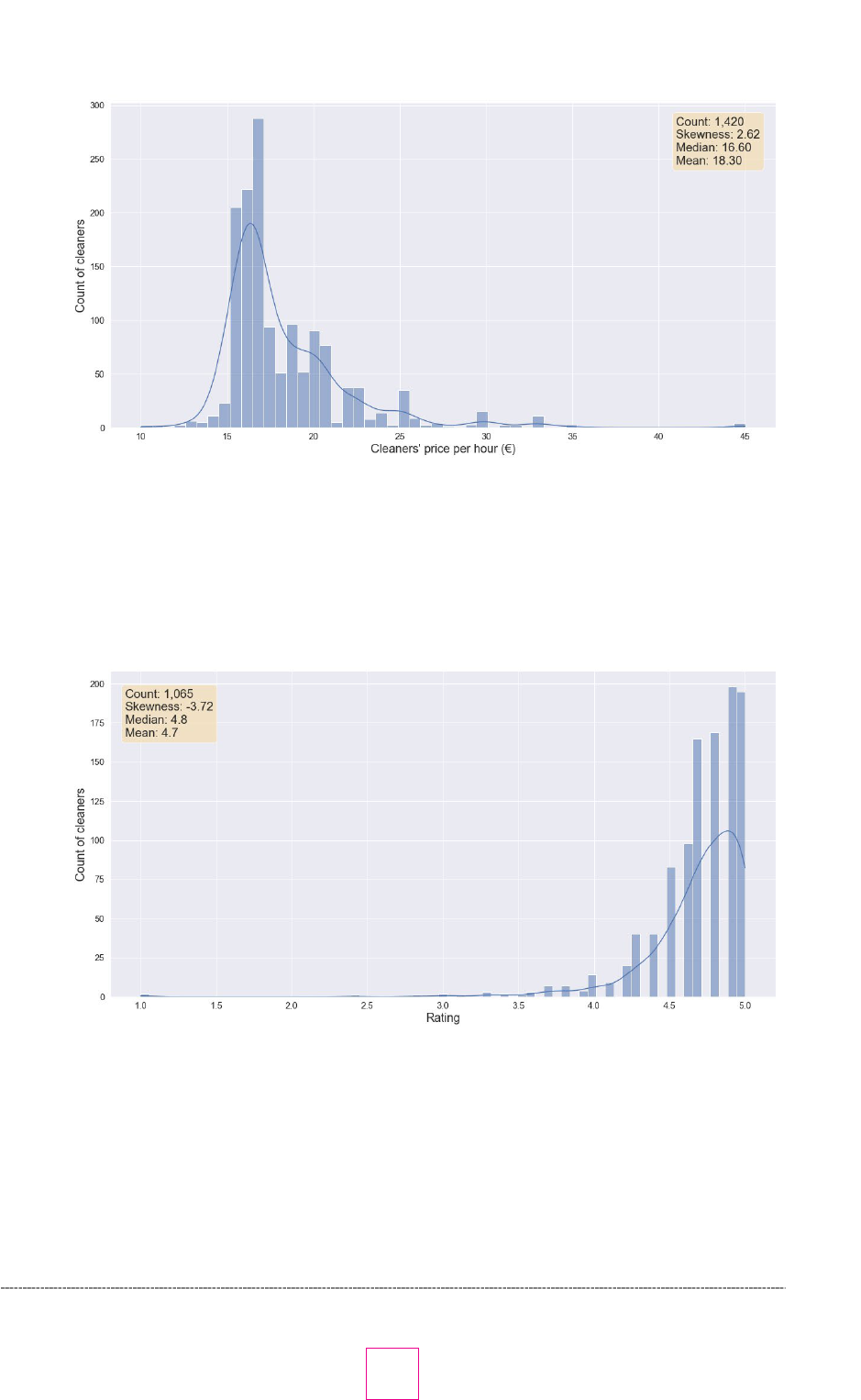
97
Figure 2. Price histogram
The first explanatory variable is rating. Figure 3 shows a long left tail, indicating that lower ratings are
very unusual, as discussed in the Theory section. Only 3.2% of the observations (34/1066) have a
rating below 4, and the first percentile is 3.4. Exactly two people (0.14%) have a one-star rating. I
therefore trim these outliers below the first percentile and leave NAs
45
in place.
Figure 3. Rating histogram
As discussed above, I assume that rating is related to price in two ways: having any rating, and the
magnitude of the rating. In other words, there is a price penalty for having no rating, and there is a
price reward for having a higher rating. In order to test both with the same variable, and to avoid
excluding NAs from the analysis, I create an interaction variable.
First, I use a dummy variable, which is 1 if a cleaner has no rating, and 0 otherwise. Second, I
replace NAs in the rating column with 0.5.
46
Third, I calculate the rating interaction as follows:
45 Not Applicable, or simply missing data.
46 The value chosen to replace NA with does not matter, as it will be multiplied by 0.
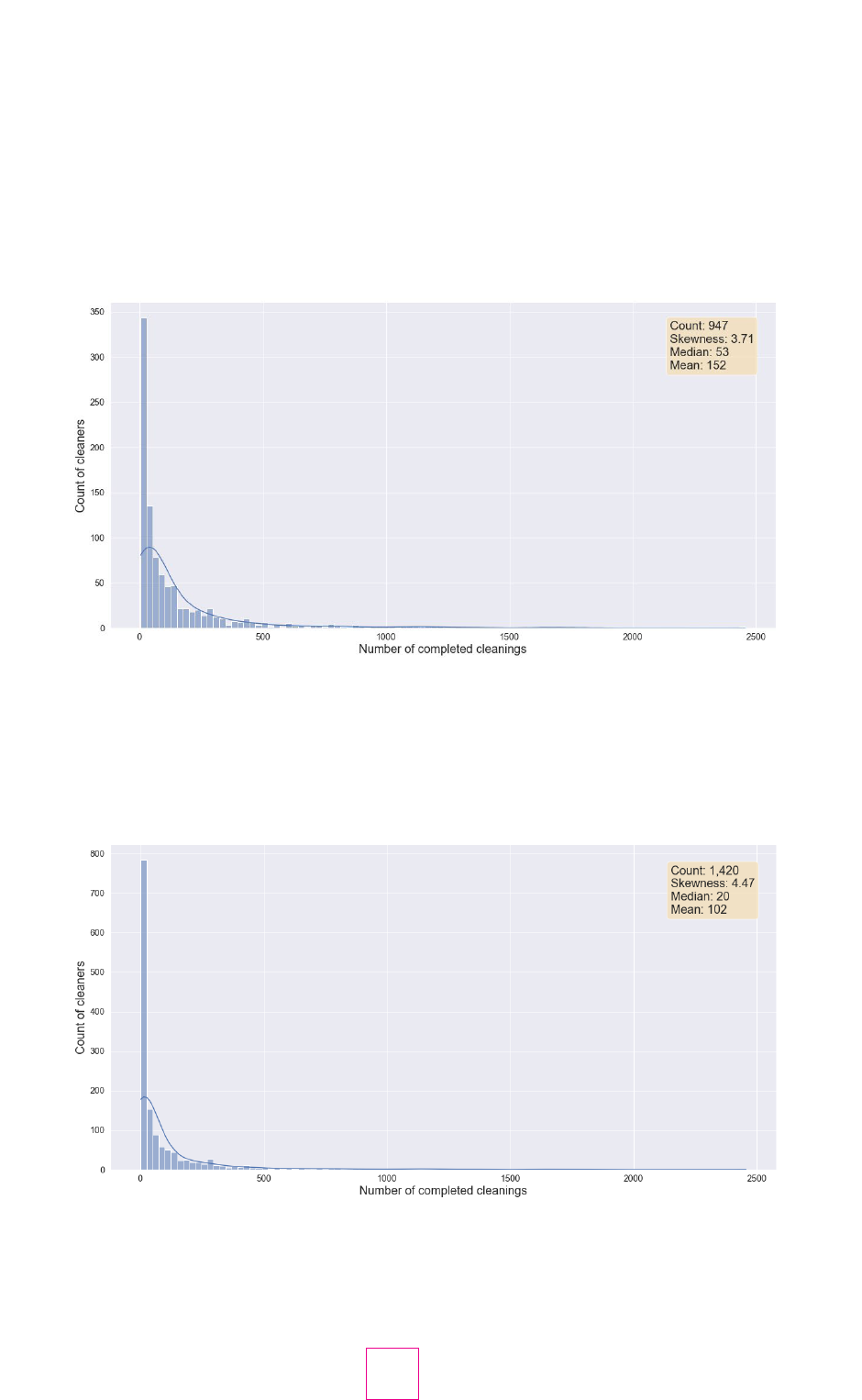
98
Rating interaction = rating dummy + (1 – rating dummy) * (rating + 0.5)
In effect, this assigns a 1-star rating to those without a rating, while giving workers with a rating a
‘bonus’ of 0.5.
Moving to experience, Figure 4 shows the distribution, dropping all observations where the number
of completed cleanings is ‘<5’.
Figure 4. Experience histogram
Before proceeding, I must handle the cleaner experience data shown as ‘<5’. For the moment, I
replace ‘<5’ with 2, being the mean of possible values: 0, 1, 2, 3, and 4. The new distribution is shown
in Figure 5.
Figure 5. Experience histogram (‘<5’ replaced with 2)
Figure 5 again shows an extremely long right tail and high skewness. The most experienced worker
is an individual who has completed 2,456 tasks – far exceeding the second most experienced worker
at 1,823. I thus remove outliers by excluding rows where the z-score for experience is greater than 3.
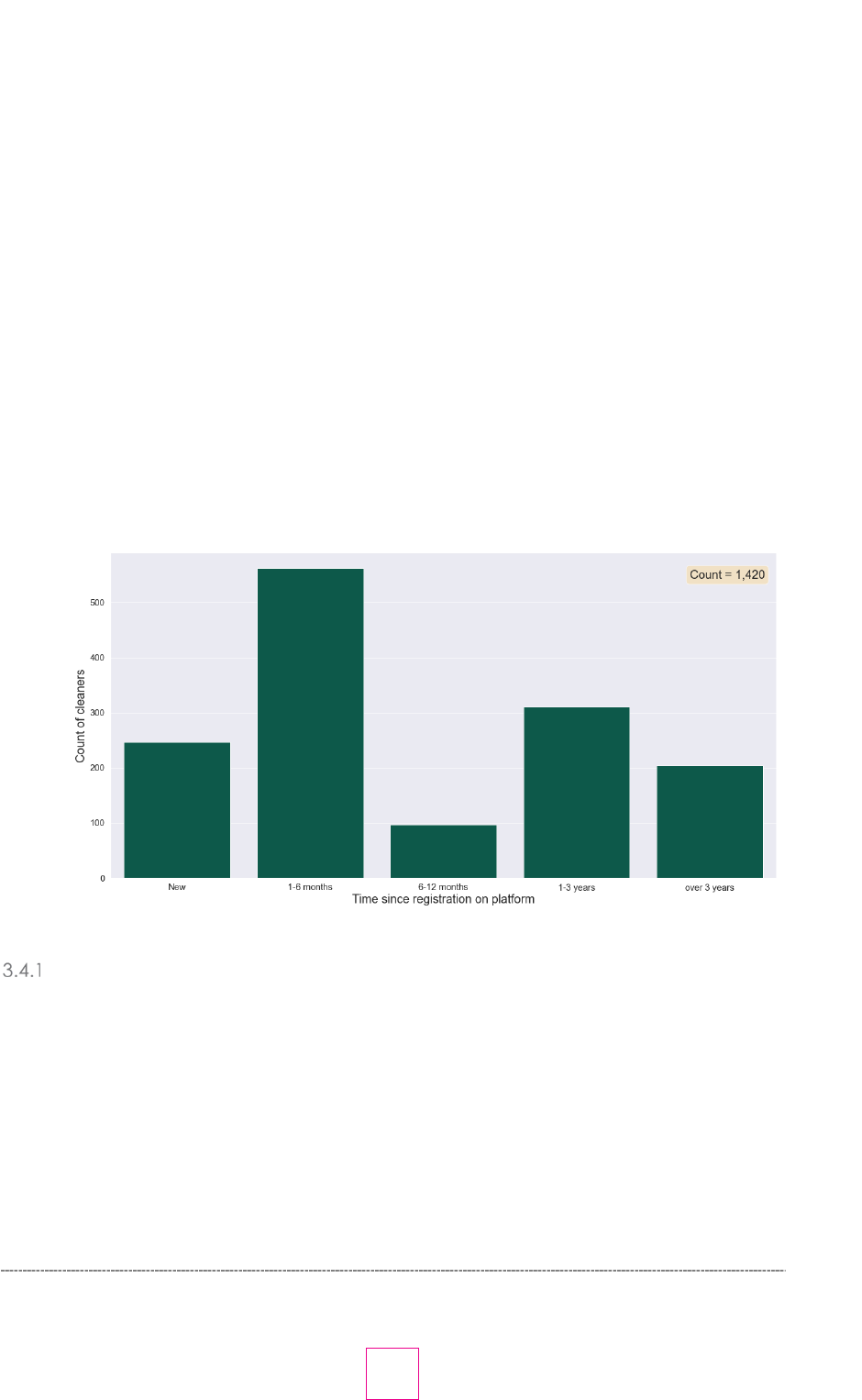
99
Similar to the rating variable, I assume that experience is related to price in two ways: having any
(not ‘<5’) experience, and the magnitude of experience.
I treat the experience variable similarly to rating. First, I create a dummy variable, which is 1 if a
cleaner’s experience is ‘<5’, and 0 otherwise. Second, I replace ‘<5’ in the experience column with 2.
Third, I calculate the experience interaction as follows:
Experience interaction = experience dummy + (1 – experience dummy) * (experience + 5)
In effect, this assigns an experience of 1 to those who have less than five cleanings, while giving those
with five or more cleanings a ‘bonus’ of 5.
While this strategy is not perfect, it does allow us to avoid excluding a large part of the dataset,
while accounting for both the presence of the information (on rating and experience) and the magnitude of
the information.
47
As shown in Figure 6, duration is given in five categories. In order to compare how increasing
levels of duration affect price in the regression, I set the reference level of the duration variable to
‘New’.
Figure 6. Duration box plot
Bivariate analysis
Before running the full models, it is useful to check bivariate correlations between the independent
and dependent variables. The first is rating, as shown in Figure 7, and corresponding to Hypothesis 1.
47 Alternative strategies would result in a smaller dataset or require imputing missing values. On the latter, attempts to impute missing
values proved difficult and resulted in less precise models. Unfortunately, the dataset is not of a sufficient size, and lacks columns that
may help with the imputation.
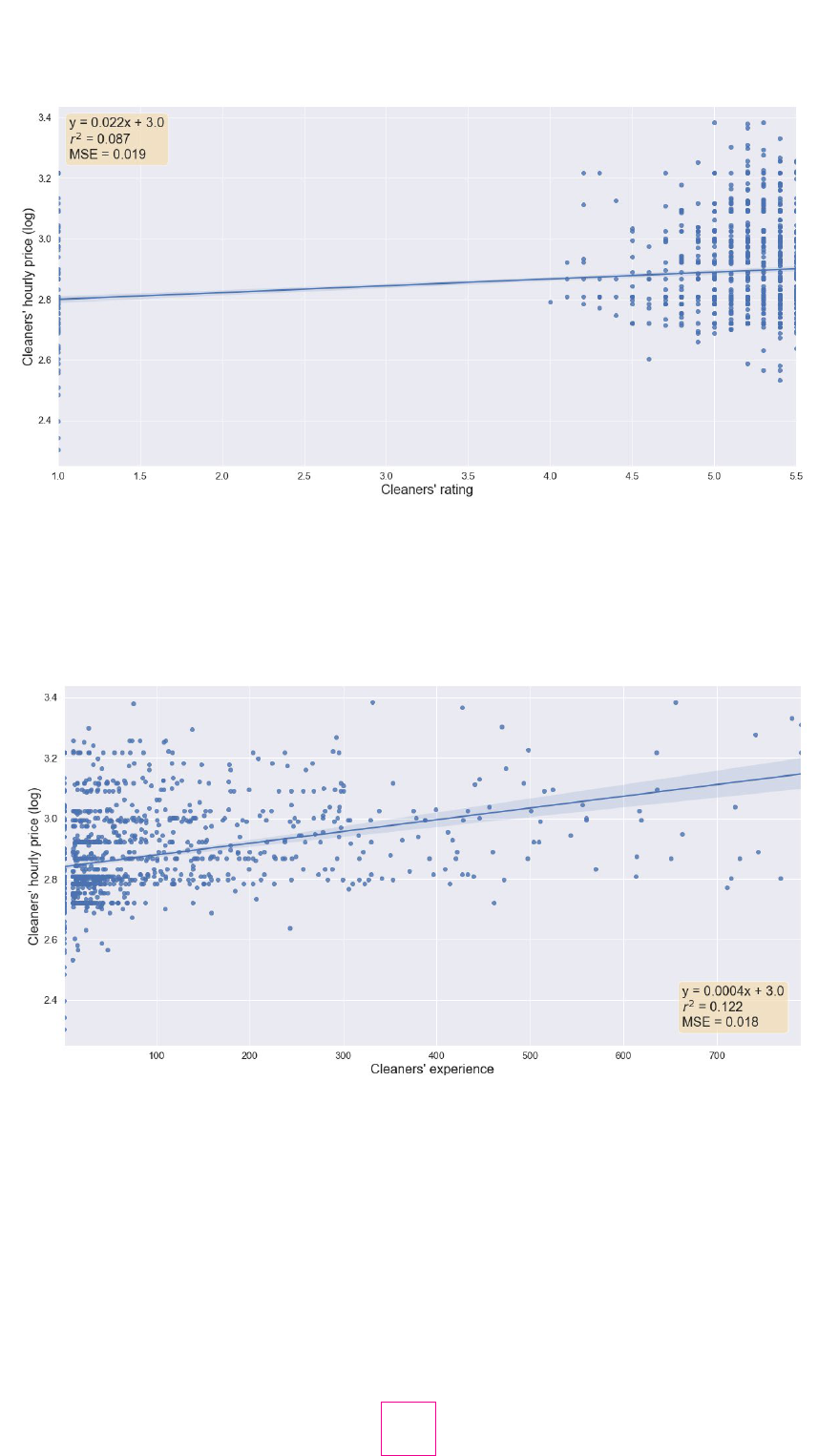
100
Figure 7. Cleaners' rating and price
N
ote: Cleaners’ rating refers to the modified variable described above.
It does appear that people with higher ratings tend to have a higher price. Next, I plot cleaners’
experience and price, as per Hypothesis 2.
Figure 8. Cleaners' experience and price
N
ote: Cleaners’ experience refers to the modified variable described above.
Source
Cleaners with more experience do seem to have a higher price. Next, I plot cleaners’ duration and
price, as per Hypothesis 3.
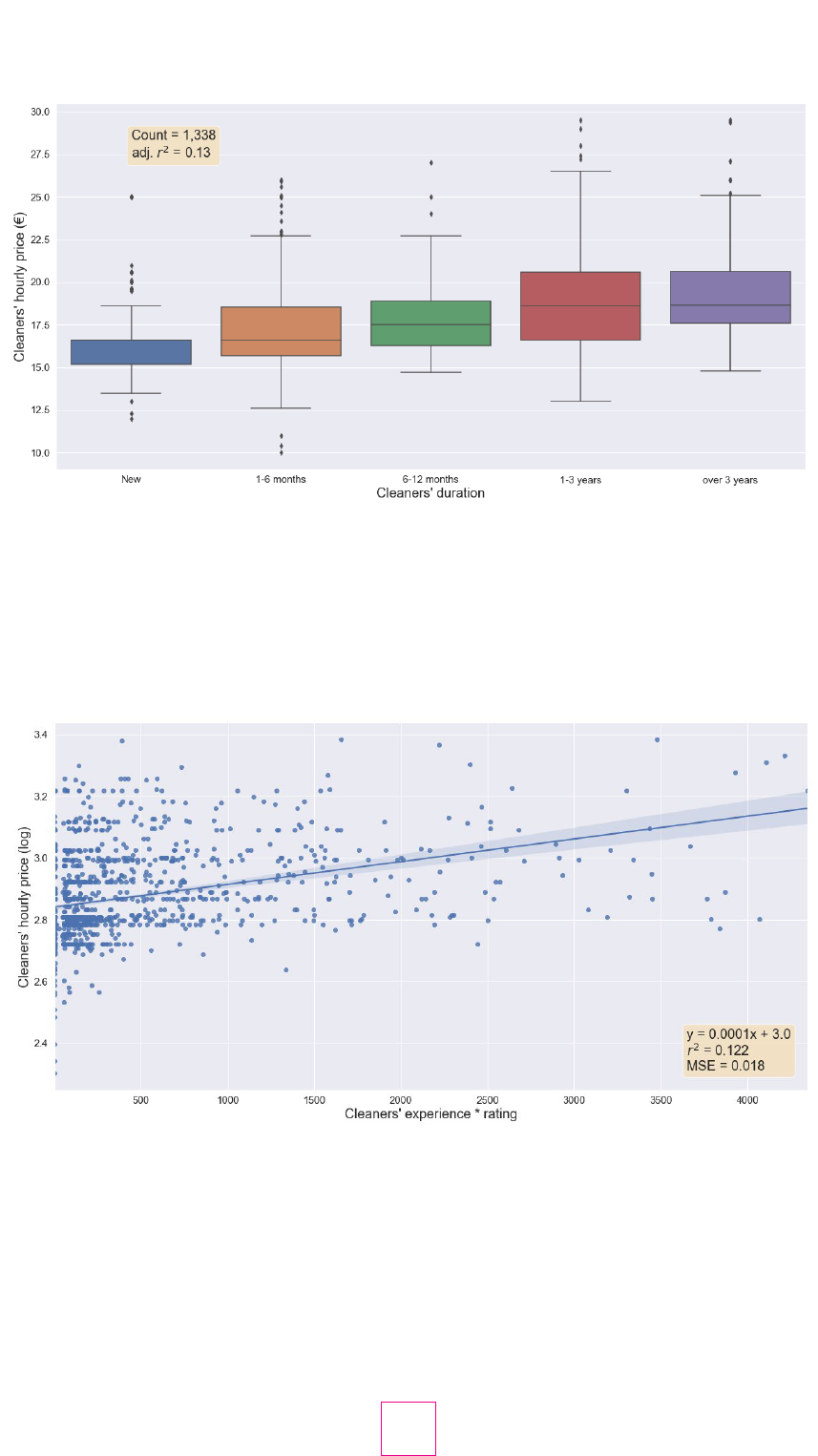
101
Figure 9. Cleaners' duration and price
As expected, higher duration on the platform seems related to higher price. Each successive category
shows this relationship.
Corresponding with Hypothesis 4, I next create an interaction variable, rating times experience, and
plot it against price.
Figure10. Cleaners' rating * experience and price
N
ote: The modified variables for rating and experience, as described above, were multiplied for this interaction variable.
It is not immediately clear if the interaction variable is much different than the experience variable
alone, but this should become clearer in the regressions.
Next, I plot the independent and control variables against one another to understand their relation-
ship. I suspect that experience and duration are quite closely related, as well as experience and the
interaction variable of experience times rating. For the control variables, unemployment and GDP
per capita may be very correlated as well. While I do not show all the variables for location (NUTS-3
region), these would also be very correlated with unemployment and GDP per capita.
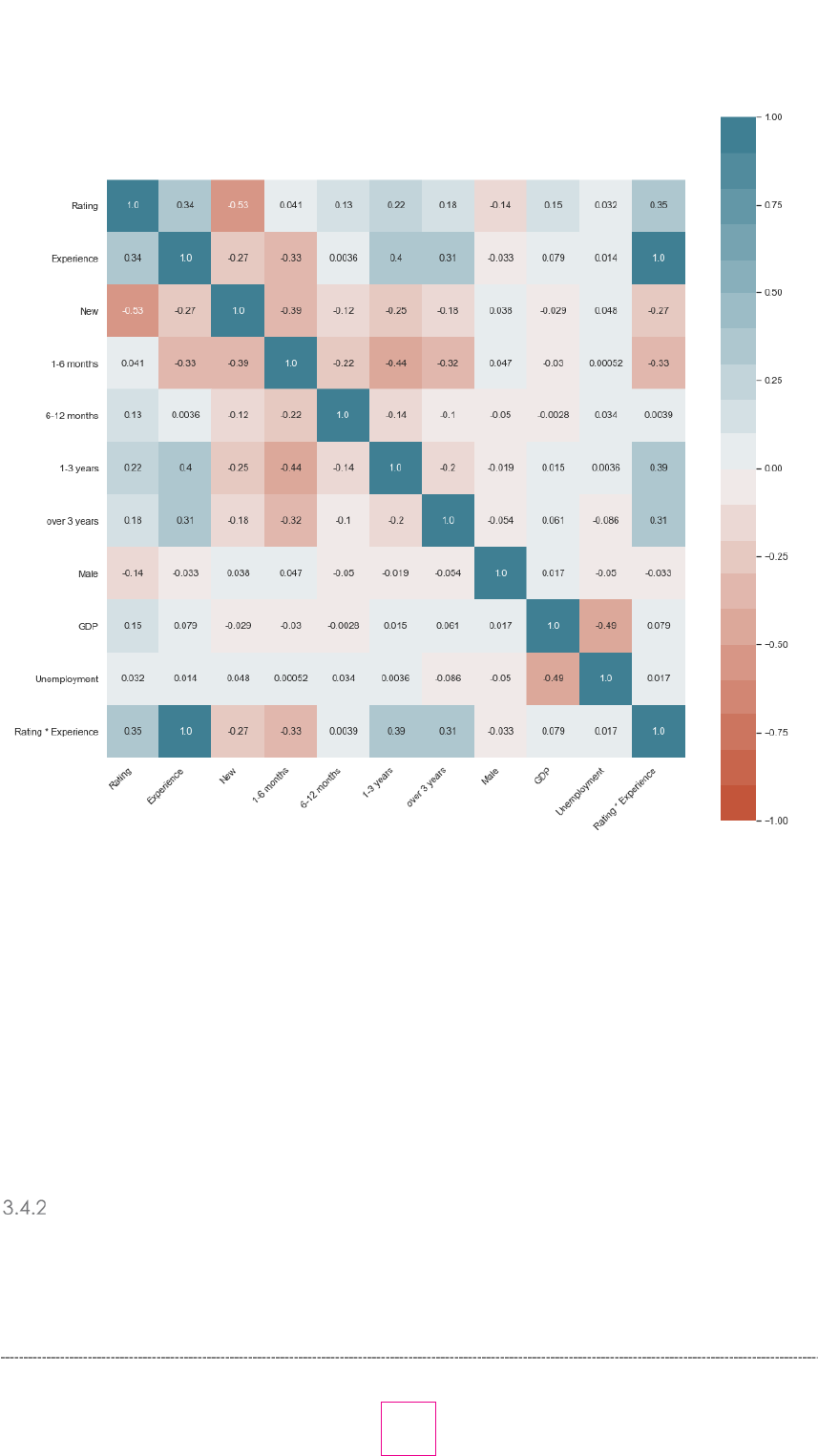
102
Figure 11. Correlation matrix
N
ote: For the duration variable, each category was made into a Boolean.
A few of the variables are quite correlated. First, the ‘New’ cleaners have lower rating and experience.
Correspondingly, the higher values of duration are correlated with higher experience, and to some
extent, rating. Second, the control variables GDP per capita and unemployment are related, with
higher GDP related to lower unemployment. Third, the interaction variable Rating * Experience is
almost perfectly correlated with Experience. Upon further inspection, this seemed to be the case
because there is very little variation in Rating (generally around 4.7), whereas Experience has a large
range.
These results suggest that to avoid multicollinearity problems, models should not use location-
based variables (Unemployment, GDP per capita, location) simultaneously, or use Experience and
the interaction variable Rating * Experience simultaneously.
OLS
I next run linear regressions with ordinary least squares.
48
I use the data trimmed as described above,
which reduces the number of observations from 1,420 to 1,338.
48 An additional option is quantile regression, which is sometimes used for pricing models.

103
The regressions proceed step-wise as outlined in Box 3, starting with independent variables alone,
control variables alone, then each independent variable with control variables, before the final model,
which is an attempt at best fit using selected independent and control variables.
Box 5: Regression model summaries
Independent variables alone
M1: log(Price) ~ Rating
M2: log(Price) ~ Experience
M3: log(Price) ~ Duration
M4: log(Price) ~ (Rating * experience interaction)
Control variables alone
M5: log(Price) ~ Gender (male)
M6: log(Price) ~ Unemployment
M7: log(Price) ~ GDP per capita
M8: log(Price) ~ NUTS-3
Independent and control variables
M9: log(Price) ~ Rating + Gender + Unemployment
M10: log(Price) ~ Experience + Gender + Unemployment
M11: log(Price) ~ Duration + Gender + Unemployment
M12: log(Price) ~ (Rating * experience interaction) + Gender + Unemployment
M13: log(Price) ~ Rating + Experience + Duration + Gender + Unemployment

104
4. Results
4.1 Models 1-4
Table 3. OLS regression results part 1
Dependent variable: Cleaner price (log)
Model 1 Model 2 Model 3 Model 4
Rating 0.02251***
(0.00200)
Experience 0.00039***
(0.00003)
Rating*experience interaction 0.00007***
(0.00001)
Duration (1-6 months) 0.03746***
(0.01018)
Duration (6-12 months) 0.07874***
(0.01648)
Duration (1-3 years) 0.13129***
(0.01149)
Duration (over 3 years) 0.14966***
(0.01315)
Intercept 2.777*** 2.841*** 2.802*** 2.841***
(0.009) (0.004) (0.008) (0.004)
Observations 1,338 1,338 1,338 1,338
R
2
0.087 0.122 0.145 0.122
Adjusted R
2
0.086 0.121 0.143 0.121
Residual Std. Error 0.136 0.133 0.132 0.134
F Statistic 126.911*** 185.871*** 56.743*** 184.945***
Note: *p<0.1; **p<0.05; ***p<0.01.
Five significant digits shown for coefficients, three significant digits shown elsewhere.
Models 1-4 mostly turned out as expected.
Model 1 shows that rating is positively and significantly correlated with price, though it is a rather
weak predictor. Rating alone explains less than 9% of the variation in price, and moreover, an addi-
tional star rating (i.e. from 4 to 5) only results in a 2.25% rise in price. This is hardly impressive
considering that almost all ratings fall between 4 and 5.
In Model 2, experience is positively and significantly correlated with price. However, quite a bit of
experience is necessary to see meaningful results; every 100 additional cleanings results in about a 4%
rise in hourly price. Experience also explains about 12% of the variation in price, making it a stronger
predictor than rating.
In Model 3, all categories of duration are in relation to ‘New’. As expected, each of them are sig-
nificant, positive, and successively stronger. Compared to a new platform worker, one with 1 month
of experience would earn 3.7% more hourly; after six months, 7.8% more; after one year, 13% more;

105
and those with over 3 years of experience earn about 15% more. Note that the difference between
those with 1-3 years and over 3 years of experience is not nearly as large of a jump as with previous
categories. The duration variables explain about 15% of the variance in price.
In Model 4,
49
the interaction term is positive and statistically significant, but like experience, very
weak. An additional one star in rating, and an additional 100 cleanings, would result in a 4.5% higher
hourly price. If rating were held constant, an additional 100 cleanings would result in a 3.1% higher
price. While this does not intuitively seem like much, recall the way that the rating and experience
variables were transformed. A person with no rating and no experience has had both values set to 1.
As such, the model predicts that a person who performed just ten cleanings, and went from no rating
to the median of 4.7, would have an hourly price 3.6% higher than someone just starting out. The
interaction term therefore helps show that there is a price penalty associated with starting new as a
platform worker. On the other hand, the adjusted R
2
for Model 4 is not better than that for Model 2
(experience alone). In short, the interaction term seems to have the predicted effect, but the impact
is almost identical to experience alone. This may be due to the lack of variation in ratings.
4.2 Models 5-8
Table 4. OLS regression results part 2
Dependent variable: Cleaner price (log)
Model 5 Model 6 Model 7 Model 8
Male -0.035***
(0.008)
Unemployment
-0.047***
(0.002)
GDP per capita (EUR 1000s) 0.003***
(0.000)
DE712 -0.188***
(0.032)
Intercept 2.891*** 3.068*** 2.710*** 3.026***
(0.006) (0.011) (0.010) (0.020)
Observations 1,338 1,338 1,338 1,338
R
2
0.014 0.219 0.186 0.436
Adjusted R
2
0.014 0.219 0.185 0.388
Residual Std. Error 0.141 0.126 0.129 0.111
F Statistic 19.513*** 375.464*** 304.534*** 9.153***
Note: *p<0.1; **p<0.05; ***p<0.01
All figures shown to three significant digits.
DE712 is the first of the NUTS-3 regions, others shown in Appendix. See discussion below.
Models 5-8 show just the control variables.
Model 5 shows that gender is a significant indicator, but its predictive power is quite weak, explain-
ing 1.4% of the variance in price. Unexpectedly, men earn around 3.5% less per hour than women.
49 Note that due to the high level of collinearity between Experience and the interaction term Rating * Experience, the effects on the
dependent variable cannot be disentangled if run together in a regression. When running rating, experience, and the interaction
variable together, the interaction variable loses its significance and the coefficient becomes slightly negative. Rating stays very sig-
nificant but its coefficient weakens, while experience becomes slightly less significant, but its coefficient becomes much stronger.
Interpreting these results is tricky, as the coefficient of individual variables would hold when the other variables have a value of 0,
which cannot be the case in the data.

106
It may be that clients prefer to hire women to enter and clean their home, and therefore men offer
slightly lower rates.
In Model 6, unemployment turns out to be quite a strong predictor. For areas with 1% higher
unemployment, cleaners earn 4.7% less per hour. Unemployment explains about 22% of the variance
in price, making it the best predictor so far.
Model 7 shows that GDP per capita also significantly and positively impacts price, explaining 18.5%
of its variance. Cleaners in an area with 10,000 higher GDP per capita earn 3% more hourly. Given
that GDP per capita in the data ranges from 20,000 to 180,000, this can make quite a large difference.
Model 8 shows the geographical location variable, NUTS-3 region. Because over 100 NUTS-3
regions are in the data, only one (DE712) is shown above, while the rest are in the Appendix. As
shown in the Appendix, most locations prove to be significant determinants of hourly price. This is
sensible for at least two reasons. First, wages and cost of living vary throughout Germany. For
example, we would expect (and indeed observe)
50
that cleaners in Stuttgart charge more than average.
Second, the amount of clients and platform workers in a given location impacts the supply and
demand. If relatively few workers are available, and relatively many clients searching for services, then
workers may have more margin with which to set their prices. The NUTS-3 regions explain a great
deal of the variation in price - around 39% - making it the strongest predictor in the data.
All control variables prove to be significant. However, it is not possible to use unemployment and
GDP per capita simultaneously (see discussion by Figure 11), and NUTS-3 regions (Model 8) add
over one hundred variables to the model. To achieve the best and most parsimonious model, the
next regressions will use only gender and unemployment as control variables.
50 Alphabetically, the first German NUTS-3 region (DE111) is central Stuttgart, which is the reference for other locations and not shown in
the regression tables. Stuttgart recently surpassed Munich as the most expensive city in Germany. Almost all other regions show a
negative and significant coefficient, meaning prices are significantly lower per hour than in Stuttgart.

107
4.3 Models 9-13
Table 5. OLS regression results part 3
Dependent variable: Cleaner price (log)
Model 9 Model 10 Model 11 Model 12 Model 13
Rating 0.0226*** 0.0132***
(0.0017) (0.0020)
Experience 0.0004*** 0.0002***
(0.0000) (0.0000)
Duration (1-6 months) 0.0305*** -0.0035
(0.0088)
(0.0095)
Duration (6-12 months) 0.0759*** 0.0200
(0.0143) (0.0149)
Duration (1-3 years) 0.1231*** 0.0468***
(0.0100) (0.0118)
Duration (over 3 years) 0.1248*** 0.0455***
(0.0115) (0.0131)
Rating*experience interaction 0.0001***
(0.0000)
Male -0.0300*** -0.0386*** -0.0346*** -0.0386*** -0.0298***
(0.0066) (0.0064) (0.0064) (0.0064) (0.0062)
Unemployment -0.0489*** -0.0486*** -0.0461*** -0.0487*** -0.0480***
(0.0023) (0.0022) (0.0022) (0.0022) (0.0021)
Intercept 2.999*** 3.067*** 3.023*** 3.068*** 3.002***
(0.013) (0.011) (0.013) (0.011) (0.013)
Observations 1,338 1,338 1,338 1,338
R
2
0.014
0.219
0.186
0.436
Adjusted R
2
0.014 0.219 0.185 0.388
Residual Std. Error 0.141 0.126 0.129 0.111
F Statistic 19.513*** 375.464*** 304.534*** 9.153***
Note: *p<0.1; **p<0.05; ***p<0.01.
Four significant digits shown for coefficients, three significant digits shown for summary statistics.
Models 9-13 show the independent variables with control variables.
Model 9 is essentially identical to Model 1, showing that rating is a statistically significant, but rather
economically insignificant, predictor of price. The control variables are more or less the same as when
testing them independently.
Model 10 is a similar story, as experience and the control variables maintain the same relationship
as previous regressions showed.
Model 11 is mostly the same as Model 3, except the coefficients are a bit weaker for 1-3 years and
over 3 years. One interesting change is in the adjusted R
2
. In Models 2 and 3, which had no control
variables, duration was quite a bit better at explaining variance in price. After adding gender and
unemployment, the models with experience and duration both explain around 36% of the variance
in price.
Model 12, like Model 4, shows that the interaction term rating * experience is positively and signifi-
cantly correlated with price. However, the coefficient became about 43% stronger (from 0.00007 to
0.0001). In this model, a person with a constant rating of 4.7, would see their hourly price rise 5.2%
after an additional 100 cleanings. A person with experience of 105 and rating 4.9 would earn 5.4%

108
more than a person with rating of 4.4 and experience of 5. Again, rating is not very economically
meaningful, unless you have no rating at all.
Finally, Model 13 shows the preferred regression with the most information, explaining 41% of the
variance in price. Interestingly, the independent variables become a bit weaker when run together.
An additional star rating now increases hourly price only 1.3%, and an additional 100 experience
increases price by 2%. The story of experience could be more complicated than simply ‘more expe-
rience, higher wages’. For example, platform workers in need of money may set lower prices to find
work more quickly.
The first two categories of duration, 1-6 months and 6-12 months, lose their significance, and the
longer durations, 1-3 years and over 3 years, only earn about 5% more than a baseline worker. This
may indicate that price is best predicted by a mixture of multiple factors, which refines the story from
Models 1-4, which made it seem like duration was a far better predictor than experience. Unemploy-
ment is virtually unchanged from previous models, while the coefficient of male stays about the same.
4.4 Summary
Models 1, 9, and 13 suggest that continuous rating is a statistically significant and positive determinant
of price, though rating did not turn out to be a very economically significant indicator. Model 9 sug-
gests that for each additional star rating, price increases 2.2%, where Model 13 shows an increase of
1.3%. This is hardly impressive, given the maximum star rating of 5, and that almost all cleaners fall
around 4.7 to 4.8 stars. I nevertheless accept the first hypothesis:
Higher average ratings are
positively correlated with hourly price
.
Looking to cleaner experience, Models 2, 10, and 13 reveal a significant and positive correlation
with price.
51
Model 8 shows that each additional 100 cleanings leads cleaners to request an additional
4% in hourly price. While Model 13 shows a weaker relationship – an additional 100 cleanings leads
to an additional 2% in hourly price – the relationship stays otherwise the same. I therefore accept
the second hypothesis:
Higher experience is positively correlated with hourly price
.
In Models 3 and 11 for duration, the reference is those who have been on the platform for under
one month. These models show that each successive category becomes more positive, while all are
significant. Moreover, the effect of duration appears to be stronger than rating or experience. After
one month on the platform, cleaners earn 3.5% more. Six months after starting, cleaners earn 7.5%
more than their starting wage, and so on. While the predictive power of duration decreases in Model
13, it still shows the same general relationship with price. I therefore accept the third hypothesis:
Longer duration on the platform is positively correlated with hourly price
.
Finally, we look to the interaction effect. Models 4 and 12 indeed show a significant and positive
effect of rating * experience on price. This is grounds to accept the fourth hypothesis:
The weight
return to ratings increases with the number of tasks a platform worker has completed
. How-
ever, I would note that it is unclear if the interaction effect of rating * experience performs better
than experience alone.
51 In Model 5, where the interaction effect is added, the coefficient of experience is the unique effect of experience on price when
rating = 0, which cannot exist. Thus, Model 5 does not provide evidence against Hypothesis 2.

109
5. Discussion
In this case study, I have presented a strategy to webscrape and analyse data from a labour platform.
The analysis shows that the data mostly support the hypotheses; rating, experience, and duration are
meaningful signals in platform marketplaces that demonstrably impact workers’ earnings. The results
illustrate the importance of ratings and evaluations in platform work, lending credence to the notion
that fair platform work requires close attention to rating and reputation systems. This evidence
is especially notable due to the limited flexibility cleaners have to set their prices. I expect rating is a
stronger predictor for other types of platform work such as programming or consulting.
The results suggest that rating is a statistically significant, but economically insignificant, determi-
nant of price. This may indicate that rating is more of a pass-fail mechanic, whereby clients will not
hire a cleaner below a certain rating, but otherwise do not care very much. Alternatively, workers with
low ratings may voluntarily drop out of the platform, or be removed, as in the case of Uber drivers.
A related idea that future researchers could explore is a longitudinal one; how likely are platform
workers with low ratings to find future work, or drop off the platform? I suspect that the answer is
quite a bit less likely to find work, and quite a bit more likely to drop off voluntarily or otherwise.
Moreover, such effects may be more pronounced than that on price discussed in the present report.
If so, it would further cement the notion that platform workers need transparency in rating and
evaluation metrics, as well as the ability to contest unfair reviews.
I also note the importance of the region for price, as NUTS-3 region turns out to predict more of
the variation in price than any other variables. Clearly areas with a higher cost of living would be
expected to have higher labour costs. However, when reviewing the data and focusing on any specific
NUTS-3 region, prices among platform workers are extremely similar. It may therefore be a sort of
price collusion, where cleaners simply match their peers’ prices and hope to be selected based on
their availability or other factors.
It is also interesting that duration is such a strong indicator of price compared to ratings, at least
when considered alone. In this particular type of platform work, one possibility is that maximising
the quality of cleaning service is not the main priority of clients. Instead, they may simply want some-
one who can do a ‘good enough’ job of cleaning, while being trustworthy. Having a longer track
record, rather than a stellar rating, may be more important in this respect. Alternatively, it could
simply be that ratings are too inflated to be a good signal of quality.
On the other hand, it is rather strange to think that a cleaner who opened an account a year ago,
then was inactive for a year, then began working suddenly, should merit a higher price. This is also
interesting with regards to interface design. The platform determines which signals to show clients,
and in the case of duration, even sets the value. Based on the results of this study, duration certainly
seems to be a stronger indicator than clients’ ratings, which are the only direct measure of service
quality available.
While this case study does not focus on gender, it revealed an unexpected finding on this particular
platform – on average, women earn 3% to 4% more than men. This result is very significant and
consistent across all models. I propose two possibilities for the difference: first, clients generally see
domestic work as women’s work; and second, clients are less comfortable with inviting an unknown
man into their home.
52
This may indicate that gender biases present in the general labour market
52 See, for example, van Walsum’s research in the Netherlands: All of my informants agreed that Dutch employers generally saw
domestic work as women’s work and tended to prefer women (2011: p. 153).

110
persist in platform work, while not necessarily meaning that women’s earnings always suffer as a
result.
In conclusion, web-scraped data is a valuable tool to examine how labour platforms function, and
investigate earnings for platform workers. It is also an interesting strategy to better understand the
impacts of interface design. Researchers could further build on this line of inquiry by gathering lon-
gitudinal data on different platforms in different locations, and implementing more sophisticated
tools than OLS. For example, Lasso (least absolute shrinkage and selection operator) may be more
useful to sort out which variables best predict price, while improving prediction accuracy and
enhancing interpretability (Brownlee, 2020). It would also be interesting to use machine learning
techniques to analyse whether aliases/names or profile pictures impact prices. In this platform, for
example, platform workers who look German or have a German-sounding name may earn more or
less than their peers.

111
appendix 1
Table a1. OLS regression results part 2 (all regional variables)
Dependent variable: Cleaner price (log)
Model 5
Model 6
Model 7
Model 8
Male
-0.035***
(0.008)
Unemployment -0.047***
(0.002)
GDP per capita (EUR 1000s)
0.003***
(0.000)
DE712 -0.188***
(0.032)
DE254
-0.004
(0.034)
DEA13
-0.157***
(0.030)
DE212 0.032
(0.022)
DE300
-0.240***
(0.021)
DE933
-0.104*
(0.054)
DEA17 -0.138***
(0.032)
DE128
-0.133***
(0.050)
DE600 -0.130***
(0.023)
DEA23 -0.126***
(0.025)
DEB11
-0.087*
(0.050)
DEA22 -0.105***
(0.027)
DEA11
-0.057**
(0.028)
DEF0F
-0.179***
(0.036)
DEG01
-0.275***
(0.037)
DEF09 -0.118***
(0.039)
DEA52
-0.147***
(0.030)
DE731
-0.270***
(0.037)
DEF02 -0.246***
(0.033)
DEB12
-0.191***
(0.033)

112
Dependent variable: Cleaner price (log)
Model 5
Model 6
Model 7
Model 8
DEC01
-0.226***
(0.067)
DEA55
-0.164
(0.113)
DEA1B -0.217***
(0.047)
DEA1C
0.043
(0.081)
DEF0D
-0.112**
(0.047)
DE711 -0.162***
(0.041)
DE941
-0.215***
(0.039)
DE713 -0.127***
(0.044)
DE408 -0.192***
(0.034)
DEA27
-0.124
(0.081)
DEB3J -0.001
(0.081)
DE71A
-0.122***
(0.047)
DEA2D
-0.187***
(0.032)
DE71C -0.045
(0.081)
DE272
-0.461***
(0.113)
DEB34
-0.104***
(0.036)
DEA15 -0.076
(0.081)
DEA1A
-0.160***
(0.044)
DE142 -0.098
(0.113)
DEB33
-0.059
(0.038)
DEA28
-0.026
(0.113)
DE115 -0.060
(0.081)
DE251
-0.217*
(0.113)
DE939 -0.160**
(0.081)
DEF0A
-0.241**
(0.113)

113
Dependent variable: Cleaner price (log)
Model 5
Model 6
Model 7
Model 8
DEA5A
-0.241***
(0.054)
DE24B
-0.241**
(0.113)
DEA2B -0.309***
(0.081)
DE724
-0.217***
(0.054)
DE252
-0.100*
(0.059)
DEA45 -0.162**
(0.081)
DE263
-0.270***
(0.050)
DEA36 -0.133***
(0.041)
DEA51 -0.139***
(0.050)
DEA32
-0.217*
(0.113)
DE271 -0.241**
(0.113)
DE232 -0.241***
(0.067)
DE131 -0.136***
(0.047)
DEB39
-0.241**
(0.113)
DEG07 -0.241**
(0.113)
DE40A
-0.263***
(0.067)
DE124
0.087
(0.113)
DEA54 -0.175***
(0.047)
DEA37
-0.058
(0.081)
DEA47 -0.218***
(0.050)
DE936 -0.305***
(0.113)
DEG06
-0.252***
(0.050)
DE242 -0.241***
(0.081)
DE26B
-0.243***
(0.050)
DEA26
-0.241***
(0.081)

114
Dependent variable: Cleaner price (log)
Model 5
Model 6
Model 7
Model 8
DEG0F
-0.235***
(0.067)
DEG05
-0.241***
(0.081)
DE803
-0.241**
(0.113)
DEF01
-0.259***
(0.054)
DEF08
-0.241**
(0.113)
DE241
-0.241***
(0.081)
DE139
-0.241**
(0.113)
DE717
-0.241**
(0.113)
DE501
-0.305***
(0.113)
DE944
-0.273***
(0.081)
DEB31
-0.305***
(0.113)
DE114
-0.087
(0.113)
DE211
-0.241**
(0.113)
DE734
-0.285**
(0.113)
DE80J
-0.241**
(0.113)
DE279
-0.241**
(0.113)
DE943
-0.136*
(0.081)
DE21N
-0.241**
(0.113)
DE253
-0.051
(0.113)
DEA53
-0.217*
(0.113)
DEB35
-0.188**
(0.081)
DE913
-0.241**
(0.113)
DE71E
-0.241**
(0.113)
DE91C
-0.241**
(0.113)
DE732
-0.241**
(0.113)

115
Dependent variable: Cleaner price (log)
Model 5
Model 6
Model 7
Model 8
DE127
-0.241**
(0.113)
DE222
-0.241**
(0.113)
DE403
-0.305***
(0.113)
DEB3C
-0.305***
(0.113)
DEA5B
-0.056
(0.113)
DEA35
0.192**
(0.081)
DE406
-0.211*
(0.113)
DEB25
-0.103
(0.113)
DE935
-0.217*
(0.113)
Intercept 2.891*** 3.068*** 2.710*** 3.026***
(0.006)
(0.011)
(0.010)
(0.020)
Observations
1,338
1,338
1,338
1,338
R
2
0.014 0.219 0.186 0.436
Adjusted R
2
0.014
0.219
0.185
0.388
Residual Std. Error
0.141
0.126
0.129
0.111
F Statistic 19.513*** 375.464*** 304.534*** 9.153***
Note: *p<0.1; **p<0.05; ***p<0.01.
All figures shown to three significant digits.

116
References
Aiken, K.D., & Boush, D.M. (2006). Trustmarks, objective-source ratings, and implied investments in advertising:
investigating online trust and the context-specific nature of internet signals’, Journal of the Academy of
Marketing Science, 34(3), 308–323.
Aleksynska, M. et al. (2019). Working Conditions on Digital Labour Platforms: Evidence from a Leading Labour
Supply Economy, IZA, March (
https://www.iza.org/publications/dp/12245/working-conditions-on-digital-
labour-platforms-evidence-from-a-leading-labour-supply-economy).
Belleflamme, P., & Peitz, M. (2018). Inside the Engine Room of Digital Platforms: Reviews, Ratings, and Recom-
mendations, SSRN Electronic Journal (https://www.ssrn.com/abstract=3128141
).
Berg, J. et al. (2018). Digital labour platforms and the future of work | Towards decent work in the online
world, ILO (
https://www.ilo.org/wcmsp5/groups/public/---dgreports/---dcomm/---
publ/documents/publication/wcms_645337.pdf).
Brancati, M.C.U. et al. (2019). New evidence on platform workers in Europe, JRC Technical Reports, Joint
Research Centre.
Brownlee, J. (2020). How to Develop LASSO Regression Models in Python
(https://machinelearningmastery.com/lasso-regression-with-python/
).
Cook, C. et al. (2018). The Gender Earnings Gap in the Gig Economy: Evidence from over a Million Rideshare
Drivers, w24732, National Bureau of Economic Research, Cambridge, MA, June
(http://www.nber.org/papers/w24732.pdf
).
Cook, J. (2015). Uber’s internal charts show how its driver-rating system actually works, Business Insider.
Cui, R. et al. (2017), Discrimination with incomplete information in the sharing economy: Evidence from field
experiments on Airbnb, Harvard Business School, pp. 1–35.
De Groen, W.P., & Kilhoffer, Z. (2019). Employment and working conditions of selected types of platform work:
On-location client-determined moderately skilled work, Working Paper, Eurofound, September.
Edelman, B.G., & Luca, M. (2014). Digital discrimination: The case of Airbnb. com, Harvard Business School NOM
Unit Working Paper, No. 14–054.
Eurofound (2018). Employment and working conditions of selected types of platform work, Digital Age, Euro-
found, Luxembourg
(
https://www.eurofound.europa.eu/sites/default/files/ef_publication/field_ef_document/ef18001en.pdf
).
European Parliament (2017). OPINION of the Committee on Employment and Social Affairs for the Committee
on the Internal Market and Consumer Protection on a European agenda for the collaborative economy
(2017/2003(INI)), Opinion 2017/2003(INI), European Parliament, Brussels, March
(http://www.europarl.europa.eu/doceo/document/EMPL-AD-592420_EN.pdf?redirect
).
Gutt, D., & Herrmann, P. (2015). Sharing means caring? Hosts’ price reaction to rating visibility.
Huang, Z. et al. (2017). A Study on the Influence of Team Members’ Social Media Interaction Perception on
Employee Creativity, American Journal of Industrial and Business Management, 7(11), 1209–1228.
Huws, U. et al. (2019). The Platformisation Of Work In Europe: Highlights from research in 13 European countries,
Foundation for European Progressive Studies, July
(
http://researchprofiles.herts.ac.uk/portal/en/publications/the-platformisation-of-work-in-europe-
highlights-from-research-in-13-european-countries(6cb3297c-861e-4d75-962e-5bc9ff031f53).html).
Kaghazgaran, P. et al. (2017). Behavioral Analysis of Review Fraud: Linking Malicious Crowdsourcing to Amazon
and Beyond.
Kane, K. (2015). The Big Hidden Problem With Uber? Insincere 5-Star Ratings, Wired, 19 March
(https://www.wired.com/2015/03/bogus-uber-reviews/
).
Kilhoffer, Z. (2020a). Data on the platform economy - Working Paper D12.3, InGRID, December.
Kilhoffer, Z. et al. (2020). Study to gather evidence on the working conditions of platform workers, DG EMPL.

117
Kilhoffer, Z. (2020b). Best practice’ Report on How social media can be used to understand labour market,
Milestone 112, Leuven.
Riso, S. (2019). Mapping the contours of the platform economy, Working Paper, Eurofound, Dublin.
Rosen, S. (1974). Hedonic prices and implicit markets: product differentiation in pure competition, Journal of
political economy, 82(1), 34-55.
Spence, M. (2002). Signaling in retrospect and the informational structure of markets, American Economic
Review, 92(3), 434-459.
Teubner, T. et al. (2017). Price determinants on AirBnB: How reputation pays off in the sharing economy, Journal
of Self-Governance & Management Economics, 5(4), 53–80.
Van Doorn, N. (2017). Platform labor: on the gendered and racialized exploitation of low-income service work
in the ‘on-demand’economy, Information, Communication & Society, 20(6), 898–914.
van Walsum, S. (2011), ‘Regulating Migrant Domestic Work in the Netherlands: Opportunities and Pitfalls’,
Canadian Journal of Women and the Law, 23(1), 141–165.
Ye, T. et al. (2017), Race and rating on sharing economy platforms: The effect of race similarity and reputation
on trust and booking intention in Airbnb.
Zervas, G. et al. (2015), A first look at online reputation on Airbnb, where every stay is above average, Where
Every Stay is Above Average (January 28, 2015).

InGRID-2
Integrating Research Infrastructure for European
expertise on Inclusive Growth from data to policy
Referring to the increasingly challenging EU2020-ambitions of Inclusive Growth, the objectives of the
InGRID-2 project are to advance the integration and innovation of distributed social sciences research
infrastructures (RI) on ‘poverty, living conditions and social policies’ as well as on ‘working conditions,
vulnerability and labour policies’. InGRID-2 will extend transnational on-site and virtual access,
organise mutual learning and discussions of innovations, and improve data services and facilities of
comparative research. The focus areas are (a) integrated and harmonised data, (b) links between policy
and practice, and (c) indicator-building tools.
Lead users are social scientist involved in comparative research to provide new evidence for European
policy innovations. Key science actors and their stakeholders are coupled in the consortium to provide
expert services to users of comparative research infrastructures by investing in collaborative efforts to
better integrate microdata, identify new ways of collecting data, establish and improve harmonised
classification tools, extend available policy databases, optimise statistical quality, and set-up micro-
simulation environments and indicator-building tools as important means of valorisation. Helping
scientists to enhance their expertise from data to policy is the advanced mission of InGRID-2. A new
research portal will be the gateway to this European science infrastructure.
This project is supported by the European Union’s Horizon 2020 research and innovation programme
under Grant Agreement No 730998.
More detailed information is available on the website: www.inclusivegrowth.eu
Partners
TÁRKI Social Institute Inc. (HU)
Amsterdam Institute for Advanced Labour Studies – AIAS, University of Amsterdam (NL)
Swedish Institute for Social Research - SOFI, Stockholm University (SE)
Economic and Social Statistics Department, Trier University (DE)
Centre for Demographic Studies – CED, University Autonoma of Barcelona (ES)
Luxembourg Institute of Socio-Economic Research – LISER (LU)
Herman Deleeck Centre for Social Policy – CSB, University of Antwerp (BE)
Institute for Social and Economic Research - ISER, University of Essex (UK)
German Institute for Economic Research – DIW (DE)
Centre for Employment and Work Studies – CEET, National Conservatory of Arts and Crafts (FR)
Centre for European Policy Studies – CEPS (BE)
Department of Economics and Management University of Pisa (IT)
Integrating Research Infrastructure for
European expertise on Inclusive Growth from
data to policy Contract N° 730998
For further information about the InGRID-2
project, please contact
inclusive.growth@kuleuven.be
www.inclusivegrowth.eu
p/a HIVA – Research Institute
for Work and Society
Parkstraat 47 box 5300
3000 Leuven
Belgium
InGRID-2
Partners
TÁRKI Social Research Institute Inc. (HU)
Amsterdam Institute for Advanced Labour Studies – AIAS, University of Amsterdam (NL)
Swedish Institute for Social Research - SOFI, Stockholm University (SE)
Economic and Social Statistics Department, Trier University (DE)
Centre for Demographic Studies – CED, University Autonoma of Barcelona (ES)
Luxembourg Institute of Socio-Economic Research – LISER (LU)
Herman Deleeck Centre for Social Policy – CSB, University of Antwerp (BE)
Institute for Social and Economic Research - ISER, University of Essex (UK)
German Institute for Economic Research – DIW (DE)
Centre for Employment and Work Studies – CEET, National Conservatory of Arts and Crafts (FR)
Centre for European Policy Studies – CEPS (BE)
Department of Economics and Management, University of Pisa (IT)
Department of Social Statistics and Demography – SOTON, University of Southampton (UK)
Luxembourg Income Study – LIS, asbl (LU)
School of Social Sciences, University of Manchester (UK)
Central European Labour Studies Institute – CELSI (SK)
Panteion University of Social and Political Sciences (GR)
Central Institute for Labour Protection – CIOP, National Research Institute (PL)
Co-ordinator
Monique Ramioul
Copyright © Integrating Research Infrastructure for European expertise on Inclusive Growth from data to policy – InGRID-2 project
All rights reserved. No part of the report may be reproduced, stored in a retrieval system, or transmitted in any form or by any means, electronic, mechanical, photocopying, recording, and
may not be quoted or cited, without prior permission in writing from the Project Co-ordinator.
The views expressed during the execution of the InGRID-2 project, in whatever form and or by whatever medium, are the sole responsibility of the authors. The European Union is not liable
for any use that may be made of the information contained therein.
